Anatomy, Physiology and Pharmacology Study Material
VerifiedAdded on 2023/06/18
|67
|7770
|269
AI Summary
The study material includes MCQs and short answer questions related to cells and tissues, homeostasis, hormones, reproductive system, genetics and more. The content covers BSc Hons Adult Nursing & Midwifery, BSc Hons Operating Theatre Practitioner and ANAT 1106 course.
Contribute Materials
Your contribution can guide someone’s learning journey. Share your
documents today.
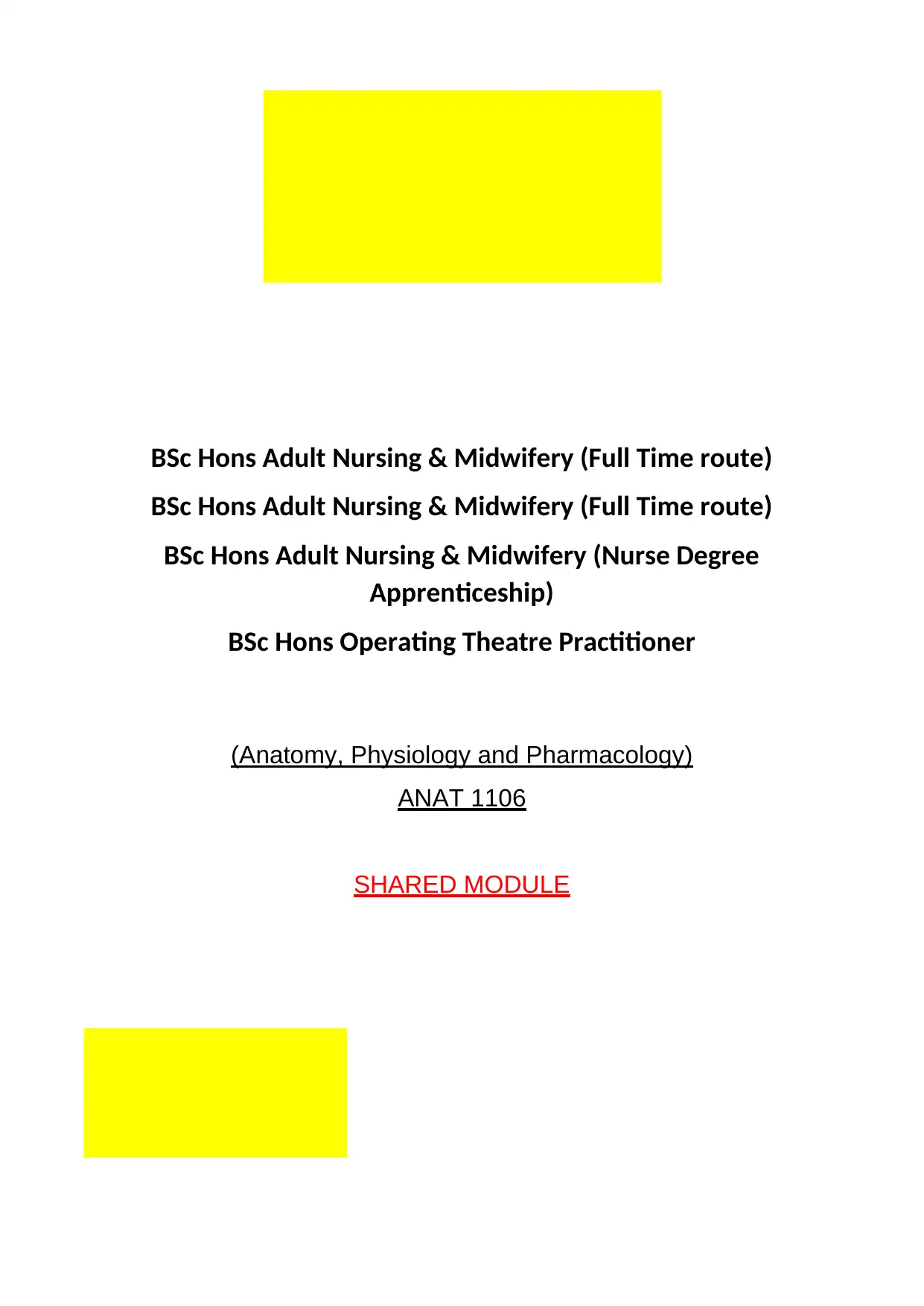
BSc Hons Adult Nursing & Midwifery (Full Time route)
BSc Hons Adult Nursing & Midwifery (Full Time route)
BSc Hons Adult Nursing & Midwifery (Nurse Degree
Apprenticeship)
BSc Hons Operating Theatre Practitioner
(Anatomy, Physiology and Pharmacology)
ANAT 1106
SHARED MODULE
BSc Hons Adult Nursing & Midwifery (Full Time route)
BSc Hons Adult Nursing & Midwifery (Nurse Degree
Apprenticeship)
BSc Hons Operating Theatre Practitioner
(Anatomy, Physiology and Pharmacology)
ANAT 1106
SHARED MODULE
Secure Best Marks with AI Grader
Need help grading? Try our AI Grader for instant feedback on your assignments.
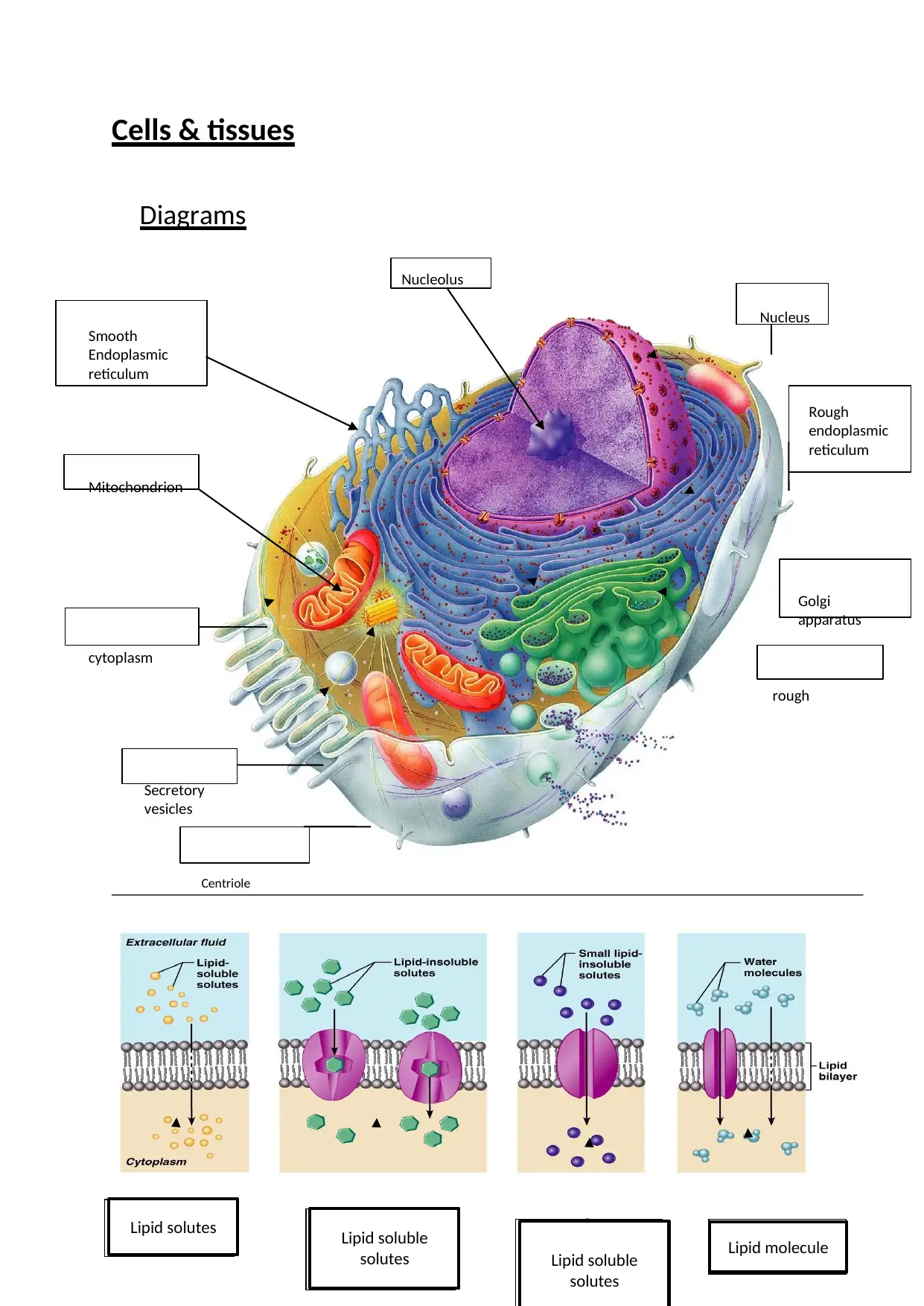
Cells & tissues
Diagrams
Nucleolus
Nucleus
Smooth
Endoplasmic
reticulum
Rough
endoplasmic
reticulum
Mitochondrion
Golgi
apparatus
cytoplasm
rough
Secretory
vesicles
Centriole
Lipid solutes Lipid soluble
solutes Lipid soluble
solutes
Lipid molecule
Diagrams
Nucleolus
Nucleus
Smooth
Endoplasmic
reticulum
Rough
endoplasmic
reticulum
Mitochondrion
Golgi
apparatus
cytoplasm
rough
Secretory
vesicles
Centriole
Lipid solutes Lipid soluble
solutes Lipid soluble
solutes
Lipid molecule

MCQ
1. How many pairs of chromosomes does the nucleus contain?
a. 46
b. 23
c. 21
d. 44
2. Mitochondria is.
a. the control centre of the cell
b. the production of protein
c. the powerhouse of the cell
d. the transport of materials
3. The cell membrane is made up of
a. single membrane
b. a double membrane
c. channel proteins
d. B and C
4. This type of cell division occurs in gamete production.
a. meiosis
b. mitosis
c. interphase
d. none of the above
5. Catabolism
a. builds complex molecules form simple molecules.
b. produces energy.
c. requires energy.
d. breaks down complex molecules in simple molecules.
e. A & B
f. C & B
1. How many pairs of chromosomes does the nucleus contain?
a. 46
b. 23
c. 21
d. 44
2. Mitochondria is.
a. the control centre of the cell
b. the production of protein
c. the powerhouse of the cell
d. the transport of materials
3. The cell membrane is made up of
a. single membrane
b. a double membrane
c. channel proteins
d. B and C
4. This type of cell division occurs in gamete production.
a. meiosis
b. mitosis
c. interphase
d. none of the above
5. Catabolism
a. builds complex molecules form simple molecules.
b. produces energy.
c. requires energy.
d. breaks down complex molecules in simple molecules.
e. A & B
f. C & B
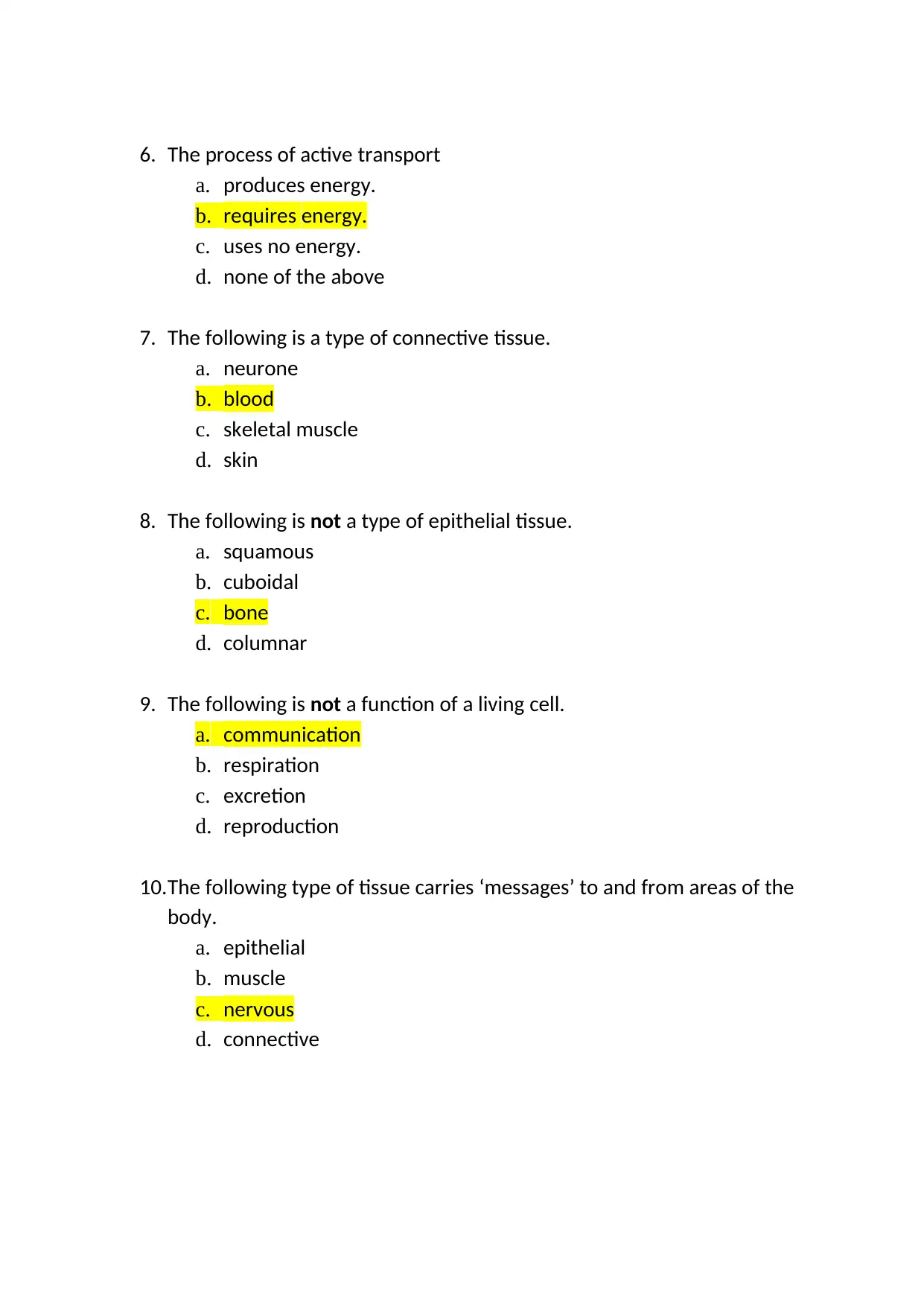
6. The process of active transport
a. produces energy.
b. requires energy.
c. uses no energy.
d. none of the above
7. The following is a type of connective tissue.
a. neurone
b. blood
c. skeletal muscle
d. skin
8. The following is not a type of epithelial tissue.
a. squamous
b. cuboidal
c. bone
d. columnar
9. The following is not a function of a living cell.
a. communication
b. respiration
c. excretion
d. reproduction
10.The following type of tissue carries ‘messages’ to and from areas of the
body.
a. epithelial
b. muscle
c. nervous
d. connective
a. produces energy.
b. requires energy.
c. uses no energy.
d. none of the above
7. The following is a type of connective tissue.
a. neurone
b. blood
c. skeletal muscle
d. skin
8. The following is not a type of epithelial tissue.
a. squamous
b. cuboidal
c. bone
d. columnar
9. The following is not a function of a living cell.
a. communication
b. respiration
c. excretion
d. reproduction
10.The following type of tissue carries ‘messages’ to and from areas of the
body.
a. epithelial
b. muscle
c. nervous
d. connective
Secure Best Marks with AI Grader
Need help grading? Try our AI Grader for instant feedback on your assignments.
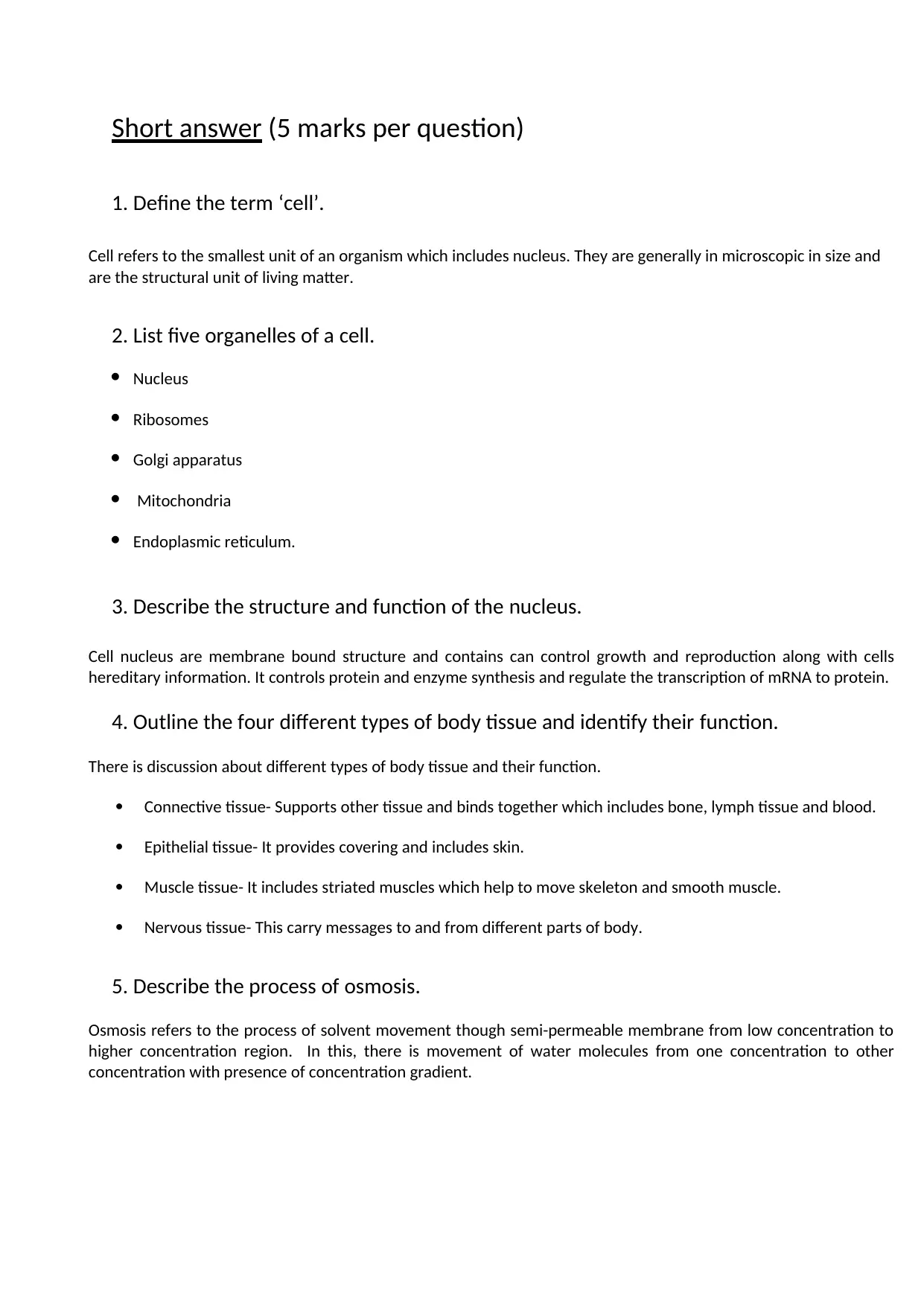
Short answer (5 marks per question)
1. Define the term ‘cell’.
Cell refers to the smallest unit of an organism which includes nucleus. They are generally in microscopic in size and
are the structural unit of living matter.
2. List five organelles of a cell.
Nucleus
Ribosomes
Golgi apparatus
Mitochondria
Endoplasmic reticulum.
3. Describe the structure and function of the nucleus.
Cell nucleus are membrane bound structure and contains can control growth and reproduction along with cells
hereditary information. It controls protein and enzyme synthesis and regulate the transcription of mRNA to protein.
4. Outline the four different types of body tissue and identify their function.
There is discussion about different types of body tissue and their function.
Connective tissue- Supports other tissue and binds together which includes bone, lymph tissue and blood.
Epithelial tissue- It provides covering and includes skin.
Muscle tissue- It includes striated muscles which help to move skeleton and smooth muscle.
Nervous tissue- This carry messages to and from different parts of body.
5. Describe the process of osmosis.
Osmosis refers to the process of solvent movement though semi-permeable membrane from low concentration to
higher concentration region. In this, there is movement of water molecules from one concentration to other
concentration with presence of concentration gradient.
1. Define the term ‘cell’.
Cell refers to the smallest unit of an organism which includes nucleus. They are generally in microscopic in size and
are the structural unit of living matter.
2. List five organelles of a cell.
Nucleus
Ribosomes
Golgi apparatus
Mitochondria
Endoplasmic reticulum.
3. Describe the structure and function of the nucleus.
Cell nucleus are membrane bound structure and contains can control growth and reproduction along with cells
hereditary information. It controls protein and enzyme synthesis and regulate the transcription of mRNA to protein.
4. Outline the four different types of body tissue and identify their function.
There is discussion about different types of body tissue and their function.
Connective tissue- Supports other tissue and binds together which includes bone, lymph tissue and blood.
Epithelial tissue- It provides covering and includes skin.
Muscle tissue- It includes striated muscles which help to move skeleton and smooth muscle.
Nervous tissue- This carry messages to and from different parts of body.
5. Describe the process of osmosis.
Osmosis refers to the process of solvent movement though semi-permeable membrane from low concentration to
higher concentration region. In this, there is movement of water molecules from one concentration to other
concentration with presence of concentration gradient.
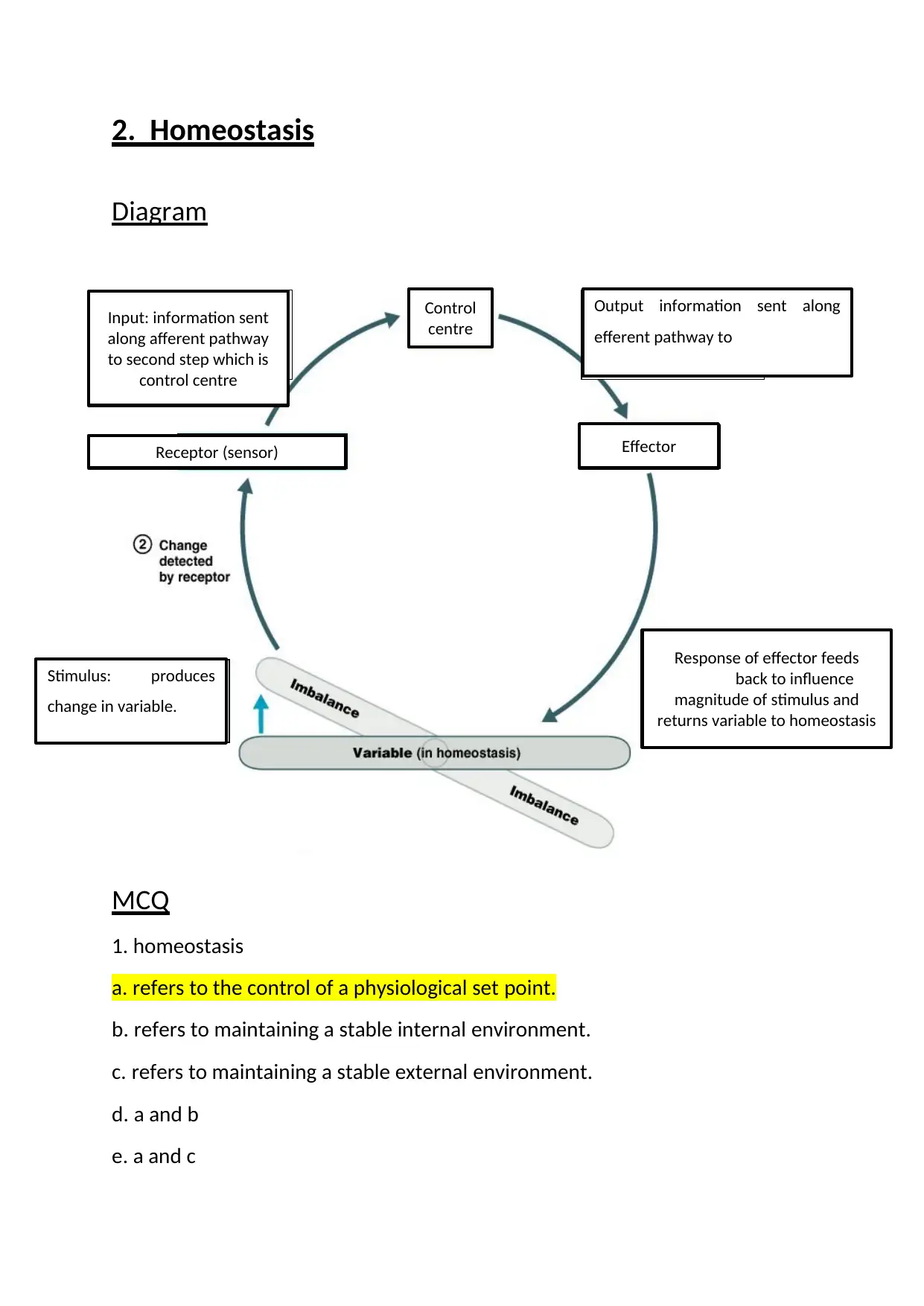
2. Homeostasis
Diagram
MCQ
1. homeostasis
a. refers to the control of a physiological set point.
b. refers to maintaining a stable internal environment.
c. refers to maintaining a stable external environment.
d. a and b
e. a and c
Input: information sent
along afferent pathway
to second step which is
control centre
Receptor (sensor)
Stimulus: produces
change in variable.
Control
centre
Output information sent along
efferent pathway to
Effector
Response of effector feeds
back to influence
magnitude of stimulus and
returns variable to homeostasis
Diagram
MCQ
1. homeostasis
a. refers to the control of a physiological set point.
b. refers to maintaining a stable internal environment.
c. refers to maintaining a stable external environment.
d. a and b
e. a and c
Input: information sent
along afferent pathway
to second step which is
control centre
Receptor (sensor)
Stimulus: produces
change in variable.
Control
centre
Output information sent along
efferent pathway to
Effector
Response of effector feeds
back to influence
magnitude of stimulus and
returns variable to homeostasis
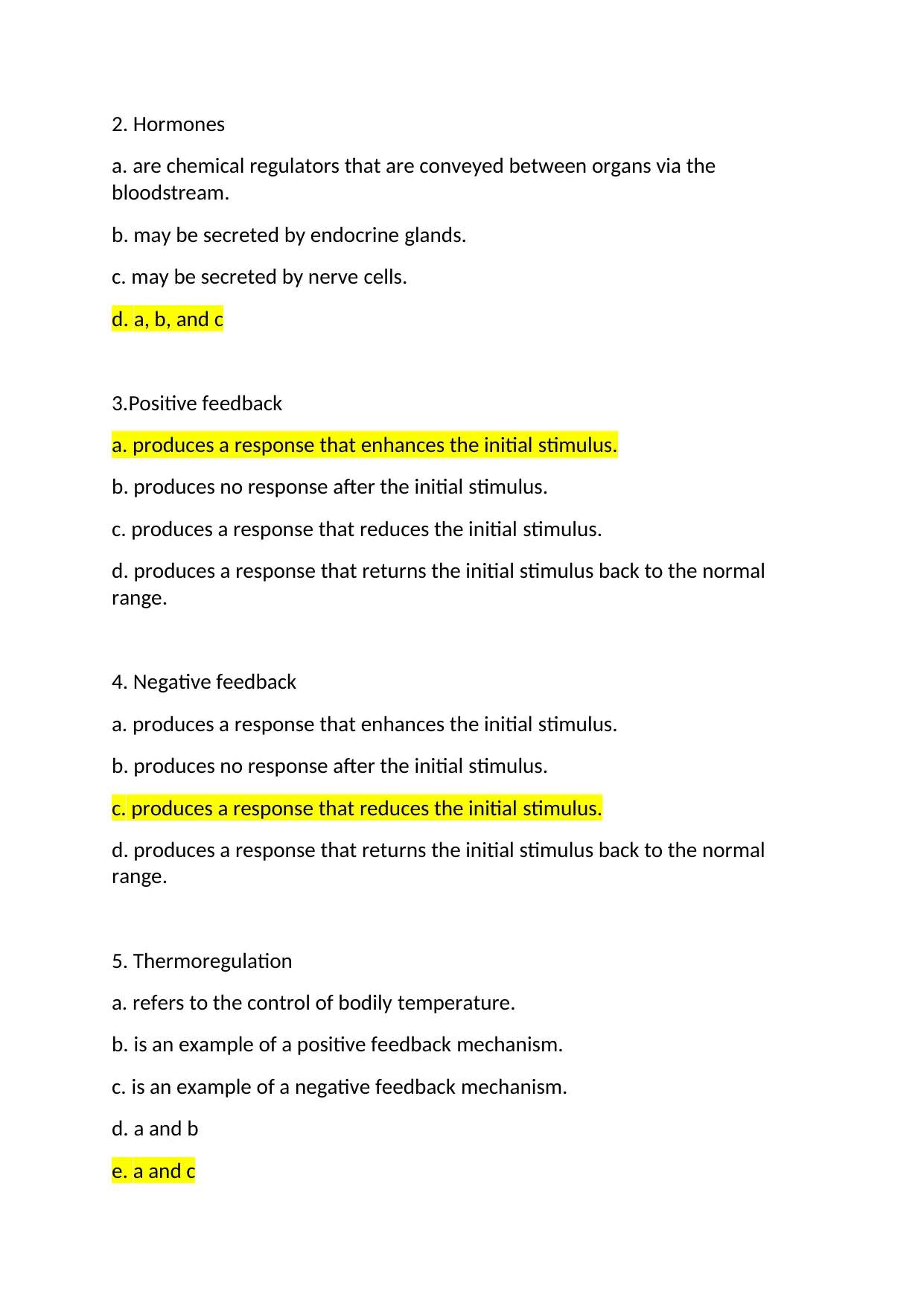
2. Hormones
a. are chemical regulators that are conveyed between organs via the
bloodstream.
b. may be secreted by endocrine glands.
c. may be secreted by nerve cells.
d. a, b, and c
3.Positive feedback
a. produces a response that enhances the initial stimulus.
b. produces no response after the initial stimulus.
c. produces a response that reduces the initial stimulus.
d. produces a response that returns the initial stimulus back to the normal
range.
4. Negative feedback
a. produces a response that enhances the initial stimulus.
b. produces no response after the initial stimulus.
c. produces a response that reduces the initial stimulus.
d. produces a response that returns the initial stimulus back to the normal
range.
5. Thermoregulation
a. refers to the control of bodily temperature.
b. is an example of a positive feedback mechanism.
c. is an example of a negative feedback mechanism.
d. a and b
e. a and c
a. are chemical regulators that are conveyed between organs via the
bloodstream.
b. may be secreted by endocrine glands.
c. may be secreted by nerve cells.
d. a, b, and c
3.Positive feedback
a. produces a response that enhances the initial stimulus.
b. produces no response after the initial stimulus.
c. produces a response that reduces the initial stimulus.
d. produces a response that returns the initial stimulus back to the normal
range.
4. Negative feedback
a. produces a response that enhances the initial stimulus.
b. produces no response after the initial stimulus.
c. produces a response that reduces the initial stimulus.
d. produces a response that returns the initial stimulus back to the normal
range.
5. Thermoregulation
a. refers to the control of bodily temperature.
b. is an example of a positive feedback mechanism.
c. is an example of a negative feedback mechanism.
d. a and b
e. a and c
Paraphrase This Document
Need a fresh take? Get an instant paraphrase of this document with our AI Paraphraser
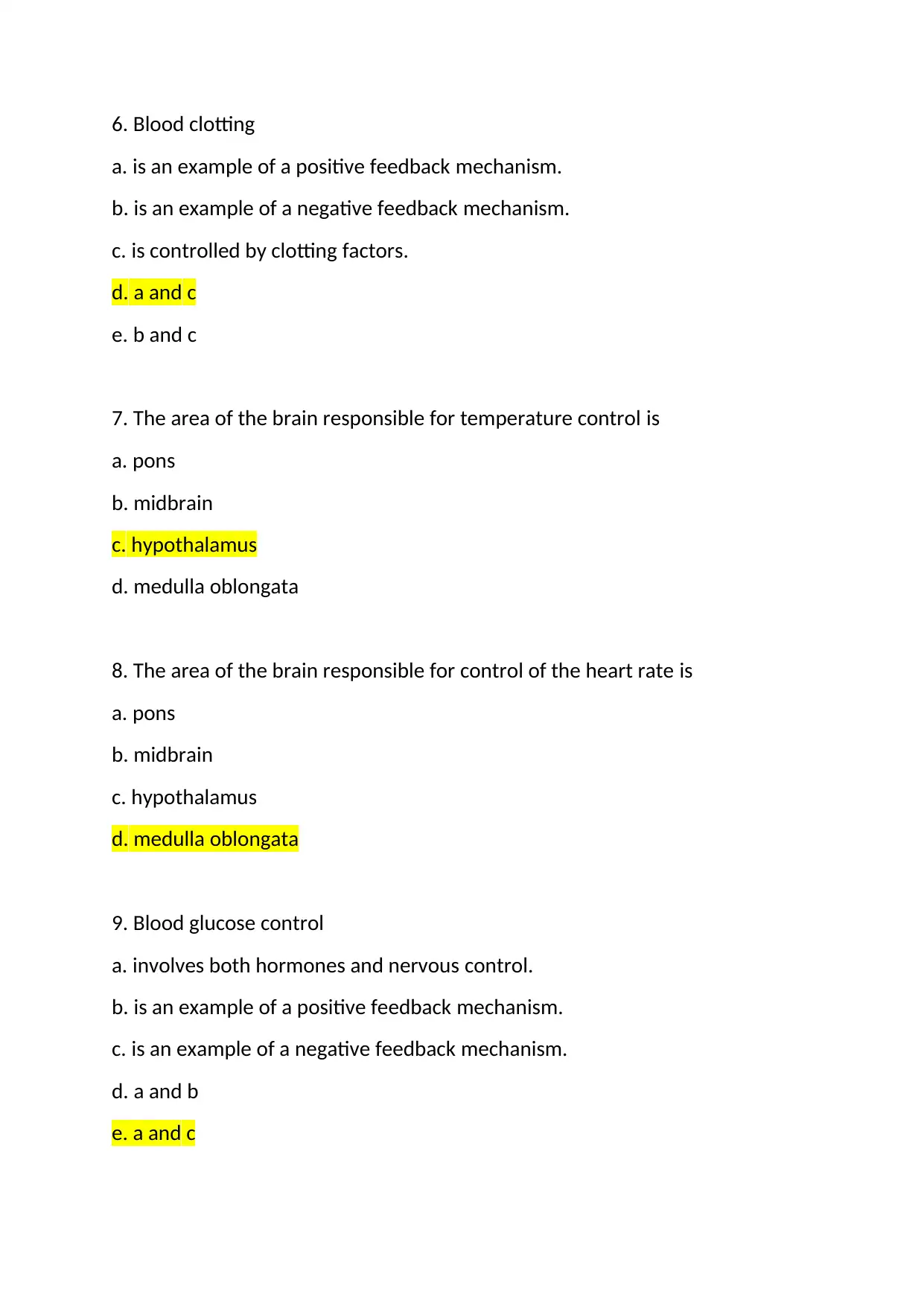
6. Blood clotting
a. is an example of a positive feedback mechanism.
b. is an example of a negative feedback mechanism.
c. is controlled by clotting factors.
d. a and c
e. b and c
7. The area of the brain responsible for temperature control is
a. pons
b. midbrain
c. hypothalamus
d. medulla oblongata
8. The area of the brain responsible for control of the heart rate is
a. pons
b. midbrain
c. hypothalamus
d. medulla oblongata
9. Blood glucose control
a. involves both hormones and nervous control.
b. is an example of a positive feedback mechanism.
c. is an example of a negative feedback mechanism.
d. a and b
e. a and c
a. is an example of a positive feedback mechanism.
b. is an example of a negative feedback mechanism.
c. is controlled by clotting factors.
d. a and c
e. b and c
7. The area of the brain responsible for temperature control is
a. pons
b. midbrain
c. hypothalamus
d. medulla oblongata
8. The area of the brain responsible for control of the heart rate is
a. pons
b. midbrain
c. hypothalamus
d. medulla oblongata
9. Blood glucose control
a. involves both hormones and nervous control.
b. is an example of a positive feedback mechanism.
c. is an example of a negative feedback mechanism.
d. a and b
e. a and c
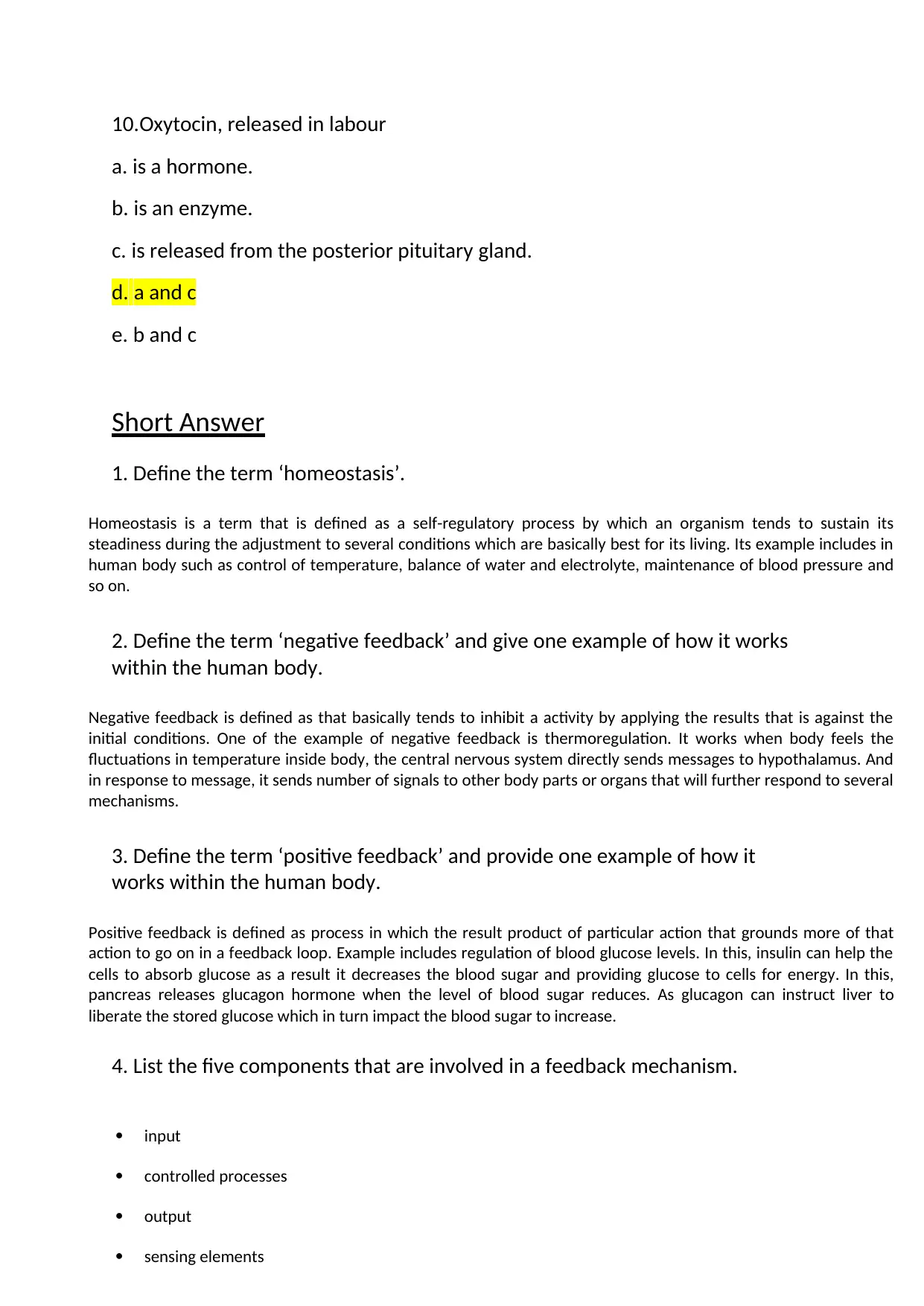
10.Oxytocin, released in labour
a. is a hormone.
b. is an enzyme.
c. is released from the posterior pituitary gland.
d. a and c
e. b and c
Short Answer
1. Define the term ‘homeostasis’.
Homeostasis is a term that is defined as a self-regulatory process by which an organism tends to sustain its
steadiness during the adjustment to several conditions which are basically best for its living. Its example includes in
human body such as control of temperature, balance of water and electrolyte, maintenance of blood pressure and
so on.
2. Define the term ‘negative feedback’ and give one example of how it works
within the human body.
Negative feedback is defined as that basically tends to inhibit a activity by applying the results that is against the
initial conditions. One of the example of negative feedback is thermoregulation. It works when body feels the
fluctuations in temperature inside body, the central nervous system directly sends messages to hypothalamus. And
in response to message, it sends number of signals to other body parts or organs that will further respond to several
mechanisms.
3. Define the term ‘positive feedback’ and provide one example of how it
works within the human body.
Positive feedback is defined as process in which the result product of particular action that grounds more of that
action to go on in a feedback loop. Example includes regulation of blood glucose levels. In this, insulin can help the
cells to absorb glucose as a result it decreases the blood sugar and providing glucose to cells for energy. In this,
pancreas releases glucagon hormone when the level of blood sugar reduces. As glucagon can instruct liver to
liberate the stored glucose which in turn impact the blood sugar to increase.
4. List the five components that are involved in a feedback mechanism.
input
controlled processes
output
sensing elements
a. is a hormone.
b. is an enzyme.
c. is released from the posterior pituitary gland.
d. a and c
e. b and c
Short Answer
1. Define the term ‘homeostasis’.
Homeostasis is a term that is defined as a self-regulatory process by which an organism tends to sustain its
steadiness during the adjustment to several conditions which are basically best for its living. Its example includes in
human body such as control of temperature, balance of water and electrolyte, maintenance of blood pressure and
so on.
2. Define the term ‘negative feedback’ and give one example of how it works
within the human body.
Negative feedback is defined as that basically tends to inhibit a activity by applying the results that is against the
initial conditions. One of the example of negative feedback is thermoregulation. It works when body feels the
fluctuations in temperature inside body, the central nervous system directly sends messages to hypothalamus. And
in response to message, it sends number of signals to other body parts or organs that will further respond to several
mechanisms.
3. Define the term ‘positive feedback’ and provide one example of how it
works within the human body.
Positive feedback is defined as process in which the result product of particular action that grounds more of that
action to go on in a feedback loop. Example includes regulation of blood glucose levels. In this, insulin can help the
cells to absorb glucose as a result it decreases the blood sugar and providing glucose to cells for energy. In this,
pancreas releases glucagon hormone when the level of blood sugar reduces. As glucagon can instruct liver to
liberate the stored glucose which in turn impact the blood sugar to increase.
4. List the five components that are involved in a feedback mechanism.
input
controlled processes
output
sensing elements
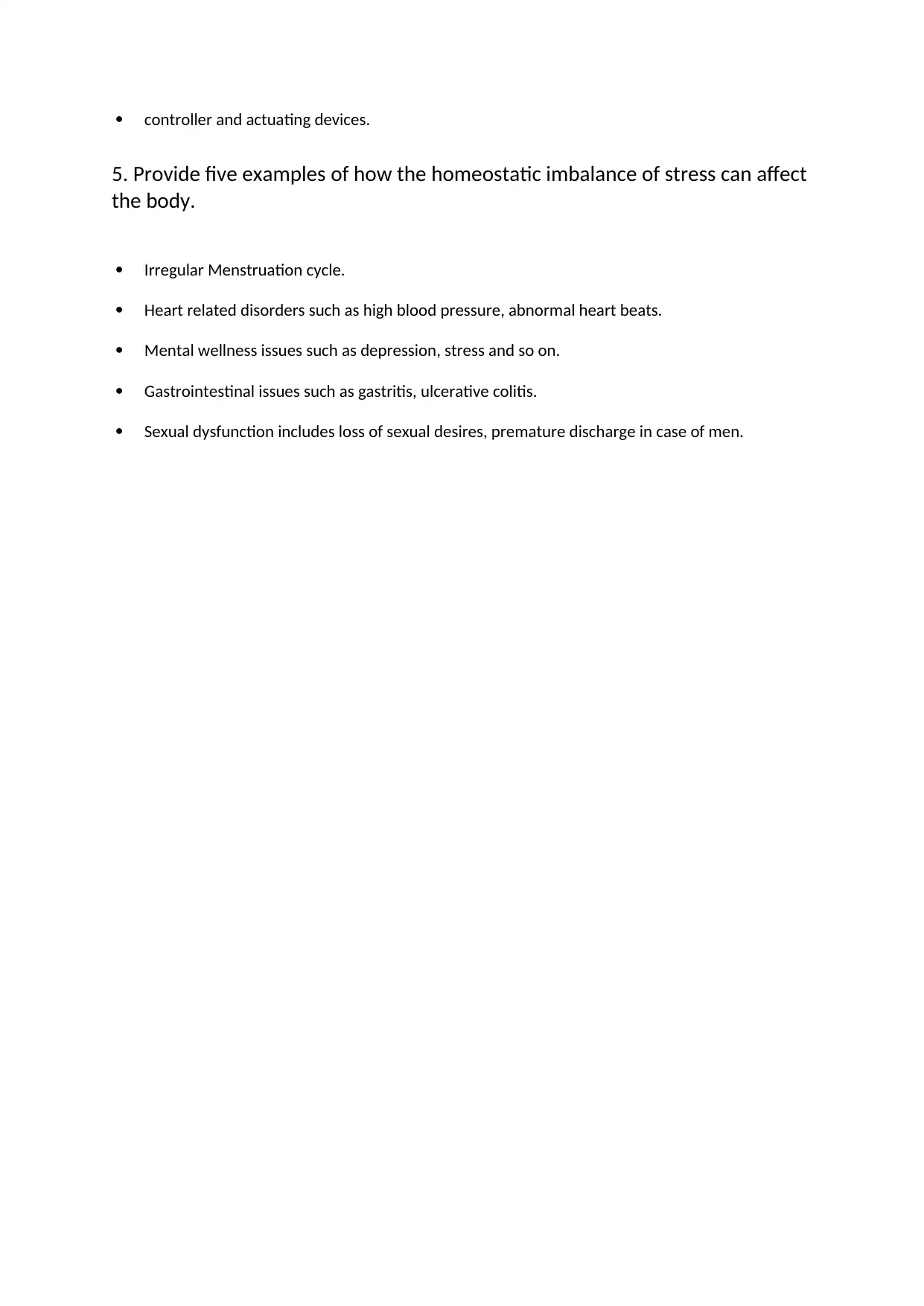
controller and actuating devices.
5. Provide five examples of how the homeostatic imbalance of stress can affect
the body.
Irregular Menstruation cycle.
Heart related disorders such as high blood pressure, abnormal heart beats.
Mental wellness issues such as depression, stress and so on.
Gastrointestinal issues such as gastritis, ulcerative colitis.
Sexual dysfunction includes loss of sexual desires, premature discharge in case of men.
5. Provide five examples of how the homeostatic imbalance of stress can affect
the body.
Irregular Menstruation cycle.
Heart related disorders such as high blood pressure, abnormal heart beats.
Mental wellness issues such as depression, stress and so on.
Gastrointestinal issues such as gastritis, ulcerative colitis.
Sexual dysfunction includes loss of sexual desires, premature discharge in case of men.
Secure Best Marks with AI Grader
Need help grading? Try our AI Grader for instant feedback on your assignments.
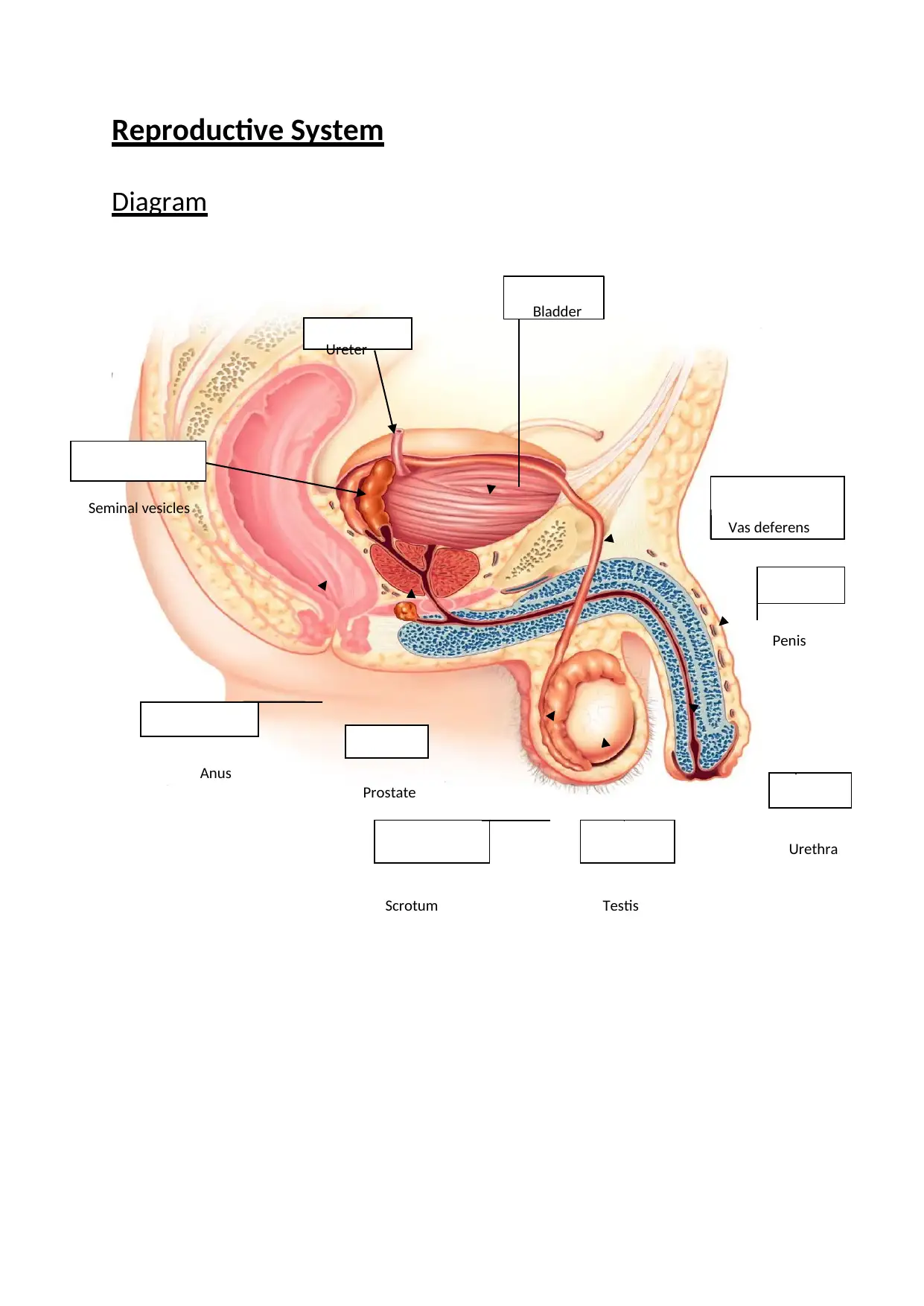
Reproductive System
Diagram
Bladder
Ureter
Seminal vesicles
Vas deferens
Penis
Anus
Prostate
Urethra
Scrotum Testis
Diagram
Bladder
Ureter
Seminal vesicles
Vas deferens
Penis
Anus
Prostate
Urethra
Scrotum Testis
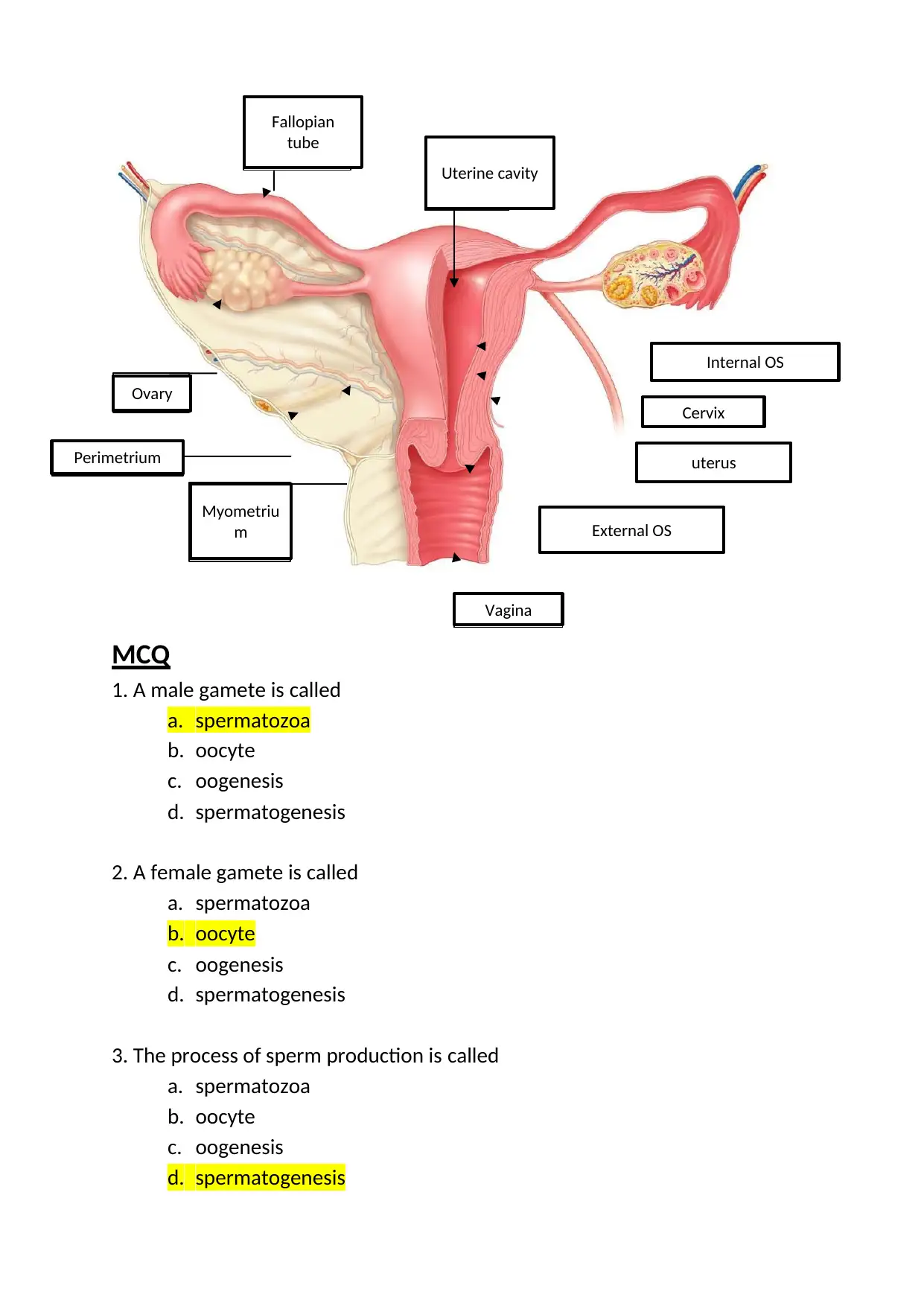
MCQ
1. A male gamete is called
a. spermatozoa
b. oocyte
c. oogenesis
d. spermatogenesis
2. A female gamete is called
a. spermatozoa
b. oocyte
c. oogenesis
d. spermatogenesis
3. The process of sperm production is called
a. spermatozoa
b. oocyte
c. oogenesis
d. spermatogenesis
Fallopian
tube
Uterine cavity
Ovary
Myometriu
m
Perimetrium
Vagina
External OS
Cervix
Internal OS
uterus
1. A male gamete is called
a. spermatozoa
b. oocyte
c. oogenesis
d. spermatogenesis
2. A female gamete is called
a. spermatozoa
b. oocyte
c. oogenesis
d. spermatogenesis
3. The process of sperm production is called
a. spermatozoa
b. oocyte
c. oogenesis
d. spermatogenesis
Fallopian
tube
Uterine cavity
Ovary
Myometriu
m
Perimetrium
Vagina
External OS
Cervix
Internal OS
uterus

4. Sperm is produced in the
a. epididymis
b. prostate
c. tubules
d. ductus deferens
5. Spermatogenesis and Oogenesis occurs by the process of
a. meiosis
b. mitosis
c. both a and b
d. none of the above
6. The following is a male sex hormone
a. follicle stimulating hormone.
b. luteinising hormone
c. testosterone
d. progesterone
7. The normal female has how many functioning ovaries?
a. 1
b. 2
c. 3
d. 4
8. The normal menstrual cycle lasts how many days?
a. 26
b. 27
c. 28
d. 29
9. The following are female sex hormones
a. progesterone
b. testosterone
c. oestrogen
d. a and c
a. epididymis
b. prostate
c. tubules
d. ductus deferens
5. Spermatogenesis and Oogenesis occurs by the process of
a. meiosis
b. mitosis
c. both a and b
d. none of the above
6. The following is a male sex hormone
a. follicle stimulating hormone.
b. luteinising hormone
c. testosterone
d. progesterone
7. The normal female has how many functioning ovaries?
a. 1
b. 2
c. 3
d. 4
8. The normal menstrual cycle lasts how many days?
a. 26
b. 27
c. 28
d. 29
9. The following are female sex hormones
a. progesterone
b. testosterone
c. oestrogen
d. a and c
Paraphrase This Document
Need a fresh take? Get an instant paraphrase of this document with our AI Paraphraser
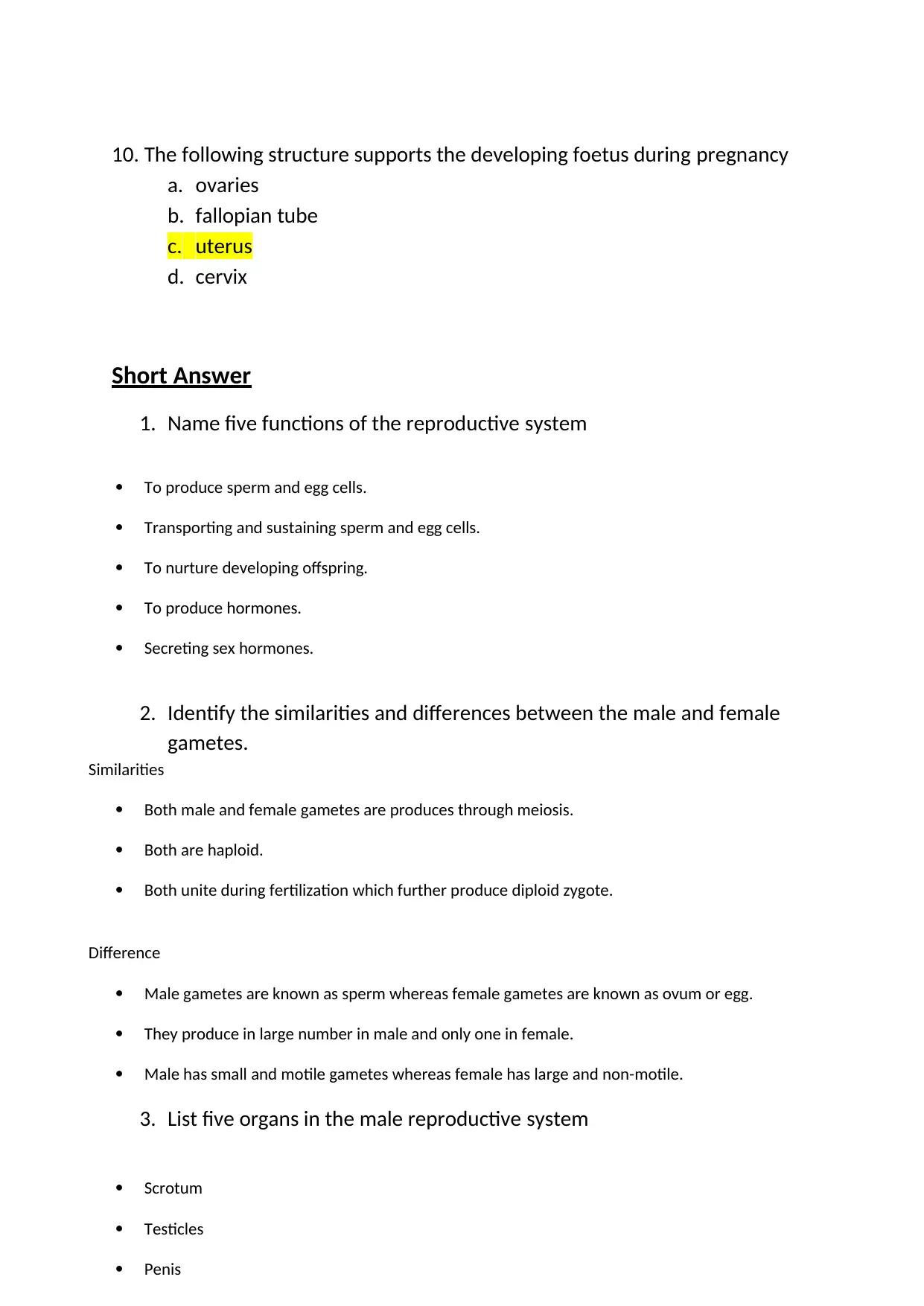
10. The following structure supports the developing foetus during pregnancy
a. ovaries
b. fallopian tube
c. uterus
d. cervix
Short Answer
1. Name five functions of the reproductive system
To produce sperm and egg cells.
Transporting and sustaining sperm and egg cells.
To nurture developing offspring.
To produce hormones.
Secreting sex hormones.
2. Identify the similarities and differences between the male and female
gametes.
Similarities
Both male and female gametes are produces through meiosis.
Both are haploid.
Both unite during fertilization which further produce diploid zygote.
Difference
Male gametes are known as sperm whereas female gametes are known as ovum or egg.
They produce in large number in male and only one in female.
Male has small and motile gametes whereas female has large and non-motile.
3. List five organs in the male reproductive system
Scrotum
Testicles
Penis
a. ovaries
b. fallopian tube
c. uterus
d. cervix
Short Answer
1. Name five functions of the reproductive system
To produce sperm and egg cells.
Transporting and sustaining sperm and egg cells.
To nurture developing offspring.
To produce hormones.
Secreting sex hormones.
2. Identify the similarities and differences between the male and female
gametes.
Similarities
Both male and female gametes are produces through meiosis.
Both are haploid.
Both unite during fertilization which further produce diploid zygote.
Difference
Male gametes are known as sperm whereas female gametes are known as ovum or egg.
They produce in large number in male and only one in female.
Male has small and motile gametes whereas female has large and non-motile.
3. List five organs in the male reproductive system
Scrotum
Testicles
Penis

Seminal vesicle
Urethra
4. Describe the three phases of the uterine cycle.
Menses
Proliferative
Secretory
5. List five the male and female sex hormones
Estrogen
Progesterone
Testosterone
Androgens
Luteinizing hormone
Genetics
Urethra
4. Describe the three phases of the uterine cycle.
Menses
Proliferative
Secretory
5. List five the male and female sex hormones
Estrogen
Progesterone
Testosterone
Androgens
Luteinizing hormone
Genetics
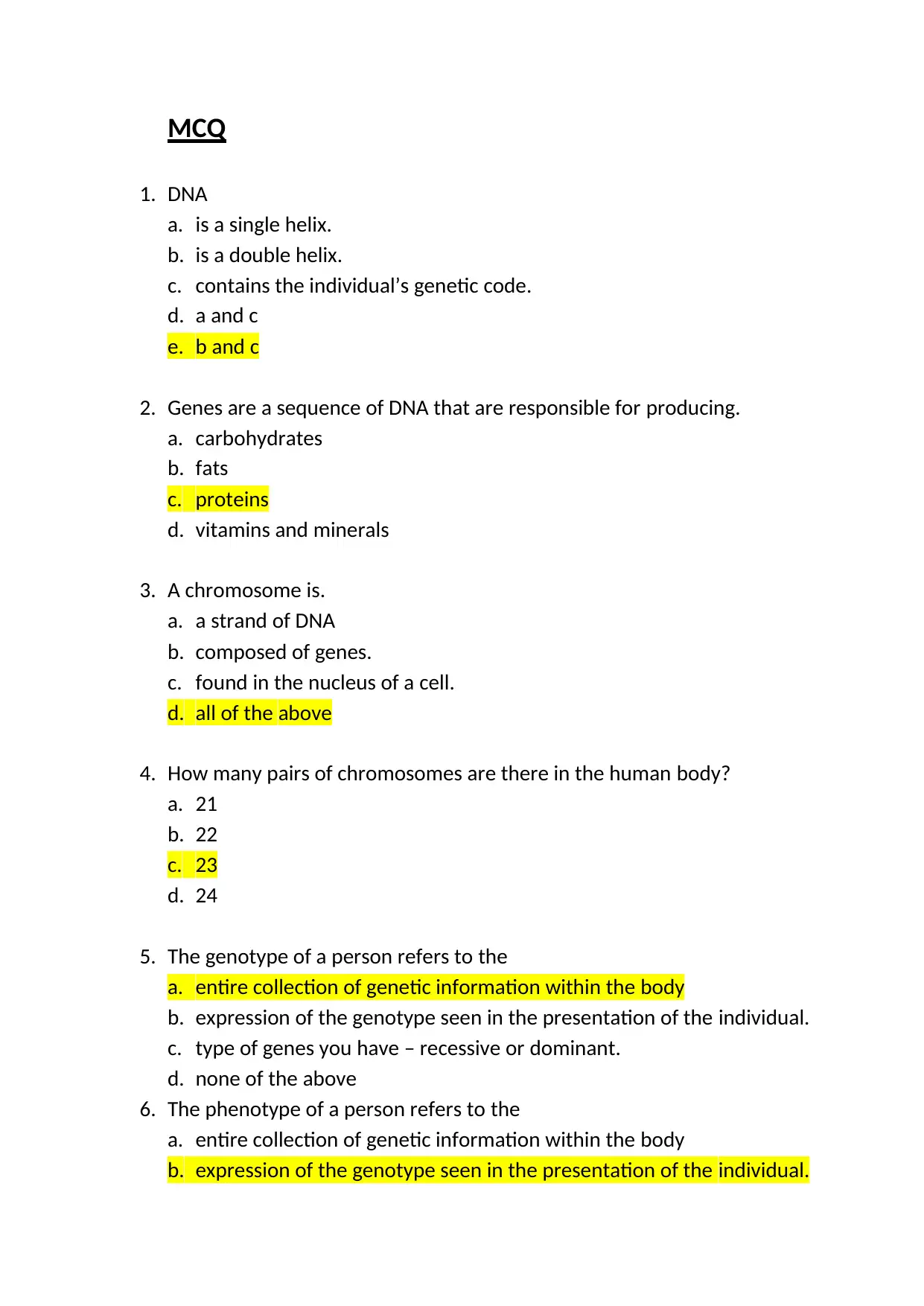
MCQ
1. DNA
a. is a single helix.
b. is a double helix.
c. contains the individual’s genetic code.
d. a and c
e. b and c
2. Genes are a sequence of DNA that are responsible for producing.
a. carbohydrates
b. fats
c. proteins
d. vitamins and minerals
3. A chromosome is.
a. a strand of DNA
b. composed of genes.
c. found in the nucleus of a cell.
d. all of the above
4. How many pairs of chromosomes are there in the human body?
a. 21
b. 22
c. 23
d. 24
5. The genotype of a person refers to the
a. entire collection of genetic information within the body
b. expression of the genotype seen in the presentation of the individual.
c. type of genes you have – recessive or dominant.
d. none of the above
6. The phenotype of a person refers to the
a. entire collection of genetic information within the body
b. expression of the genotype seen in the presentation of the individual.
1. DNA
a. is a single helix.
b. is a double helix.
c. contains the individual’s genetic code.
d. a and c
e. b and c
2. Genes are a sequence of DNA that are responsible for producing.
a. carbohydrates
b. fats
c. proteins
d. vitamins and minerals
3. A chromosome is.
a. a strand of DNA
b. composed of genes.
c. found in the nucleus of a cell.
d. all of the above
4. How many pairs of chromosomes are there in the human body?
a. 21
b. 22
c. 23
d. 24
5. The genotype of a person refers to the
a. entire collection of genetic information within the body
b. expression of the genotype seen in the presentation of the individual.
c. type of genes you have – recessive or dominant.
d. none of the above
6. The phenotype of a person refers to the
a. entire collection of genetic information within the body
b. expression of the genotype seen in the presentation of the individual.
Secure Best Marks with AI Grader
Need help grading? Try our AI Grader for instant feedback on your assignments.
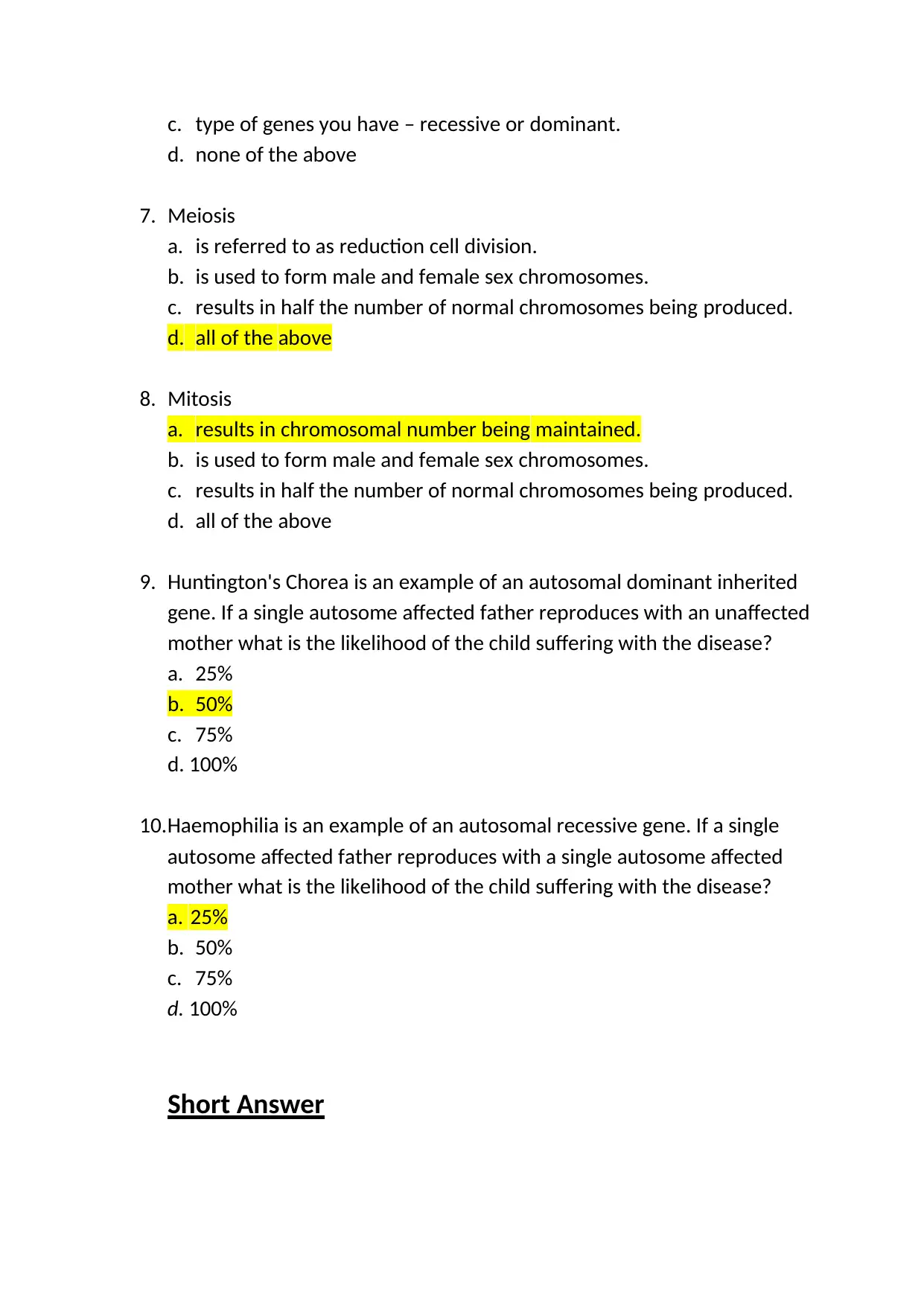
c. type of genes you have – recessive or dominant.
d. none of the above
7. Meiosis
a. is referred to as reduction cell division.
b. is used to form male and female sex chromosomes.
c. results in half the number of normal chromosomes being produced.
d. all of the above
8. Mitosis
a. results in chromosomal number being maintained.
b. is used to form male and female sex chromosomes.
c. results in half the number of normal chromosomes being produced.
d. all of the above
9. Huntington's Chorea is an example of an autosomal dominant inherited
gene. If a single autosome affected father reproduces with an unaffected
mother what is the likelihood of the child suffering with the disease?
a. 25%
b. 50%
c. 75%
d. 100%
10.Haemophilia is an example of an autosomal recessive gene. If a single
autosome affected father reproduces with a single autosome affected
mother what is the likelihood of the child suffering with the disease?
a. 25%
b. 50%
c. 75%
d. 100%
Short Answer
d. none of the above
7. Meiosis
a. is referred to as reduction cell division.
b. is used to form male and female sex chromosomes.
c. results in half the number of normal chromosomes being produced.
d. all of the above
8. Mitosis
a. results in chromosomal number being maintained.
b. is used to form male and female sex chromosomes.
c. results in half the number of normal chromosomes being produced.
d. all of the above
9. Huntington's Chorea is an example of an autosomal dominant inherited
gene. If a single autosome affected father reproduces with an unaffected
mother what is the likelihood of the child suffering with the disease?
a. 25%
b. 50%
c. 75%
d. 100%
10.Haemophilia is an example of an autosomal recessive gene. If a single
autosome affected father reproduces with a single autosome affected
mother what is the likelihood of the child suffering with the disease?
a. 25%
b. 50%
c. 75%
d. 100%
Short Answer
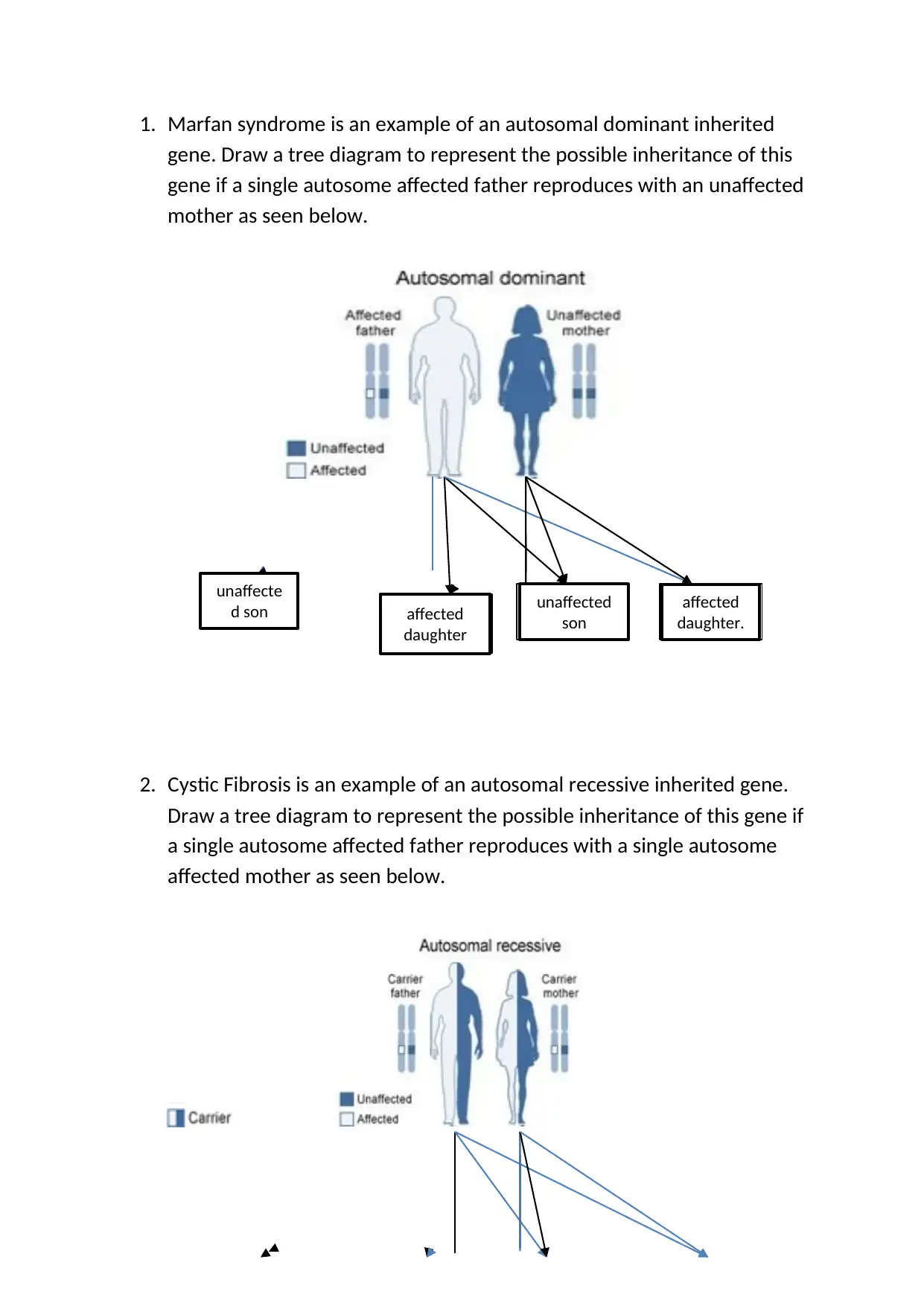
1. Marfan syndrome is an example of an autosomal dominant inherited
gene. Draw a tree diagram to represent the possible inheritance of this
gene if a single autosome affected father reproduces with an unaffected
mother as seen below.
2. Cystic Fibrosis is an example of an autosomal recessive inherited gene.
Draw a tree diagram to represent the possible inheritance of this gene if
a single autosome affected father reproduces with a single autosome
affected mother as seen below.
unaffecte
d son affected
daughter
unaffected
son
affected
daughter.
gene. Draw a tree diagram to represent the possible inheritance of this
gene if a single autosome affected father reproduces with an unaffected
mother as seen below.
2. Cystic Fibrosis is an example of an autosomal recessive inherited gene.
Draw a tree diagram to represent the possible inheritance of this gene if
a single autosome affected father reproduces with a single autosome
affected mother as seen below.
unaffecte
d son affected
daughter
unaffected
son
affected
daughter.

3. Identify 5 risk factors that can influence an individual’s genes and
disease.
It includes genetic make-up, exposure to harmful materials, age, the environmental factors.
unaffected
son
carrier
daughter carrier son affected
daughter.
disease.
It includes genetic make-up, exposure to harmful materials, age, the environmental factors.
unaffected
son
carrier
daughter carrier son affected
daughter.
Paraphrase This Document
Need a fresh take? Get an instant paraphrase of this document with our AI Paraphraser
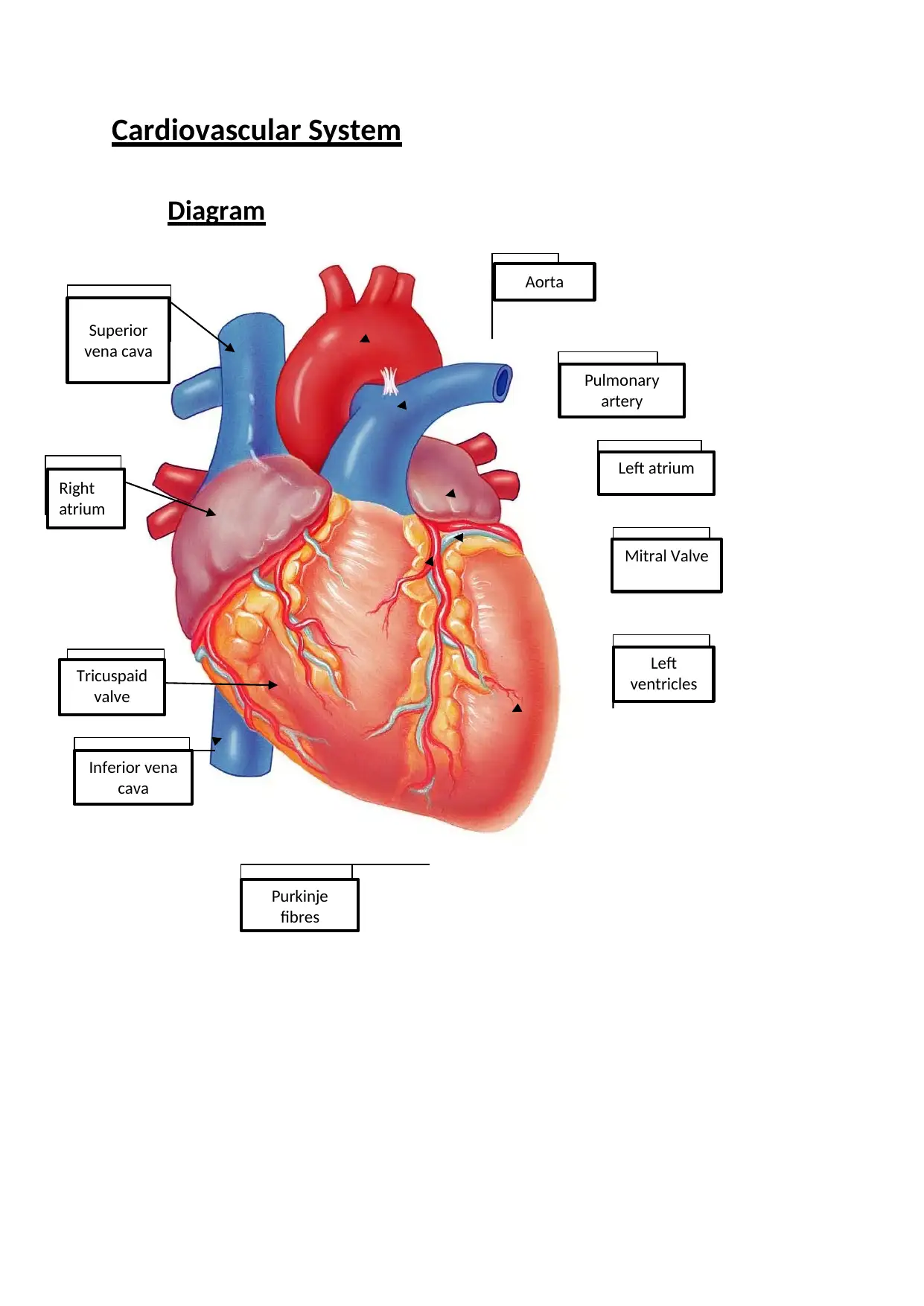
Cardiovascular System
Diagram
Superior
vena cava
Aorta
Pulmonary
artery
Left atrium
Mitral Valve
Left
ventricles
Right
atrium
Tricuspaid
valve
Inferior vena
cava
Purkinje
fibres
Diagram
Superior
vena cava
Aorta
Pulmonary
artery
Left atrium
Mitral Valve
Left
ventricles
Right
atrium
Tricuspaid
valve
Inferior vena
cava
Purkinje
fibres
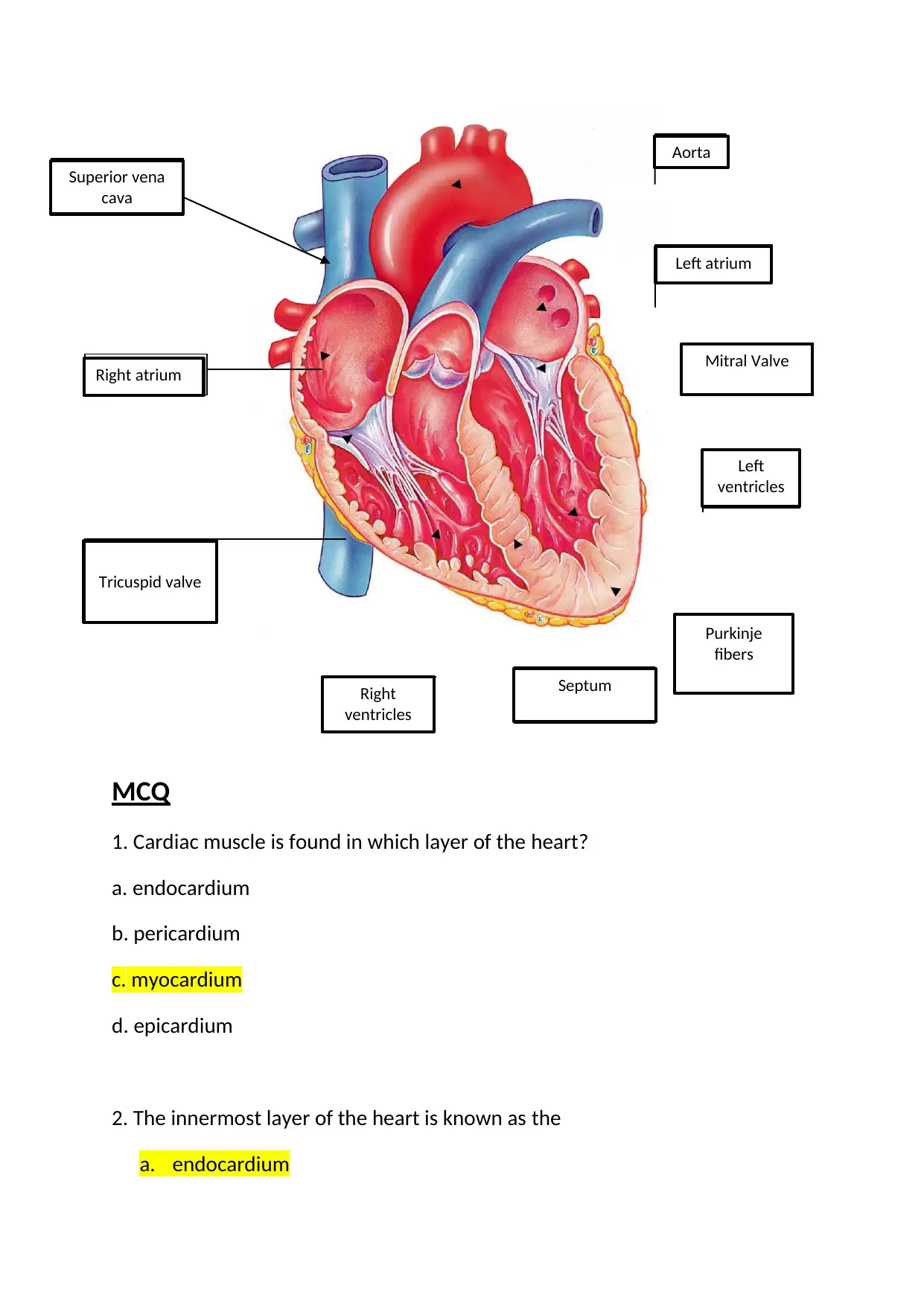
MCQ
1. Cardiac muscle is found in which layer of the heart?
a. endocardium
b. pericardium
c. myocardium
d. epicardium
2. The innermost layer of the heart is known as the
a. endocardium
Superior vena
cava
Right atrium
Tricuspid valve
Right
ventricles
Septum
Purkinje
fibers
Left
ventricles
Mitral Valve
Left atrium
Aorta
1. Cardiac muscle is found in which layer of the heart?
a. endocardium
b. pericardium
c. myocardium
d. epicardium
2. The innermost layer of the heart is known as the
a. endocardium
Superior vena
cava
Right atrium
Tricuspid valve
Right
ventricles
Septum
Purkinje
fibers
Left
ventricles
Mitral Valve
Left atrium
Aorta
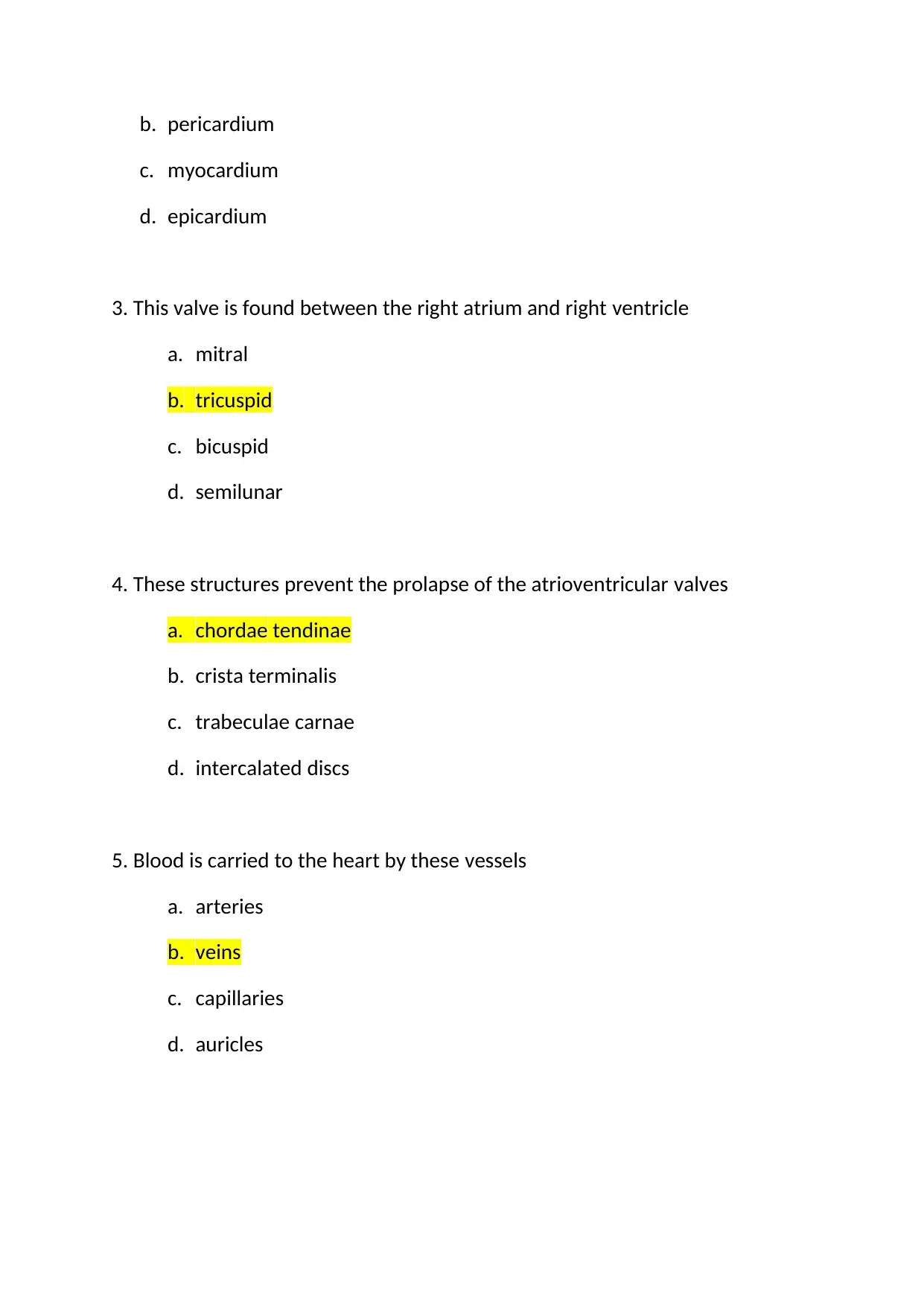
b. pericardium
c. myocardium
d. epicardium
3. This valve is found between the right atrium and right ventricle
a. mitral
b. tricuspid
c. bicuspid
d. semilunar
4. These structures prevent the prolapse of the atrioventricular valves
a. chordae tendinae
b. crista terminalis
c. trabeculae carnae
d. intercalated discs
5. Blood is carried to the heart by these vessels
a. arteries
b. veins
c. capillaries
d. auricles
c. myocardium
d. epicardium
3. This valve is found between the right atrium and right ventricle
a. mitral
b. tricuspid
c. bicuspid
d. semilunar
4. These structures prevent the prolapse of the atrioventricular valves
a. chordae tendinae
b. crista terminalis
c. trabeculae carnae
d. intercalated discs
5. Blood is carried to the heart by these vessels
a. arteries
b. veins
c. capillaries
d. auricles
Secure Best Marks with AI Grader
Need help grading? Try our AI Grader for instant feedback on your assignments.
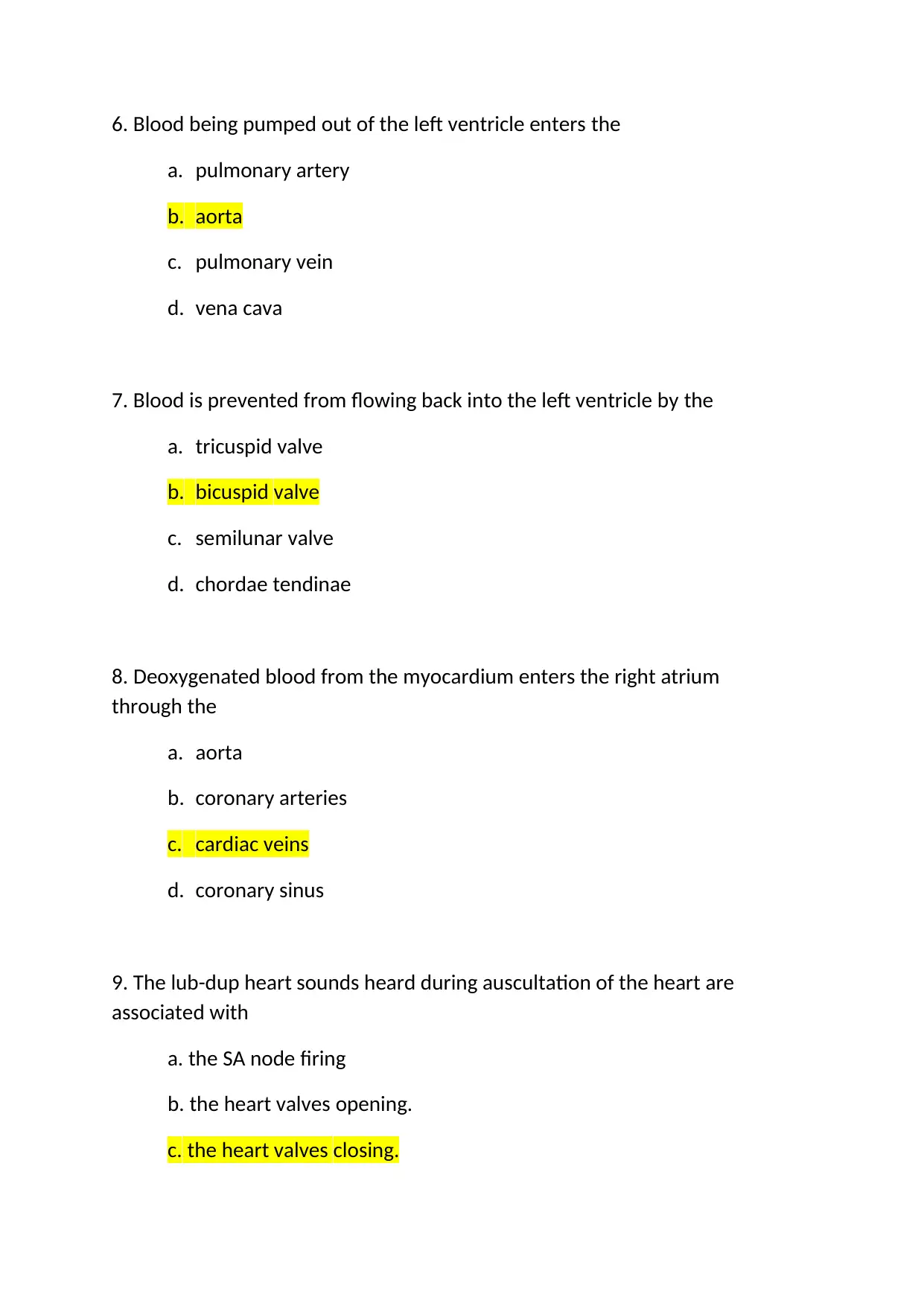
6. Blood being pumped out of the left ventricle enters the
a. pulmonary artery
b. aorta
c. pulmonary vein
d. vena cava
7. Blood is prevented from flowing back into the left ventricle by the
a. tricuspid valve
b. bicuspid valve
c. semilunar valve
d. chordae tendinae
8. Deoxygenated blood from the myocardium enters the right atrium
through the
a. aorta
b. coronary arteries
c. cardiac veins
d. coronary sinus
9. The lub-dup heart sounds heard during auscultation of the heart are
associated with
a. the SA node firing
b. the heart valves opening.
c. the heart valves closing.
a. pulmonary artery
b. aorta
c. pulmonary vein
d. vena cava
7. Blood is prevented from flowing back into the left ventricle by the
a. tricuspid valve
b. bicuspid valve
c. semilunar valve
d. chordae tendinae
8. Deoxygenated blood from the myocardium enters the right atrium
through the
a. aorta
b. coronary arteries
c. cardiac veins
d. coronary sinus
9. The lub-dup heart sounds heard during auscultation of the heart are
associated with
a. the SA node firing
b. the heart valves opening.
c. the heart valves closing.
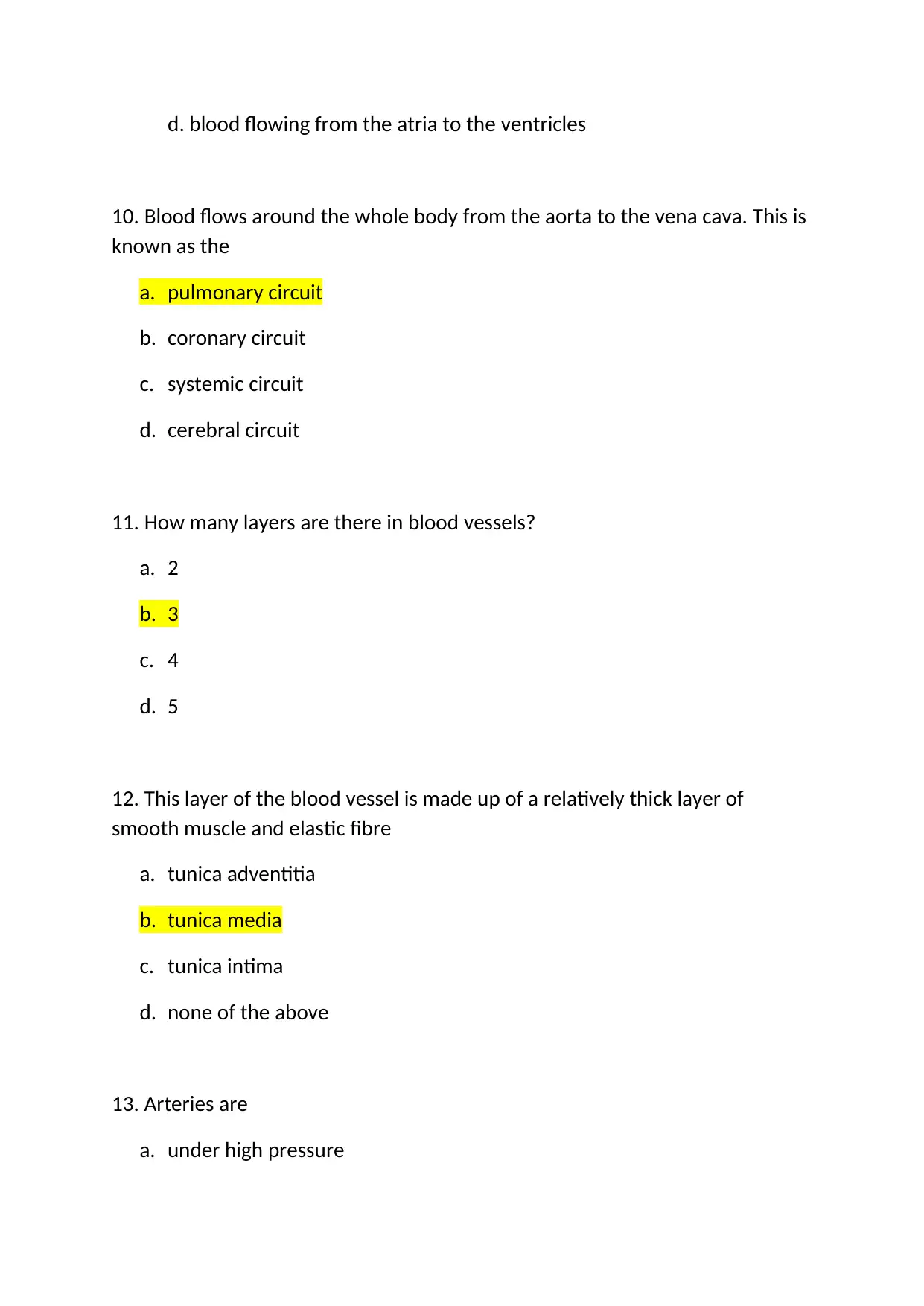
d. blood flowing from the atria to the ventricles
10. Blood flows around the whole body from the aorta to the vena cava. This is
known as the
a. pulmonary circuit
b. coronary circuit
c. systemic circuit
d. cerebral circuit
11. How many layers are there in blood vessels?
a. 2
b. 3
c. 4
d. 5
12. This layer of the blood vessel is made up of a relatively thick layer of
smooth muscle and elastic fibre
a. tunica adventitia
b. tunica media
c. tunica intima
d. none of the above
13. Arteries are
a. under high pressure
10. Blood flows around the whole body from the aorta to the vena cava. This is
known as the
a. pulmonary circuit
b. coronary circuit
c. systemic circuit
d. cerebral circuit
11. How many layers are there in blood vessels?
a. 2
b. 3
c. 4
d. 5
12. This layer of the blood vessel is made up of a relatively thick layer of
smooth muscle and elastic fibre
a. tunica adventitia
b. tunica media
c. tunica intima
d. none of the above
13. Arteries are
a. under high pressure
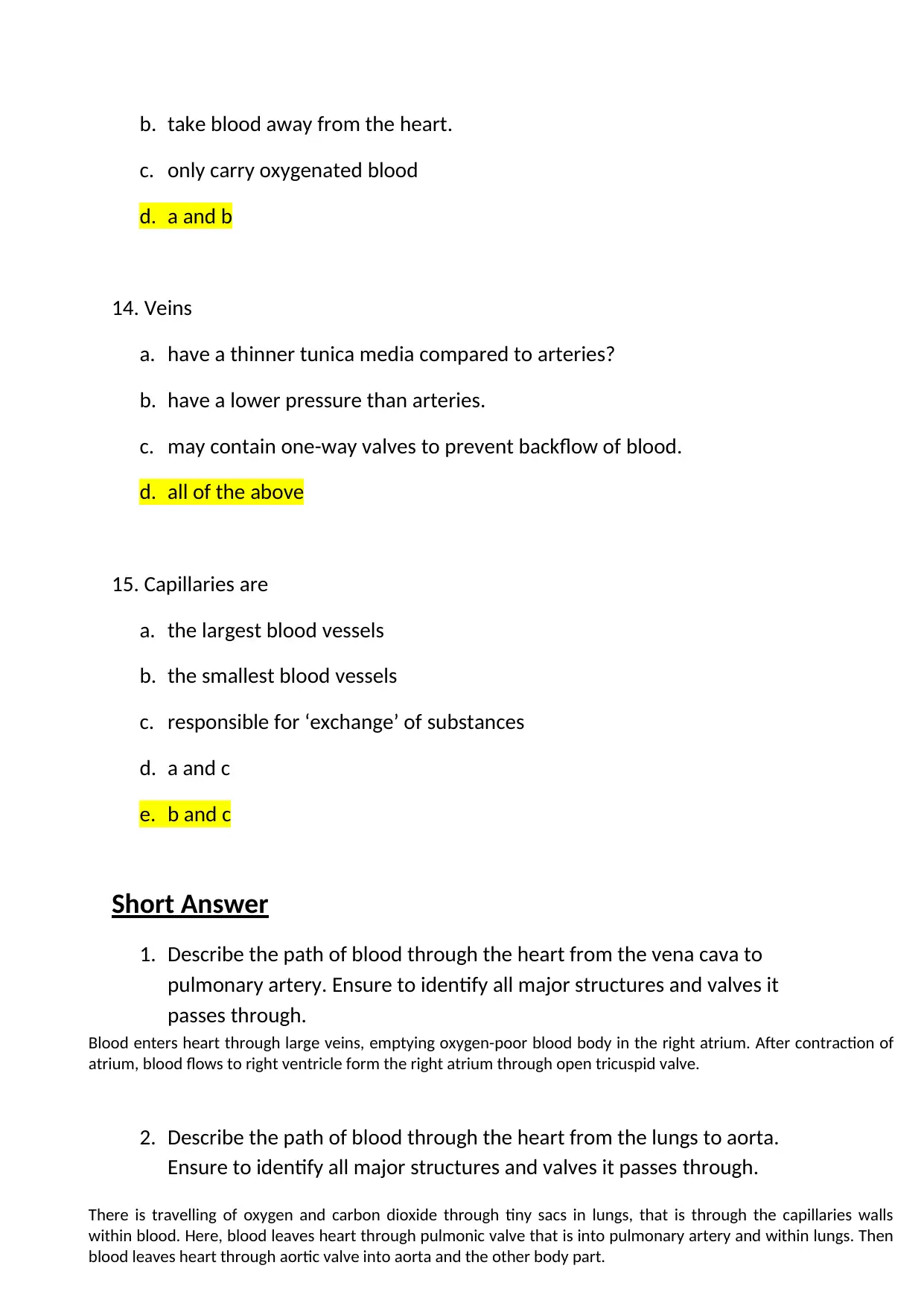
b. take blood away from the heart.
c. only carry oxygenated blood
d. a and b
14. Veins
a. have a thinner tunica media compared to arteries?
b. have a lower pressure than arteries.
c. may contain one-way valves to prevent backflow of blood.
d. all of the above
15. Capillaries are
a. the largest blood vessels
b. the smallest blood vessels
c. responsible for ‘exchange’ of substances
d. a and c
e. b and c
Short Answer
1. Describe the path of blood through the heart from the vena cava to
pulmonary artery. Ensure to identify all major structures and valves it
passes through.
Blood enters heart through large veins, emptying oxygen-poor blood body in the right atrium. After contraction of
atrium, blood flows to right ventricle form the right atrium through open tricuspid valve.
2. Describe the path of blood through the heart from the lungs to aorta.
Ensure to identify all major structures and valves it passes through.
There is travelling of oxygen and carbon dioxide through tiny sacs in lungs, that is through the capillaries walls
within blood. Here, blood leaves heart through pulmonic valve that is into pulmonary artery and within lungs. Then
blood leaves heart through aortic valve into aorta and the other body part.
c. only carry oxygenated blood
d. a and b
14. Veins
a. have a thinner tunica media compared to arteries?
b. have a lower pressure than arteries.
c. may contain one-way valves to prevent backflow of blood.
d. all of the above
15. Capillaries are
a. the largest blood vessels
b. the smallest blood vessels
c. responsible for ‘exchange’ of substances
d. a and c
e. b and c
Short Answer
1. Describe the path of blood through the heart from the vena cava to
pulmonary artery. Ensure to identify all major structures and valves it
passes through.
Blood enters heart through large veins, emptying oxygen-poor blood body in the right atrium. After contraction of
atrium, blood flows to right ventricle form the right atrium through open tricuspid valve.
2. Describe the path of blood through the heart from the lungs to aorta.
Ensure to identify all major structures and valves it passes through.
There is travelling of oxygen and carbon dioxide through tiny sacs in lungs, that is through the capillaries walls
within blood. Here, blood leaves heart through pulmonic valve that is into pulmonary artery and within lungs. Then
blood leaves heart through aortic valve into aorta and the other body part.
Paraphrase This Document
Need a fresh take? Get an instant paraphrase of this document with our AI Paraphraser
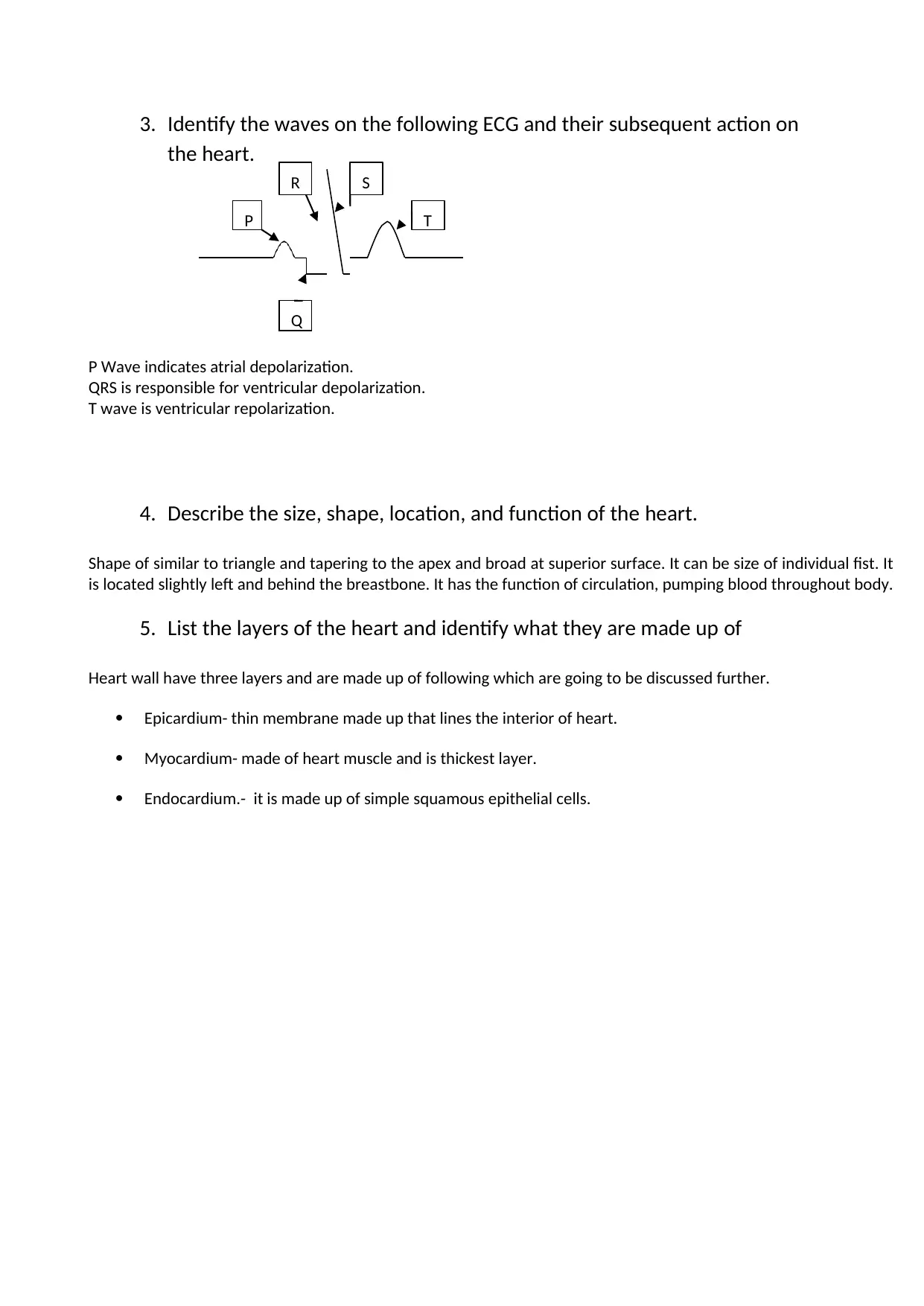
R S
P T
Q
3. Identify the waves on the following ECG and their subsequent action on
the heart.
P Wave indicates atrial depolarization.
QRS is responsible for ventricular depolarization.
T wave is ventricular repolarization.
4. Describe the size, shape, location, and function of the heart.
Shape of similar to triangle and tapering to the apex and broad at superior surface. It can be size of individual fist. It
is located slightly left and behind the breastbone. It has the function of circulation, pumping blood throughout body.
5. List the layers of the heart and identify what they are made up of
Heart wall have three layers and are made up of following which are going to be discussed further.
Epicardium- thin membrane made up that lines the interior of heart.
Myocardium- made of heart muscle and is thickest layer.
Endocardium.- it is made up of simple squamous epithelial cells.
P T
Q
3. Identify the waves on the following ECG and their subsequent action on
the heart.
P Wave indicates atrial depolarization.
QRS is responsible for ventricular depolarization.
T wave is ventricular repolarization.
4. Describe the size, shape, location, and function of the heart.
Shape of similar to triangle and tapering to the apex and broad at superior surface. It can be size of individual fist. It
is located slightly left and behind the breastbone. It has the function of circulation, pumping blood throughout body.
5. List the layers of the heart and identify what they are made up of
Heart wall have three layers and are made up of following which are going to be discussed further.
Epicardium- thin membrane made up that lines the interior of heart.
Myocardium- made of heart muscle and is thickest layer.
Endocardium.- it is made up of simple squamous epithelial cells.

Respiratory System
Diagrams
Nasal cavity
Larynx
Primary right
bronchus
Right lung
pharynx
trachea
Primary
bronchus
Primary left
bronchus
Left lung
Diaphragm
Diagrams
Nasal cavity
Larynx
Primary right
bronchus
Right lung
pharynx
trachea
Primary
bronchus
Primary left
bronchus
Left lung
Diaphragm
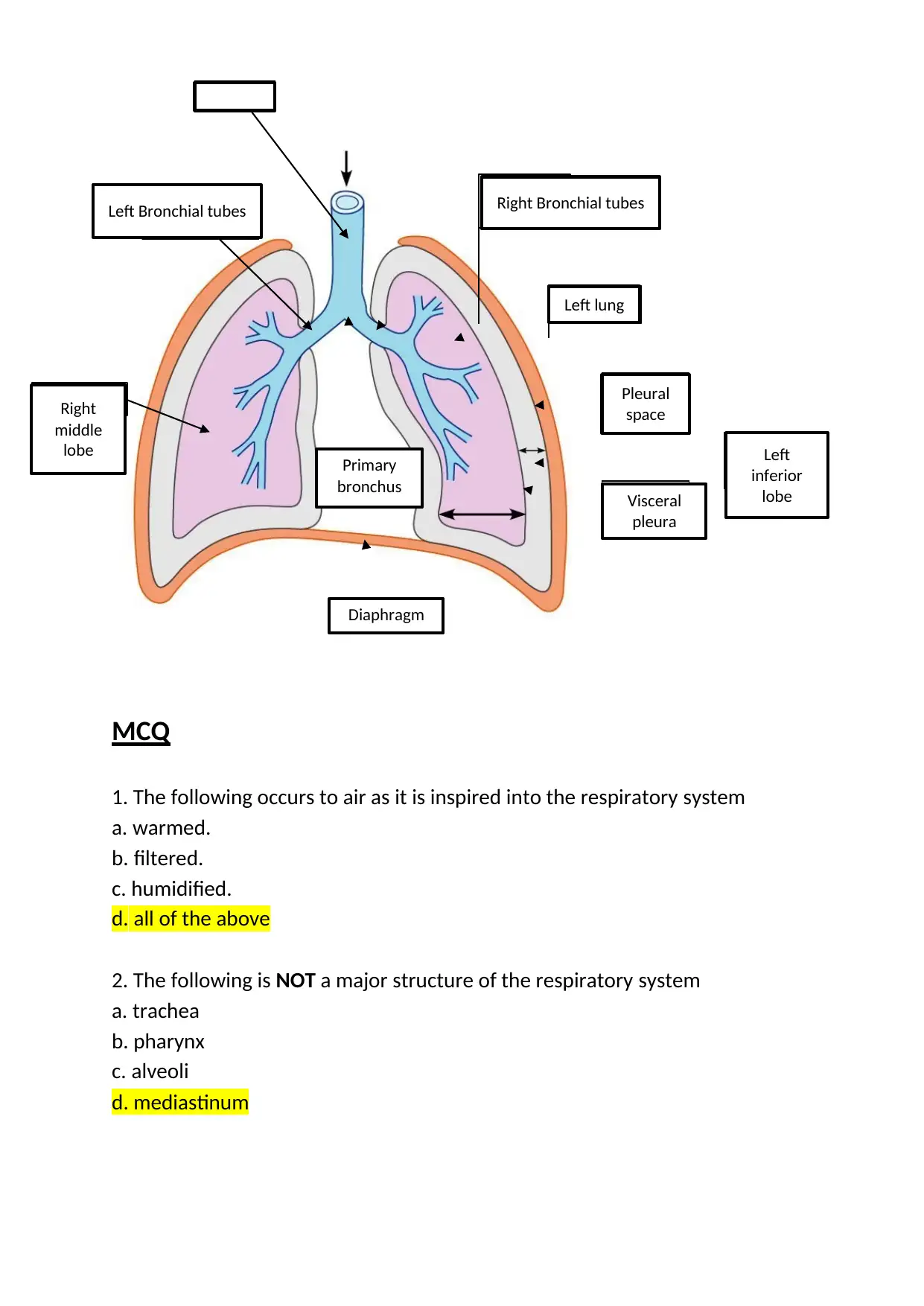
MCQ
1. The following occurs to air as it is inspired into the respiratory system
a. warmed.
b. filtered.
c. humidified.
d. all of the above
2. The following is NOT a major structure of the respiratory system
a. trachea
b. pharynx
c. alveoli
d. mediastinum
Left Bronchial tubes
Right
middle
lobe
Diaphragm
Primary
bronchus
Right Bronchial tubes
Left lung
Pleural
space
Visceral
pleura
Left
inferior
lobe
1. The following occurs to air as it is inspired into the respiratory system
a. warmed.
b. filtered.
c. humidified.
d. all of the above
2. The following is NOT a major structure of the respiratory system
a. trachea
b. pharynx
c. alveoli
d. mediastinum
Left Bronchial tubes
Right
middle
lobe
Diaphragm
Primary
bronchus
Right Bronchial tubes
Left lung
Pleural
space
Visceral
pleura
Left
inferior
lobe
Secure Best Marks with AI Grader
Need help grading? Try our AI Grader for instant feedback on your assignments.
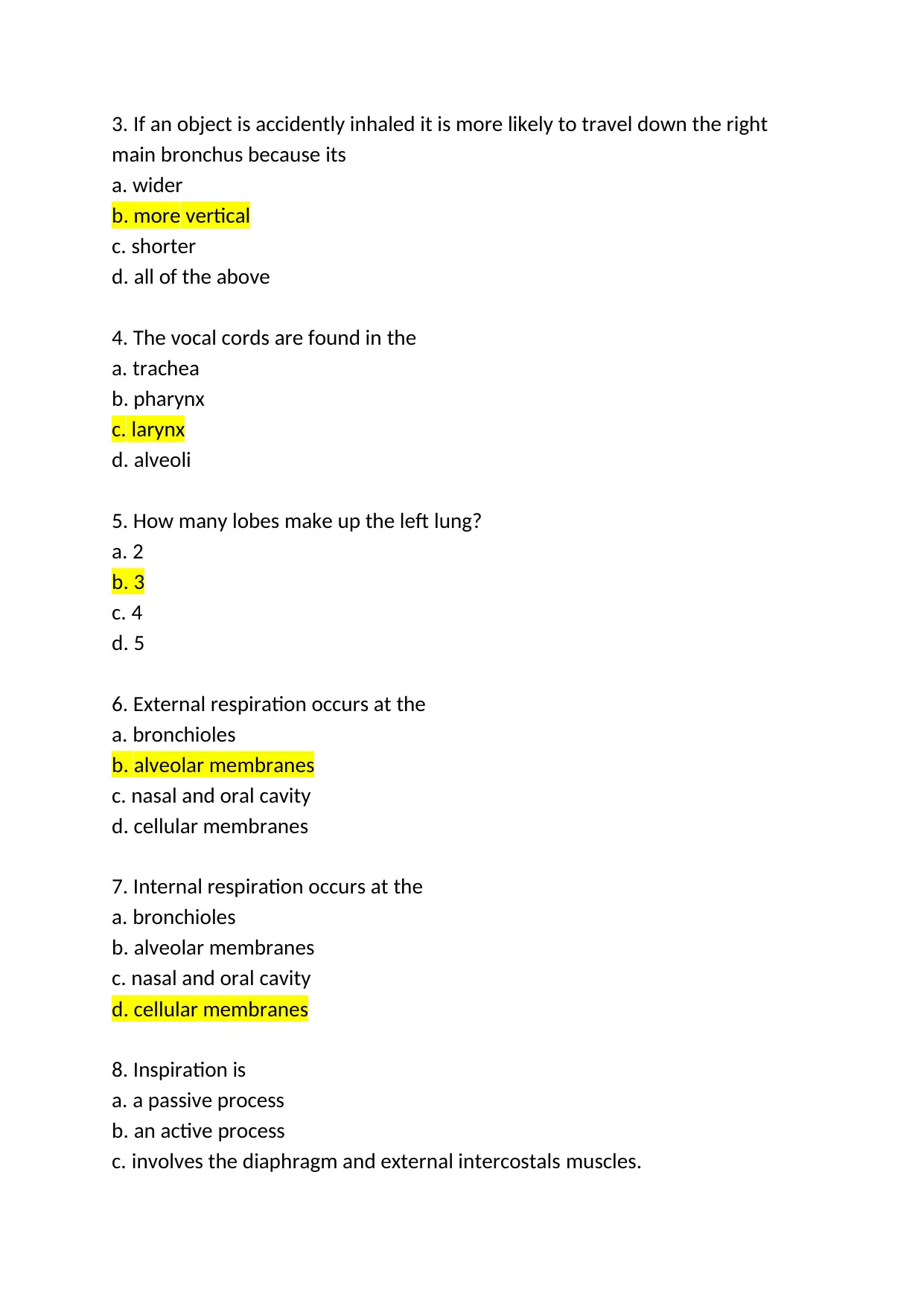
3. If an object is accidently inhaled it is more likely to travel down the right
main bronchus because its
a. wider
b. more vertical
c. shorter
d. all of the above
4. The vocal cords are found in the
a. trachea
b. pharynx
c. larynx
d. alveoli
5. How many lobes make up the left lung?
a. 2
b. 3
c. 4
d. 5
6. External respiration occurs at the
a. bronchioles
b. alveolar membranes
c. nasal and oral cavity
d. cellular membranes
7. Internal respiration occurs at the
a. bronchioles
b. alveolar membranes
c. nasal and oral cavity
d. cellular membranes
8. Inspiration is
a. a passive process
b. an active process
c. involves the diaphragm and external intercostals muscles.
main bronchus because its
a. wider
b. more vertical
c. shorter
d. all of the above
4. The vocal cords are found in the
a. trachea
b. pharynx
c. larynx
d. alveoli
5. How many lobes make up the left lung?
a. 2
b. 3
c. 4
d. 5
6. External respiration occurs at the
a. bronchioles
b. alveolar membranes
c. nasal and oral cavity
d. cellular membranes
7. Internal respiration occurs at the
a. bronchioles
b. alveolar membranes
c. nasal and oral cavity
d. cellular membranes
8. Inspiration is
a. a passive process
b. an active process
c. involves the diaphragm and external intercostals muscles.
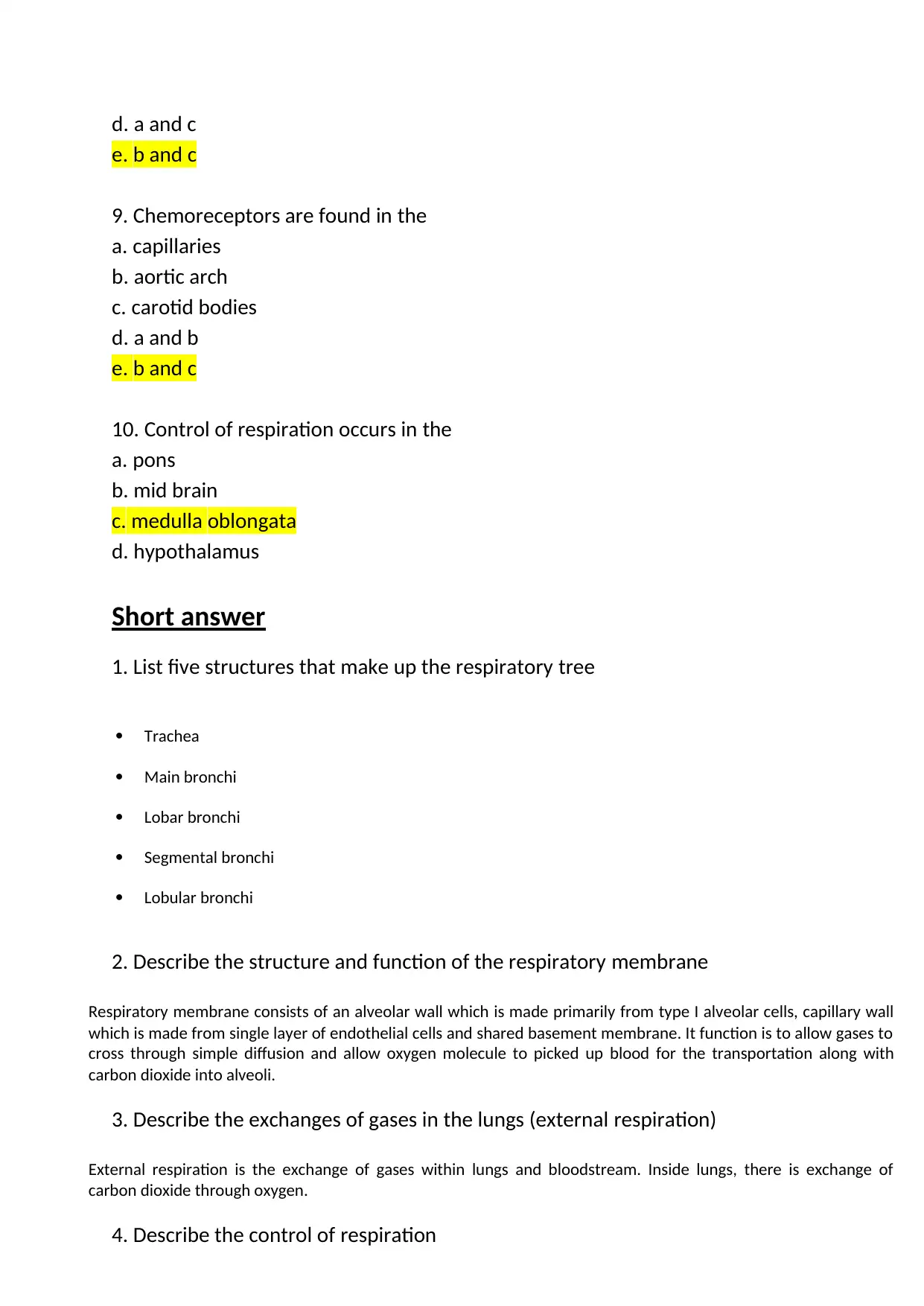
d. a and c
e. b and c
9. Chemoreceptors are found in the
a. capillaries
b. aortic arch
c. carotid bodies
d. a and b
e. b and c
10. Control of respiration occurs in the
a. pons
b. mid brain
c. medulla oblongata
d. hypothalamus
Short answer
1. List five structures that make up the respiratory tree
Trachea
Main bronchi
Lobar bronchi
Segmental bronchi
Lobular bronchi
2. Describe the structure and function of the respiratory membrane
Respiratory membrane consists of an alveolar wall which is made primarily from type I alveolar cells, capillary wall
which is made from single layer of endothelial cells and shared basement membrane. It function is to allow gases to
cross through simple diffusion and allow oxygen molecule to picked up blood for the transportation along with
carbon dioxide into alveoli.
3. Describe the exchanges of gases in the lungs (external respiration)
External respiration is the exchange of gases within lungs and bloodstream. Inside lungs, there is exchange of
carbon dioxide through oxygen.
4. Describe the control of respiration
e. b and c
9. Chemoreceptors are found in the
a. capillaries
b. aortic arch
c. carotid bodies
d. a and b
e. b and c
10. Control of respiration occurs in the
a. pons
b. mid brain
c. medulla oblongata
d. hypothalamus
Short answer
1. List five structures that make up the respiratory tree
Trachea
Main bronchi
Lobar bronchi
Segmental bronchi
Lobular bronchi
2. Describe the structure and function of the respiratory membrane
Respiratory membrane consists of an alveolar wall which is made primarily from type I alveolar cells, capillary wall
which is made from single layer of endothelial cells and shared basement membrane. It function is to allow gases to
cross through simple diffusion and allow oxygen molecule to picked up blood for the transportation along with
carbon dioxide into alveoli.
3. Describe the exchanges of gases in the lungs (external respiration)
External respiration is the exchange of gases within lungs and bloodstream. Inside lungs, there is exchange of
carbon dioxide through oxygen.
4. Describe the control of respiration
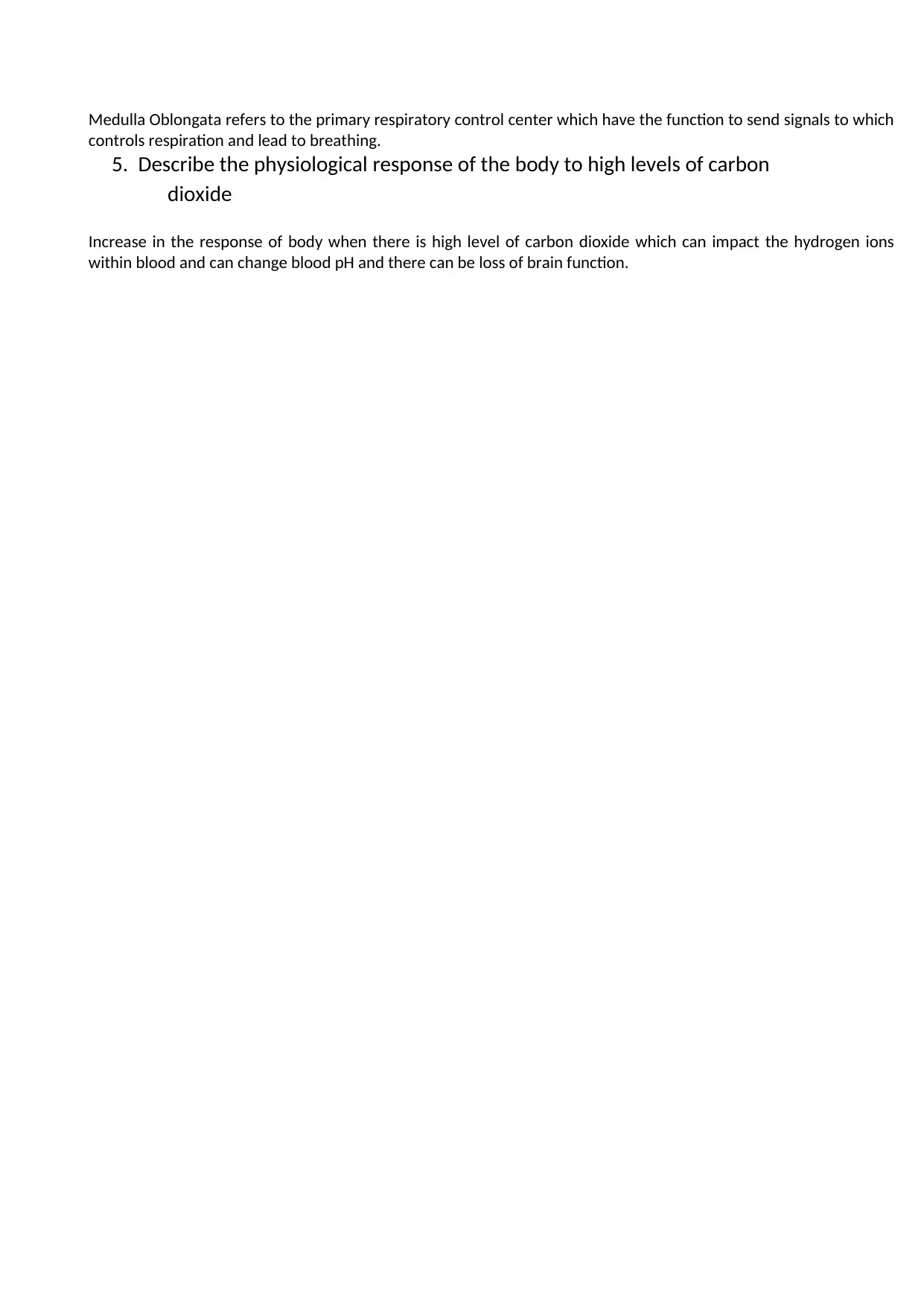
Medulla Oblongata refers to the primary respiratory control center which have the function to send signals to which
controls respiration and lead to breathing.
5. Describe the physiological response of the body to high levels of carbon
dioxide
Increase in the response of body when there is high level of carbon dioxide which can impact the hydrogen ions
within blood and can change blood pH and there can be loss of brain function.
controls respiration and lead to breathing.
5. Describe the physiological response of the body to high levels of carbon
dioxide
Increase in the response of body when there is high level of carbon dioxide which can impact the hydrogen ions
within blood and can change blood pH and there can be loss of brain function.
Paraphrase This Document
Need a fresh take? Get an instant paraphrase of this document with our AI Paraphraser

1. Renal System
Diagram
Adrenal gland
Kidney
ureter
Urinary
bladder
urethra
medualla
Renal pelvis
Inferior
vena cava
Aorta
Cortical blood
vessel
Diagram
Adrenal gland
Kidney
ureter
Urinary
bladder
urethra
medualla
Renal pelvis
Inferior
vena cava
Aorta
Cortical blood
vessel
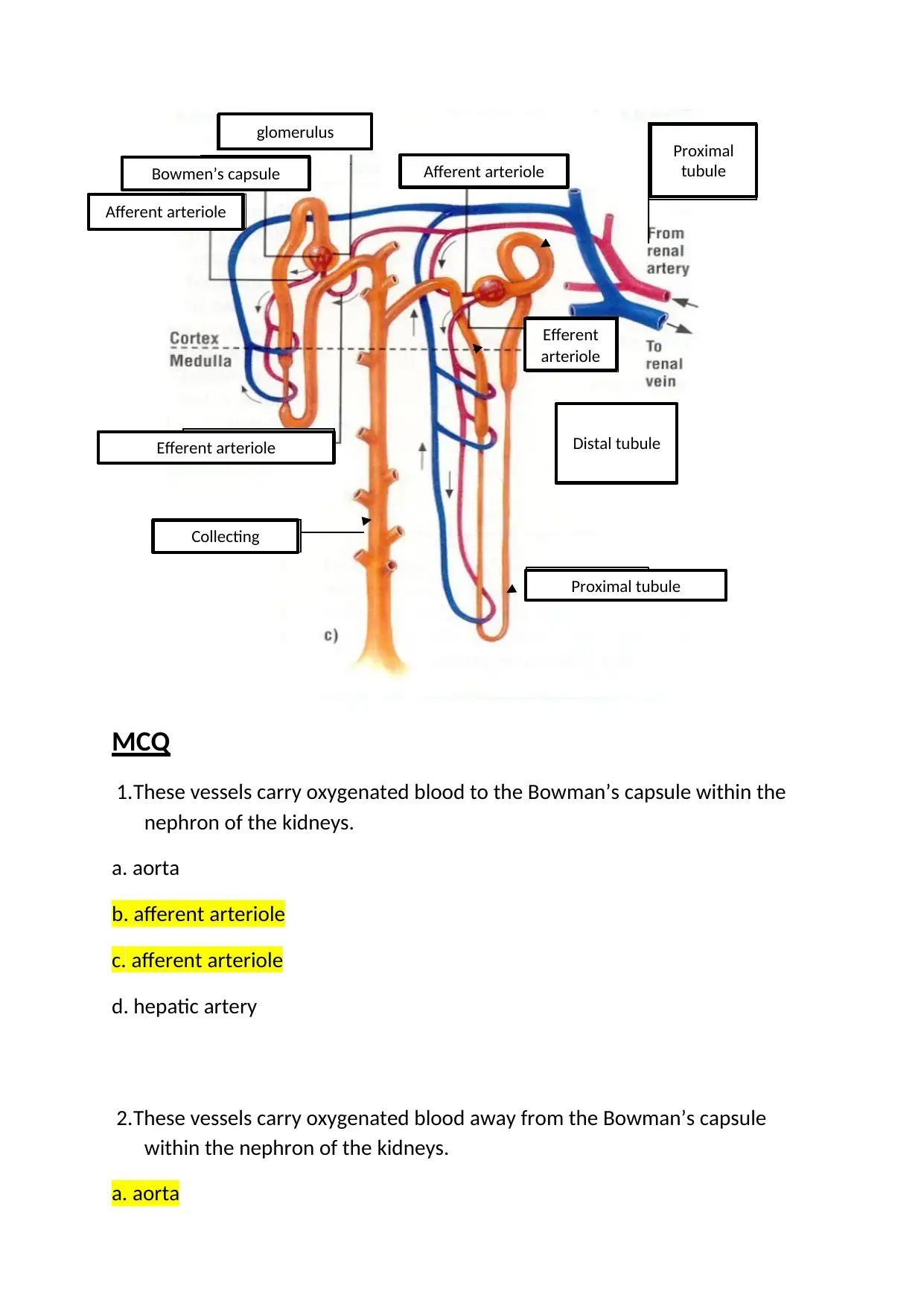
MCQ
1.These vessels carry oxygenated blood to the Bowman’s capsule within the
nephron of the kidneys.
a. aorta
b. afferent arteriole
c. afferent arteriole
d. hepatic artery
2.These vessels carry oxygenated blood away from the Bowman’s capsule
within the nephron of the kidneys.
a. aorta
glomerulus
Bowmen’s capsule
Afferent arteriole
Afferent arteriole
Efferent arteriole
Collecting
tobulepro
Distal tubule
Proximal tubule
Efferent
arteriole
Proximal
tubule
1.These vessels carry oxygenated blood to the Bowman’s capsule within the
nephron of the kidneys.
a. aorta
b. afferent arteriole
c. afferent arteriole
d. hepatic artery
2.These vessels carry oxygenated blood away from the Bowman’s capsule
within the nephron of the kidneys.
a. aorta
glomerulus
Bowmen’s capsule
Afferent arteriole
Afferent arteriole
Efferent arteriole
Collecting
tobulepro
Distal tubule
Proximal tubule
Efferent
arteriole
Proximal
tubule
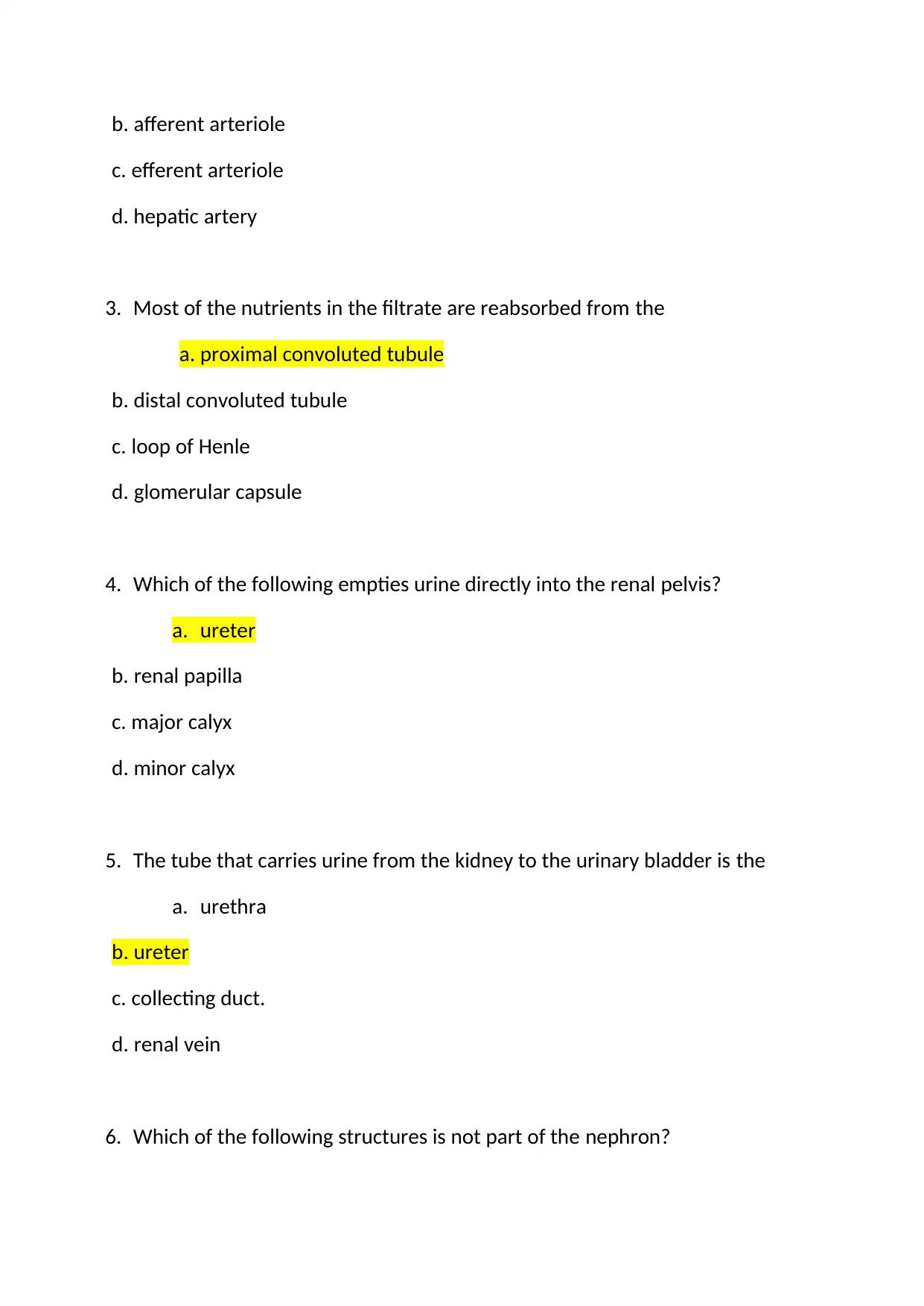
b. afferent arteriole
c. efferent arteriole
d. hepatic artery
3. Most of the nutrients in the filtrate are reabsorbed from the
a. proximal convoluted tubule
b. distal convoluted tubule
c. loop of Henle
d. glomerular capsule
4. Which of the following empties urine directly into the renal pelvis?
a. ureter
b. renal papilla
c. major calyx
d. minor calyx
5. The tube that carries urine from the kidney to the urinary bladder is the
a. urethra
b. ureter
c. collecting duct.
d. renal vein
6. Which of the following structures is not part of the nephron?
c. efferent arteriole
d. hepatic artery
3. Most of the nutrients in the filtrate are reabsorbed from the
a. proximal convoluted tubule
b. distal convoluted tubule
c. loop of Henle
d. glomerular capsule
4. Which of the following empties urine directly into the renal pelvis?
a. ureter
b. renal papilla
c. major calyx
d. minor calyx
5. The tube that carries urine from the kidney to the urinary bladder is the
a. urethra
b. ureter
c. collecting duct.
d. renal vein
6. Which of the following structures is not part of the nephron?
Secure Best Marks with AI Grader
Need help grading? Try our AI Grader for instant feedback on your assignments.
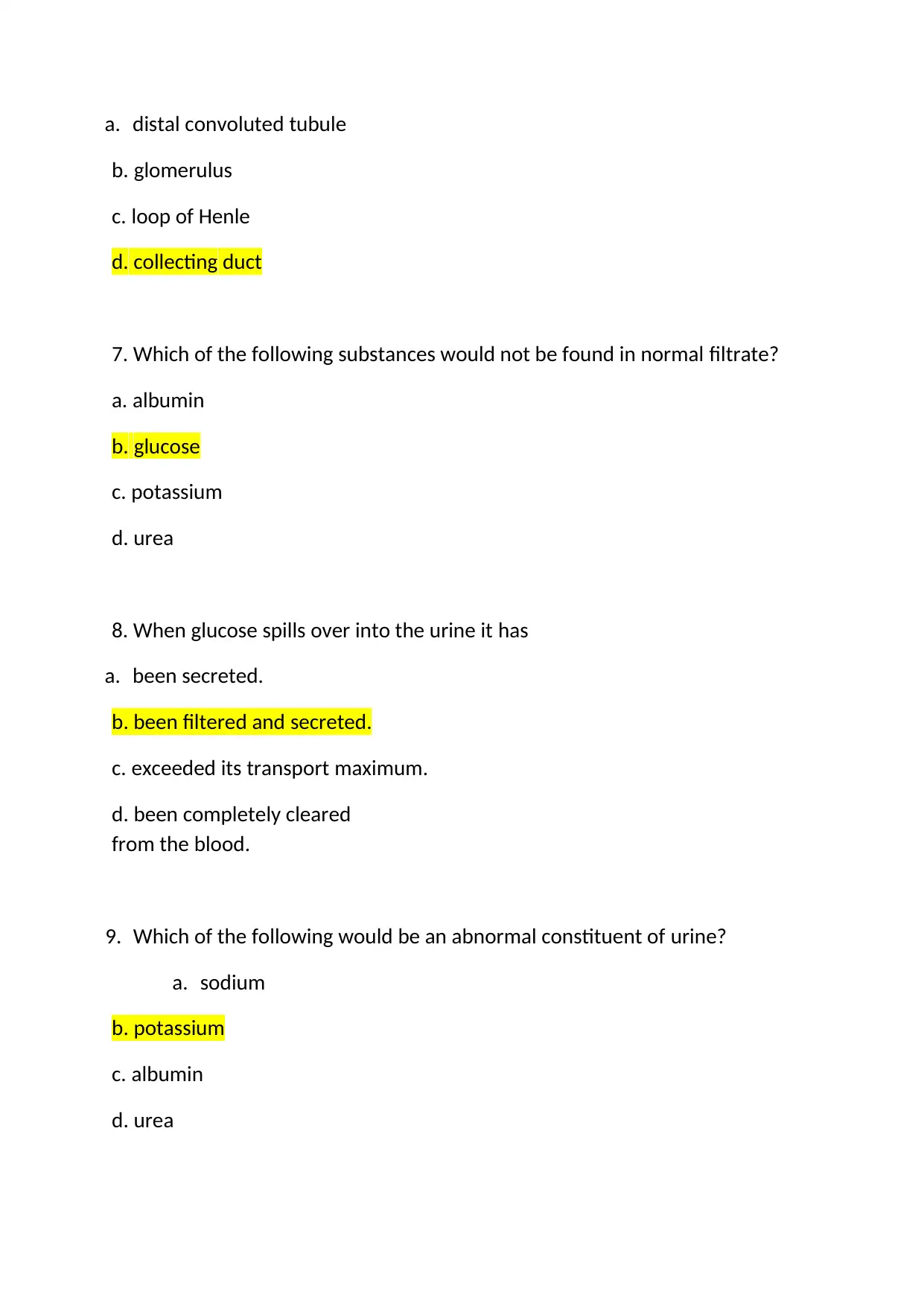
a. distal convoluted tubule
b. glomerulus
c. loop of Henle
d. collecting duct
7. Which of the following substances would not be found in normal filtrate?
a. albumin
b. glucose
c. potassium
d. urea
8. When glucose spills over into the urine it has
a. been secreted.
b. been filtered and secreted.
c. exceeded its transport maximum.
d. been completely cleared
from the blood.
9. Which of the following would be an abnormal constituent of urine?
a. sodium
b. potassium
c. albumin
d. urea
b. glomerulus
c. loop of Henle
d. collecting duct
7. Which of the following substances would not be found in normal filtrate?
a. albumin
b. glucose
c. potassium
d. urea
8. When glucose spills over into the urine it has
a. been secreted.
b. been filtered and secreted.
c. exceeded its transport maximum.
d. been completely cleared
from the blood.
9. Which of the following would be an abnormal constituent of urine?
a. sodium
b. potassium
c. albumin
d. urea

10. The enzyme renin is released from the kidney has a resultant effect on an
individual
a. heart rate
b. respiratory rate
c. oxygen saturations
d. blood pressure
Short Answer
1. List five functions of the kidney.
Remove waste and extra fluid.
Controls blood pressure
Keep bones healthy
Makes red blood cells
Control pH levels
2. List those structures that make up the gross anatomy of the renal system.
Kidneys
Renal pelvis
Ureters
Bladder
Urethra
3. Describe the structure of a nephron.
Nephron refers to the structural along with functional unit of kidneys which regulates soluble substance and water
in blood through filtering it.
4. Identify the nephron parts which are responsible for filtration, reabsorption,
and tubular secretion.
individual
a. heart rate
b. respiratory rate
c. oxygen saturations
d. blood pressure
Short Answer
1. List five functions of the kidney.
Remove waste and extra fluid.
Controls blood pressure
Keep bones healthy
Makes red blood cells
Control pH levels
2. List those structures that make up the gross anatomy of the renal system.
Kidneys
Renal pelvis
Ureters
Bladder
Urethra
3. Describe the structure of a nephron.
Nephron refers to the structural along with functional unit of kidneys which regulates soluble substance and water
in blood through filtering it.
4. Identify the nephron parts which are responsible for filtration, reabsorption,
and tubular secretion.
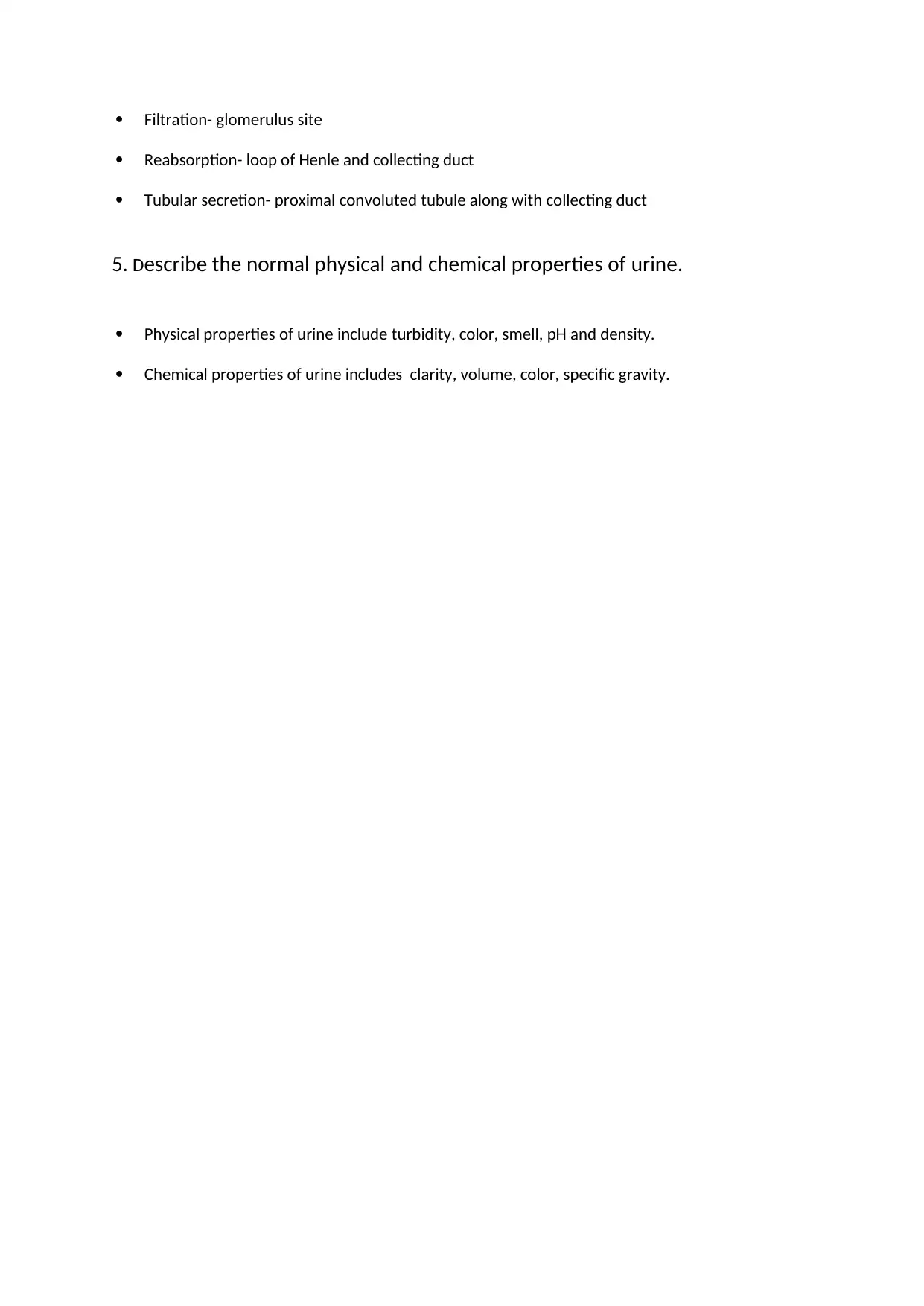
Filtration- glomerulus site
Reabsorption- loop of Henle and collecting duct
Tubular secretion- proximal convoluted tubule along with collecting duct
5. Describe the normal physical and chemical properties of urine.
Physical properties of urine include turbidity, color, smell, pH and density.
Chemical properties of urine includes clarity, volume, color, specific gravity.
Reabsorption- loop of Henle and collecting duct
Tubular secretion- proximal convoluted tubule along with collecting duct
5. Describe the normal physical and chemical properties of urine.
Physical properties of urine include turbidity, color, smell, pH and density.
Chemical properties of urine includes clarity, volume, color, specific gravity.
Paraphrase This Document
Need a fresh take? Get an instant paraphrase of this document with our AI Paraphraser
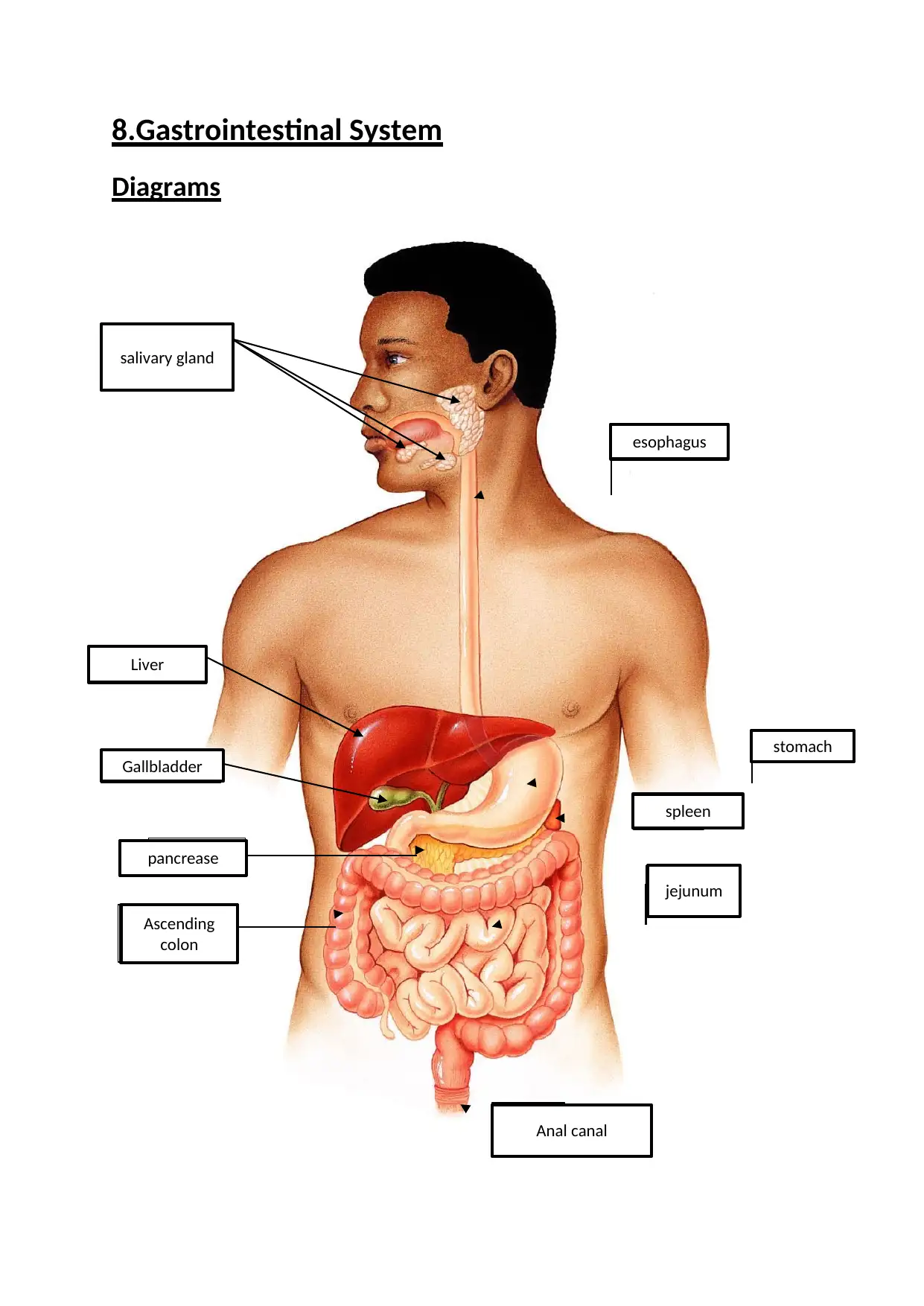
8.Gastrointestinal System
Diagrams
salivary gland
esophagus
Liver
Gallbladder
pancrease
Ascending
colon
Anal canal
jejunum
spleen
stomach
Diagrams
salivary gland
esophagus
Liver
Gallbladder
pancrease
Ascending
colon
Anal canal
jejunum
spleen
stomach

Label digestive process and anatomy
mouth
Common bile
duct
duodenum
Ileum
rectum
jejunum
stomach
esophagus
mouth
Common bile
duct
duodenum
Ileum
rectum
jejunum
stomach
esophagus
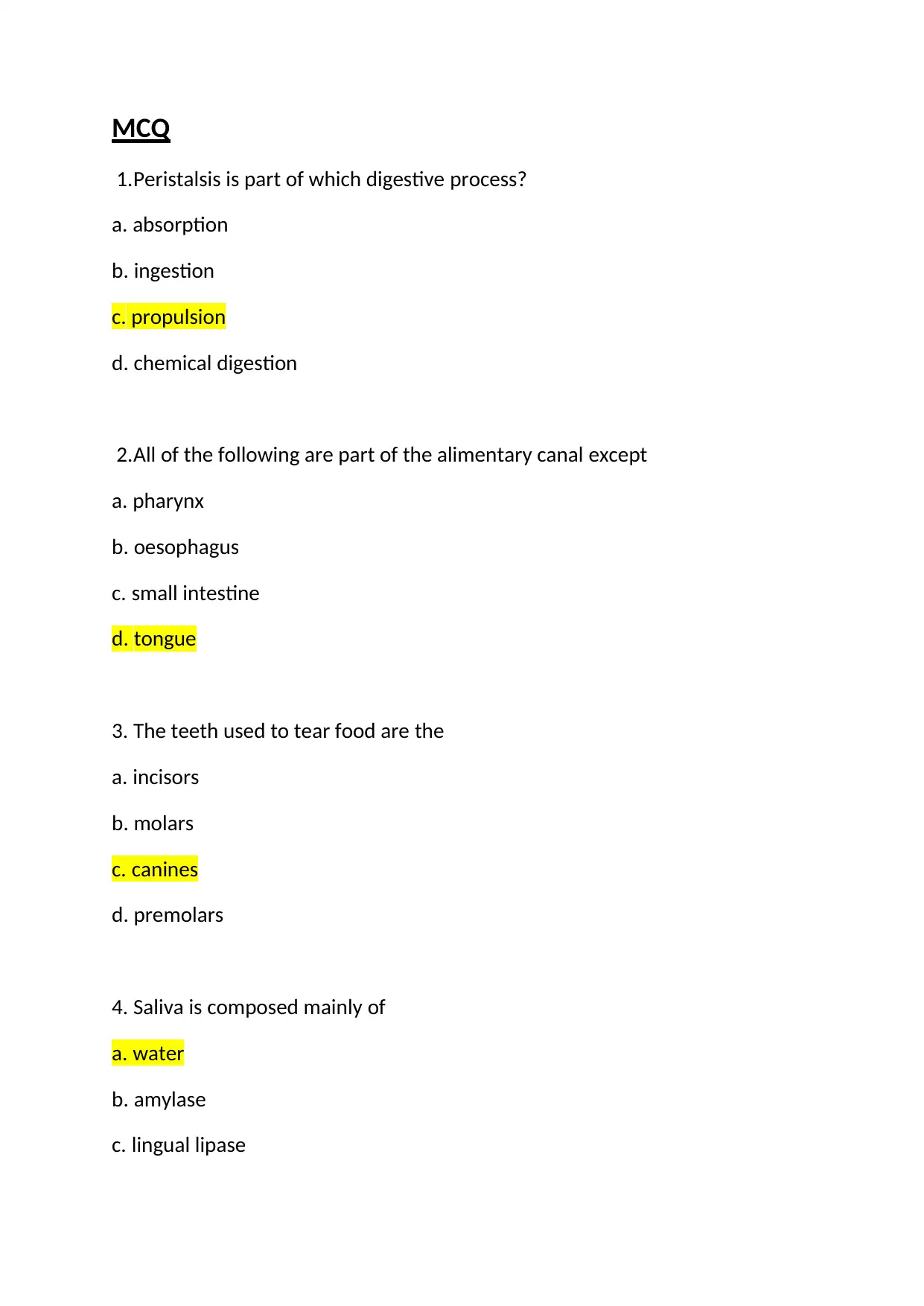
MCQ
1.Peristalsis is part of which digestive process?
a. absorption
b. ingestion
c. propulsion
d. chemical digestion
2.All of the following are part of the alimentary canal except
a. pharynx
b. oesophagus
c. small intestine
d. tongue
3. The teeth used to tear food are the
a. incisors
b. molars
c. canines
d. premolars
4. Saliva is composed mainly of
a. water
b. amylase
c. lingual lipase
1.Peristalsis is part of which digestive process?
a. absorption
b. ingestion
c. propulsion
d. chemical digestion
2.All of the following are part of the alimentary canal except
a. pharynx
b. oesophagus
c. small intestine
d. tongue
3. The teeth used to tear food are the
a. incisors
b. molars
c. canines
d. premolars
4. Saliva is composed mainly of
a. water
b. amylase
c. lingual lipase
Secure Best Marks with AI Grader
Need help grading? Try our AI Grader for instant feedback on your assignments.
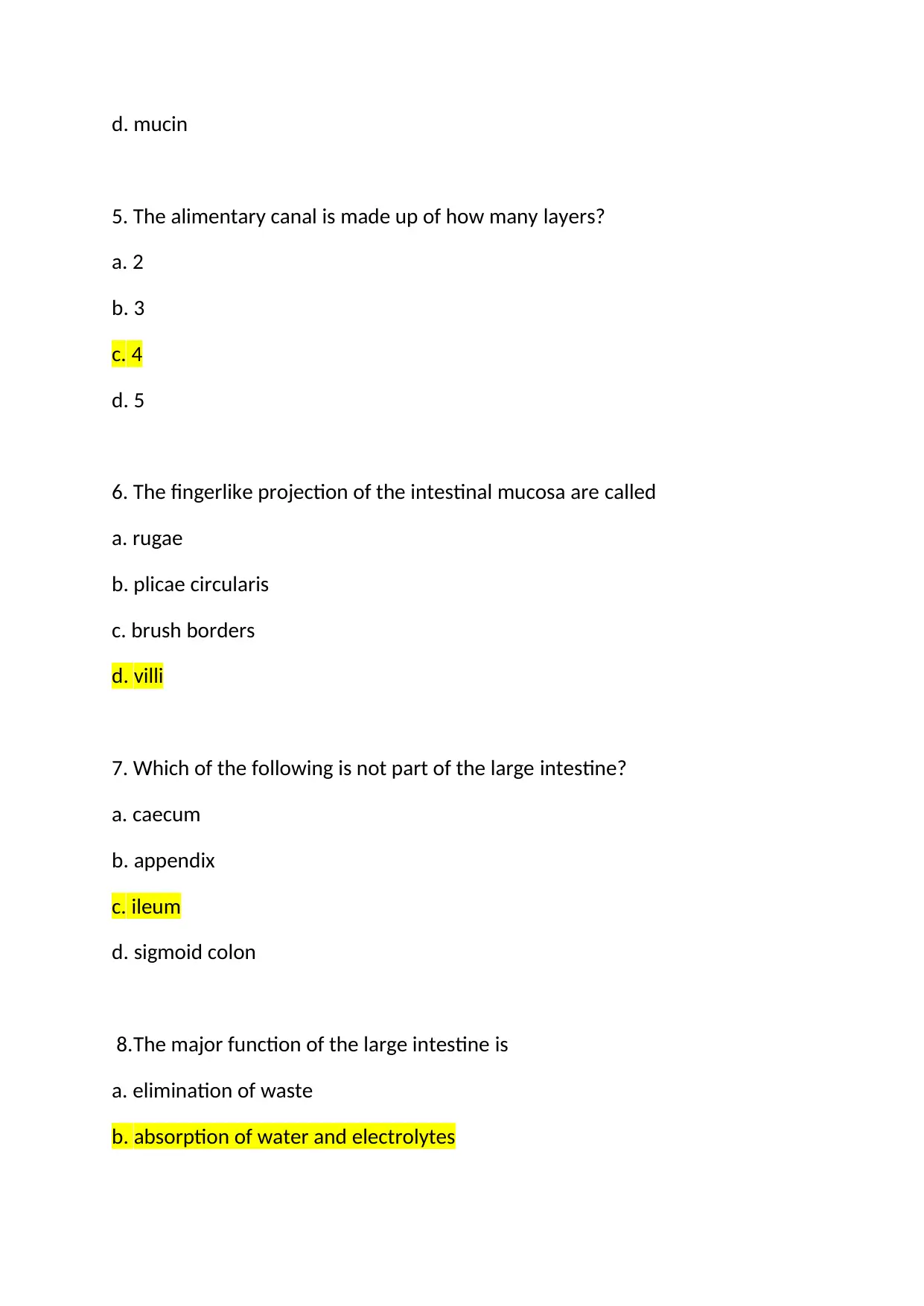
d. mucin
5. The alimentary canal is made up of how many layers?
a. 2
b. 3
c. 4
d. 5
6. The fingerlike projection of the intestinal mucosa are called
a. rugae
b. plicae circularis
c. brush borders
d. villi
7. Which of the following is not part of the large intestine?
a. caecum
b. appendix
c. ileum
d. sigmoid colon
8.The major function of the large intestine is
a. elimination of waste
b. absorption of water and electrolytes
5. The alimentary canal is made up of how many layers?
a. 2
b. 3
c. 4
d. 5
6. The fingerlike projection of the intestinal mucosa are called
a. rugae
b. plicae circularis
c. brush borders
d. villi
7. Which of the following is not part of the large intestine?
a. caecum
b. appendix
c. ileum
d. sigmoid colon
8.The major function of the large intestine is
a. elimination of waste
b. absorption of water and electrolytes
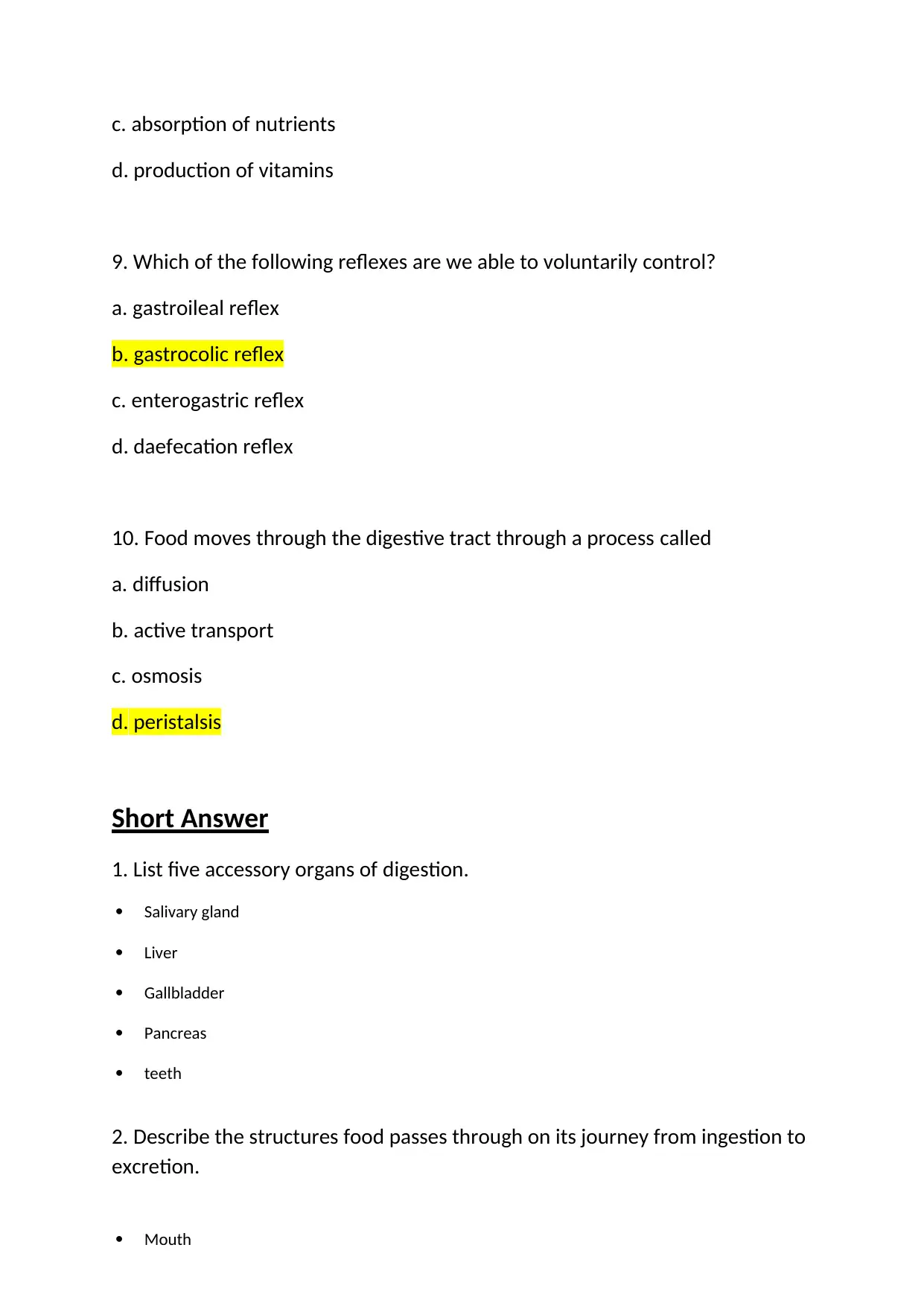
c. absorption of nutrients
d. production of vitamins
9. Which of the following reflexes are we able to voluntarily control?
a. gastroileal reflex
b. gastrocolic reflex
c. enterogastric reflex
d. daefecation reflex
10. Food moves through the digestive tract through a process called
a. diffusion
b. active transport
c. osmosis
d. peristalsis
Short Answer
1. List five accessory organs of digestion.
Salivary gland
Liver
Gallbladder
Pancreas
teeth
2. Describe the structures food passes through on its journey from ingestion to
excretion.
Mouth
d. production of vitamins
9. Which of the following reflexes are we able to voluntarily control?
a. gastroileal reflex
b. gastrocolic reflex
c. enterogastric reflex
d. daefecation reflex
10. Food moves through the digestive tract through a process called
a. diffusion
b. active transport
c. osmosis
d. peristalsis
Short Answer
1. List five accessory organs of digestion.
Salivary gland
Liver
Gallbladder
Pancreas
teeth
2. Describe the structures food passes through on its journey from ingestion to
excretion.
Mouth
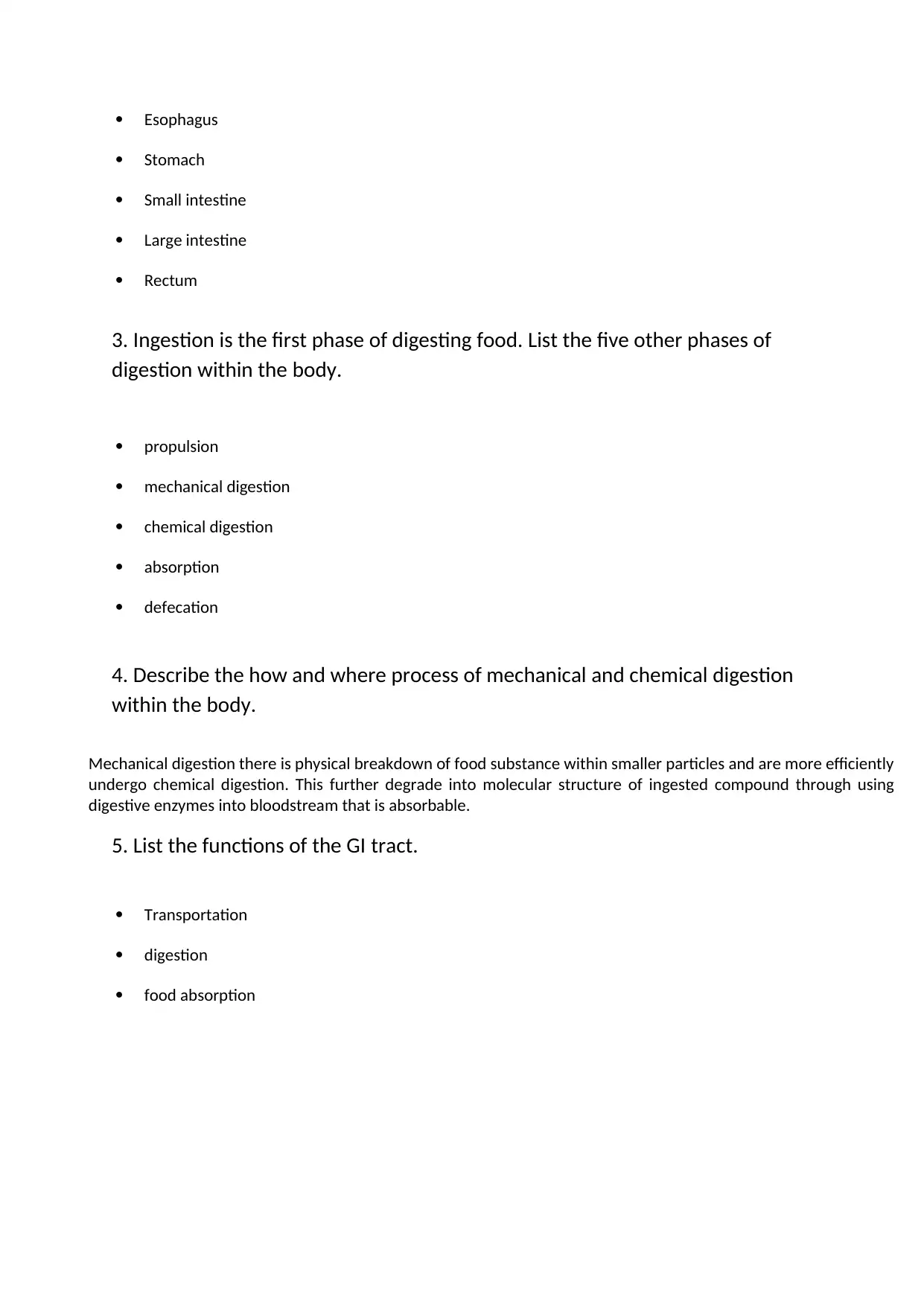
Esophagus
Stomach
Small intestine
Large intestine
Rectum
3. Ingestion is the first phase of digesting food. List the five other phases of
digestion within the body.
propulsion
mechanical digestion
chemical digestion
absorption
defecation
4. Describe the how and where process of mechanical and chemical digestion
within the body.
Mechanical digestion there is physical breakdown of food substance within smaller particles and are more efficiently
undergo chemical digestion. This further degrade into molecular structure of ingested compound through using
digestive enzymes into bloodstream that is absorbable.
5. List the functions of the GI tract.
Transportation
digestion
food absorption
Stomach
Small intestine
Large intestine
Rectum
3. Ingestion is the first phase of digesting food. List the five other phases of
digestion within the body.
propulsion
mechanical digestion
chemical digestion
absorption
defecation
4. Describe the how and where process of mechanical and chemical digestion
within the body.
Mechanical digestion there is physical breakdown of food substance within smaller particles and are more efficiently
undergo chemical digestion. This further degrade into molecular structure of ingested compound through using
digestive enzymes into bloodstream that is absorbable.
5. List the functions of the GI tract.
Transportation
digestion
food absorption
Paraphrase This Document
Need a fresh take? Get an instant paraphrase of this document with our AI Paraphraser
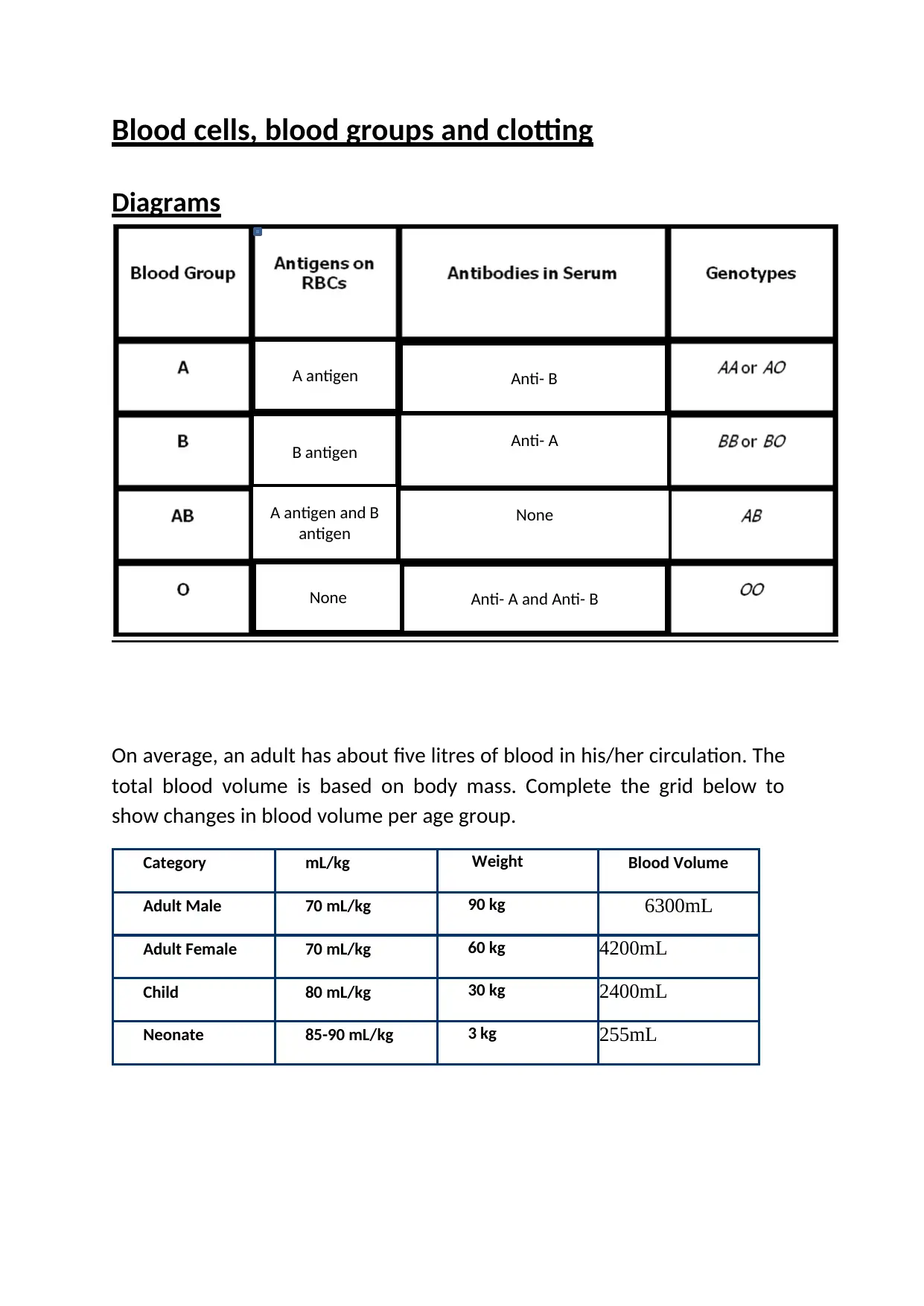
Blood cells, blood groups and clotting
Diagrams
On average, an adult has about five litres of blood in his/her circulation. The
total blood volume is based on body mass. Complete the grid below to
show changes in blood volume per age group.
Category mL/kg Weight Blood Volume
Adult Male 70 mL/kg 90 kg 6300mL
Adult Female 70 mL/kg 60 kg 4200mL
Child 80 mL/kg 30 kg 2400mL
Neonate 85-90 mL/kg 3 kg 255mL
A antigen
B antigen
A antigen and B
antigen
None
Anti- B
Anti- A
None
Anti- A and Anti- B
Diagrams
On average, an adult has about five litres of blood in his/her circulation. The
total blood volume is based on body mass. Complete the grid below to
show changes in blood volume per age group.
Category mL/kg Weight Blood Volume
Adult Male 70 mL/kg 90 kg 6300mL
Adult Female 70 mL/kg 60 kg 4200mL
Child 80 mL/kg 30 kg 2400mL
Neonate 85-90 mL/kg 3 kg 255mL
A antigen
B antigen
A antigen and B
antigen
None
Anti- B
Anti- A
None
Anti- A and Anti- B
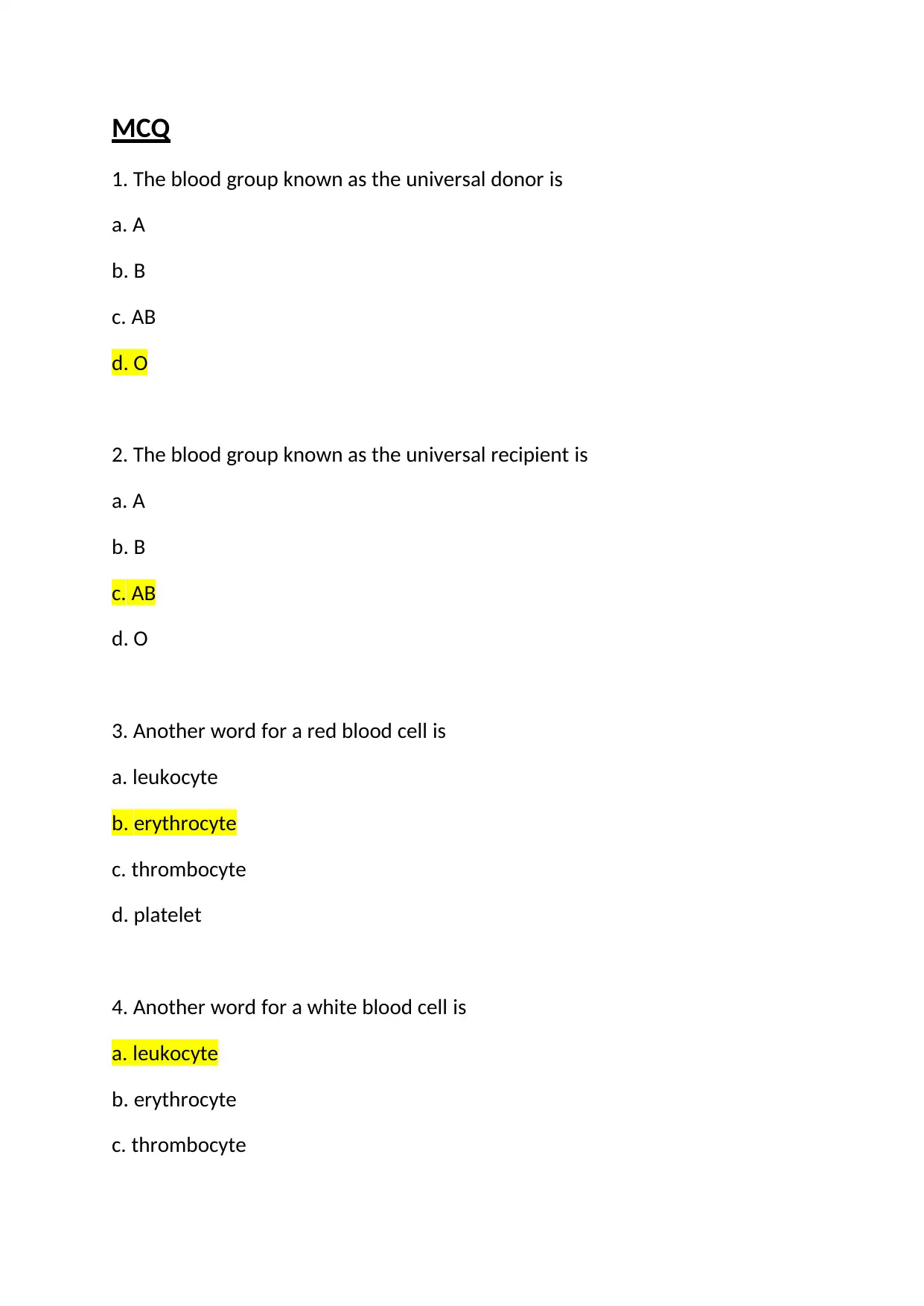
MCQ
1. The blood group known as the universal donor is
a. A
b. B
c. AB
d. O
2. The blood group known as the universal recipient is
a. A
b. B
c. AB
d. O
3. Another word for a red blood cell is
a. leukocyte
b. erythrocyte
c. thrombocyte
d. platelet
4. Another word for a white blood cell is
a. leukocyte
b. erythrocyte
c. thrombocyte
1. The blood group known as the universal donor is
a. A
b. B
c. AB
d. O
2. The blood group known as the universal recipient is
a. A
b. B
c. AB
d. O
3. Another word for a red blood cell is
a. leukocyte
b. erythrocyte
c. thrombocyte
d. platelet
4. Another word for a white blood cell is
a. leukocyte
b. erythrocyte
c. thrombocyte
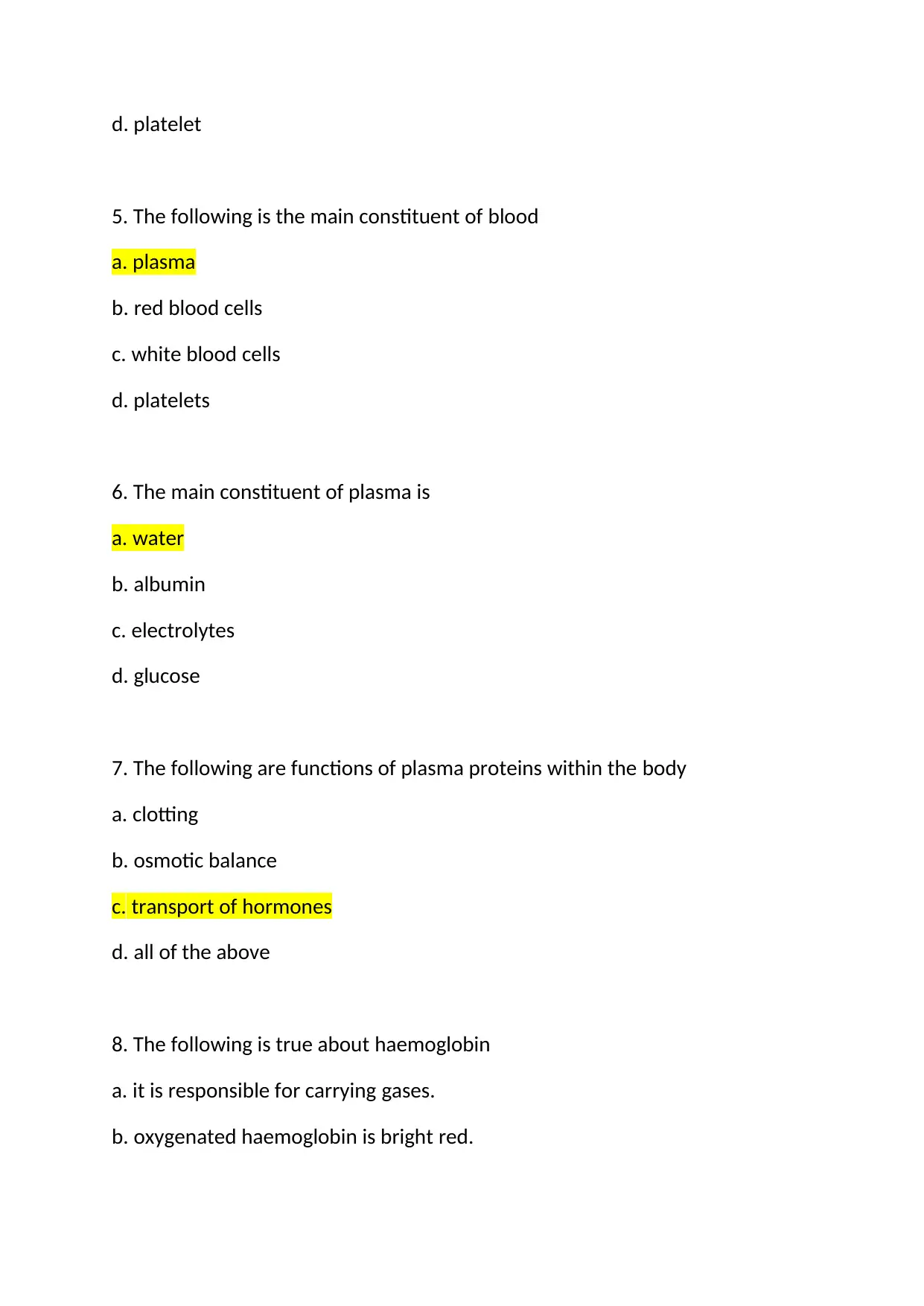
d. platelet
5. The following is the main constituent of blood
a. plasma
b. red blood cells
c. white blood cells
d. platelets
6. The main constituent of plasma is
a. water
b. albumin
c. electrolytes
d. glucose
7. The following are functions of plasma proteins within the body
a. clotting
b. osmotic balance
c. transport of hormones
d. all of the above
8. The following is true about haemoglobin
a. it is responsible for carrying gases.
b. oxygenated haemoglobin is bright red.
5. The following is the main constituent of blood
a. plasma
b. red blood cells
c. white blood cells
d. platelets
6. The main constituent of plasma is
a. water
b. albumin
c. electrolytes
d. glucose
7. The following are functions of plasma proteins within the body
a. clotting
b. osmotic balance
c. transport of hormones
d. all of the above
8. The following is true about haemoglobin
a. it is responsible for carrying gases.
b. oxygenated haemoglobin is bright red.
Secure Best Marks with AI Grader
Need help grading? Try our AI Grader for instant feedback on your assignments.
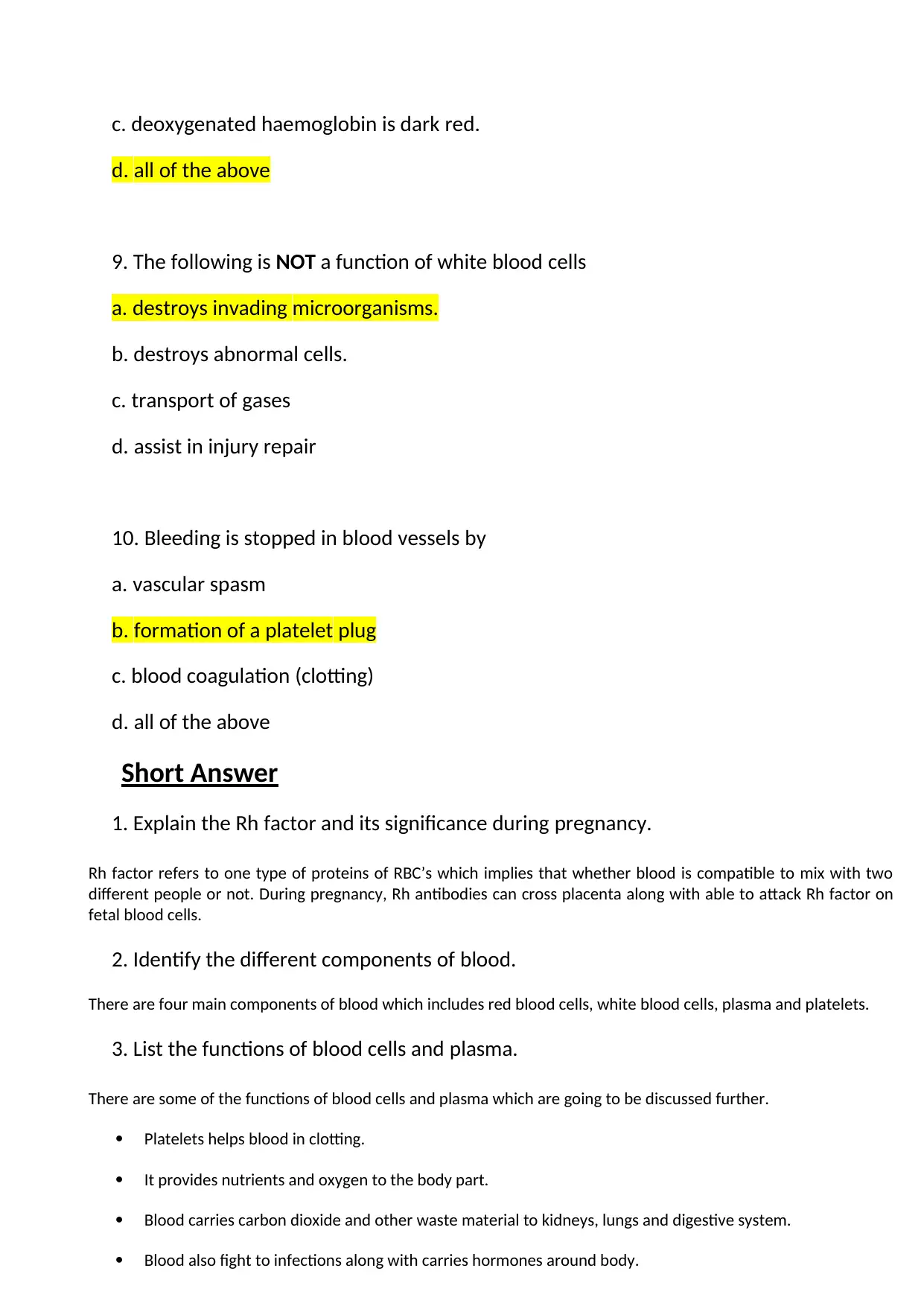
c. deoxygenated haemoglobin is dark red.
d. all of the above
9. The following is NOT a function of white blood cells
a. destroys invading microorganisms.
b. destroys abnormal cells.
c. transport of gases
d. assist in injury repair
10. Bleeding is stopped in blood vessels by
a. vascular spasm
b. formation of a platelet plug
c. blood coagulation (clotting)
d. all of the above
Short Answer
1. Explain the Rh factor and its significance during pregnancy.
Rh factor refers to one type of proteins of RBC’s which implies that whether blood is compatible to mix with two
different people or not. During pregnancy, Rh antibodies can cross placenta along with able to attack Rh factor on
fetal blood cells.
2. Identify the different components of blood.
There are four main components of blood which includes red blood cells, white blood cells, plasma and platelets.
3. List the functions of blood cells and plasma.
There are some of the functions of blood cells and plasma which are going to be discussed further.
Platelets helps blood in clotting.
It provides nutrients and oxygen to the body part.
Blood carries carbon dioxide and other waste material to kidneys, lungs and digestive system.
Blood also fight to infections along with carries hormones around body.
d. all of the above
9. The following is NOT a function of white blood cells
a. destroys invading microorganisms.
b. destroys abnormal cells.
c. transport of gases
d. assist in injury repair
10. Bleeding is stopped in blood vessels by
a. vascular spasm
b. formation of a platelet plug
c. blood coagulation (clotting)
d. all of the above
Short Answer
1. Explain the Rh factor and its significance during pregnancy.
Rh factor refers to one type of proteins of RBC’s which implies that whether blood is compatible to mix with two
different people or not. During pregnancy, Rh antibodies can cross placenta along with able to attack Rh factor on
fetal blood cells.
2. Identify the different components of blood.
There are four main components of blood which includes red blood cells, white blood cells, plasma and platelets.
3. List the functions of blood cells and plasma.
There are some of the functions of blood cells and plasma which are going to be discussed further.
Platelets helps blood in clotting.
It provides nutrients and oxygen to the body part.
Blood carries carbon dioxide and other waste material to kidneys, lungs and digestive system.
Blood also fight to infections along with carries hormones around body.
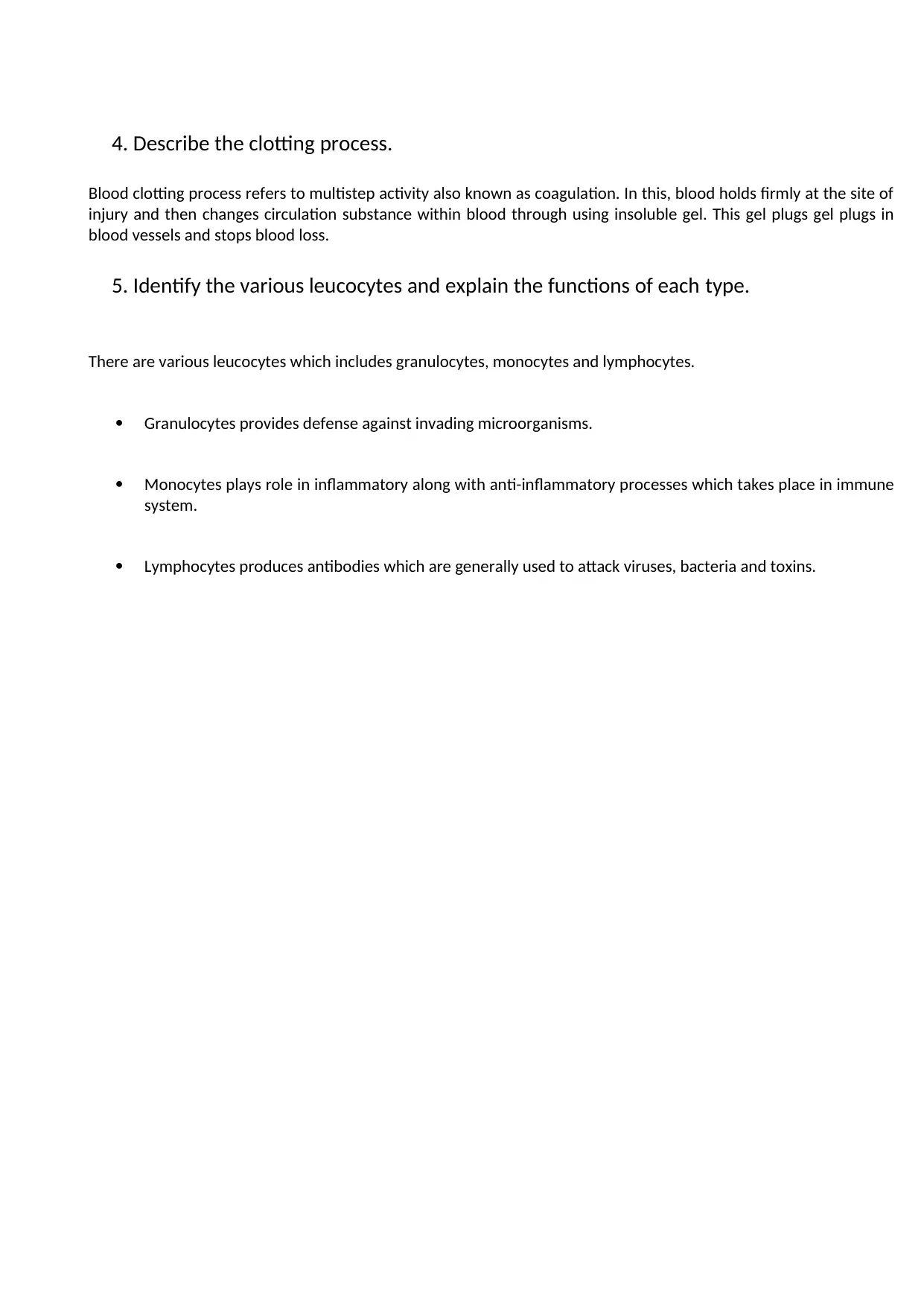
4. Describe the clotting process.
Blood clotting process refers to multistep activity also known as coagulation. In this, blood holds firmly at the site of
injury and then changes circulation substance within blood through using insoluble gel. This gel plugs gel plugs in
blood vessels and stops blood loss.
5. Identify the various leucocytes and explain the functions of each type.
There are various leucocytes which includes granulocytes, monocytes and lymphocytes.
Granulocytes provides defense against invading microorganisms.
Monocytes plays role in inflammatory along with anti-inflammatory processes which takes place in immune
system.
Lymphocytes produces antibodies which are generally used to attack viruses, bacteria and toxins.
Blood clotting process refers to multistep activity also known as coagulation. In this, blood holds firmly at the site of
injury and then changes circulation substance within blood through using insoluble gel. This gel plugs gel plugs in
blood vessels and stops blood loss.
5. Identify the various leucocytes and explain the functions of each type.
There are various leucocytes which includes granulocytes, monocytes and lymphocytes.
Granulocytes provides defense against invading microorganisms.
Monocytes plays role in inflammatory along with anti-inflammatory processes which takes place in immune
system.
Lymphocytes produces antibodies which are generally used to attack viruses, bacteria and toxins.
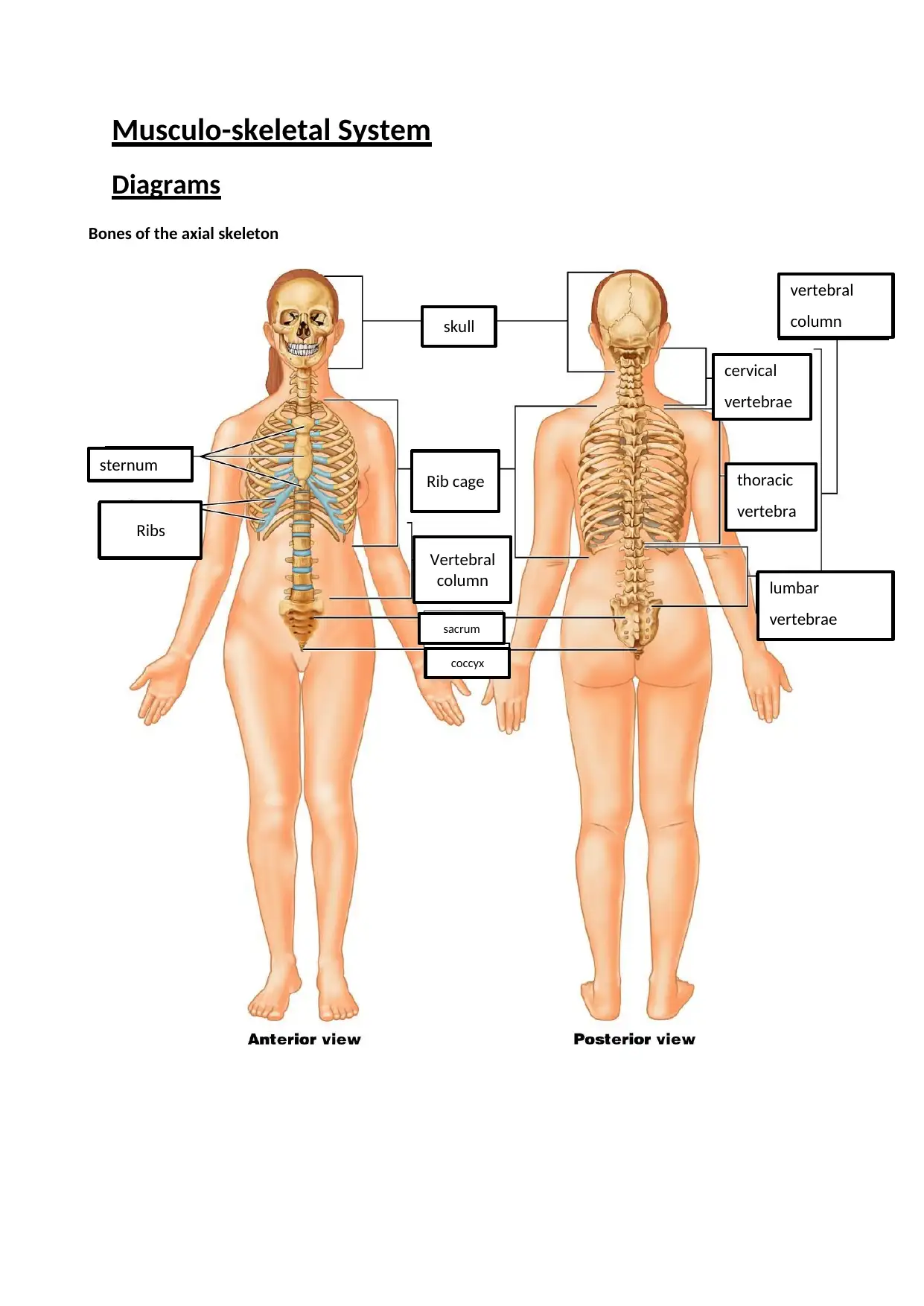
Musculo-skeletal System
Diagrams
Bones of the axial skeleton
skull
sternum
Ribs
Rib cage
Vertebral
column
sacrum
coccyx
lumbar
vertebrae
thoracic
vertebra
e
cervical
vertebrae
vertebral
column
Diagrams
Bones of the axial skeleton
skull
sternum
Ribs
Rib cage
Vertebral
column
sacrum
coccyx
lumbar
vertebrae
thoracic
vertebra
e
cervical
vertebrae
vertebral
column
Paraphrase This Document
Need a fresh take? Get an instant paraphrase of this document with our AI Paraphraser
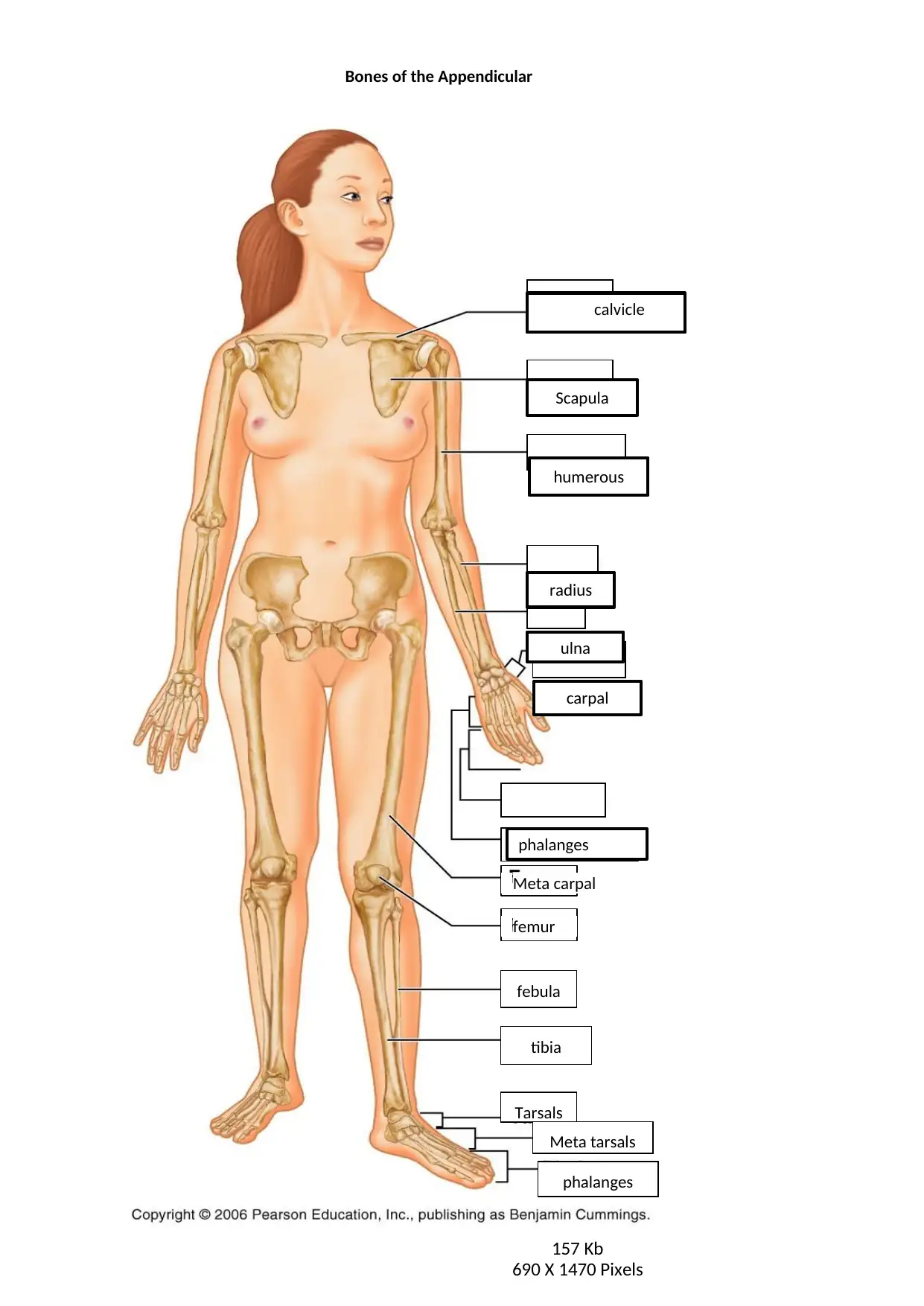
febula
tibia
Tarsals
Meta tarsals
phalanges
Bones of the Appendicular
Meta carpal
femur
157 Kb
690 X 1470 Pixels
calvicle
Scapula
humerous
radius
ulna
carpal
phalanges
tibia
Tarsals
Meta tarsals
phalanges
Bones of the Appendicular
Meta carpal
femur
157 Kb
690 X 1470 Pixels
calvicle
Scapula
humerous
radius
ulna
carpal
phalanges
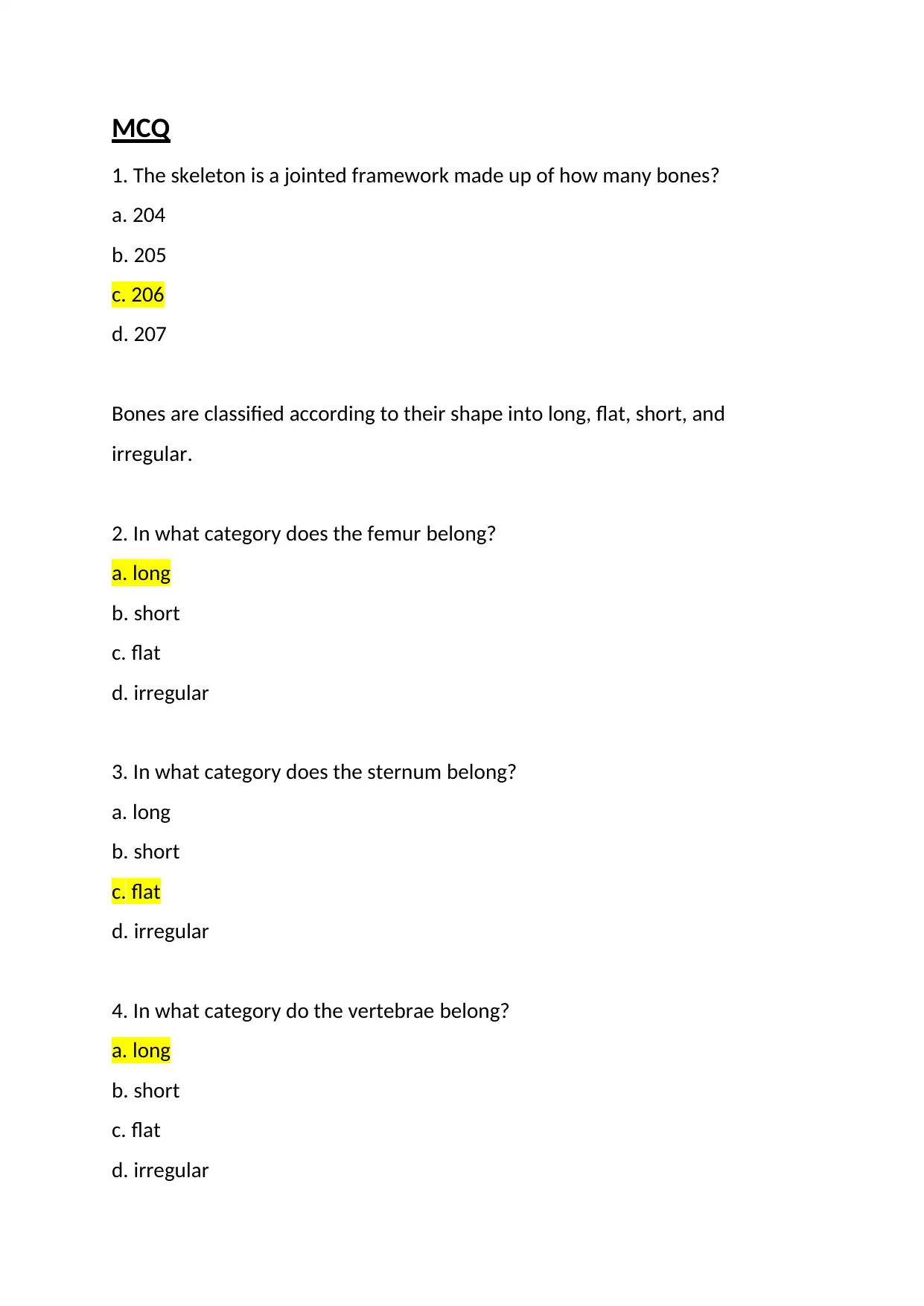
MCQ
1. The skeleton is a jointed framework made up of how many bones?
a. 204
b. 205
c. 206
d. 207
Bones are classified according to their shape into long, flat, short, and
irregular.
2. In what category does the femur belong?
a. long
b. short
c. flat
d. irregular
3. In what category does the sternum belong?
a. long
b. short
c. flat
d. irregular
4. In what category do the vertebrae belong?
a. long
b. short
c. flat
d. irregular
1. The skeleton is a jointed framework made up of how many bones?
a. 204
b. 205
c. 206
d. 207
Bones are classified according to their shape into long, flat, short, and
irregular.
2. In what category does the femur belong?
a. long
b. short
c. flat
d. irregular
3. In what category does the sternum belong?
a. long
b. short
c. flat
d. irregular
4. In what category do the vertebrae belong?
a. long
b. short
c. flat
d. irregular
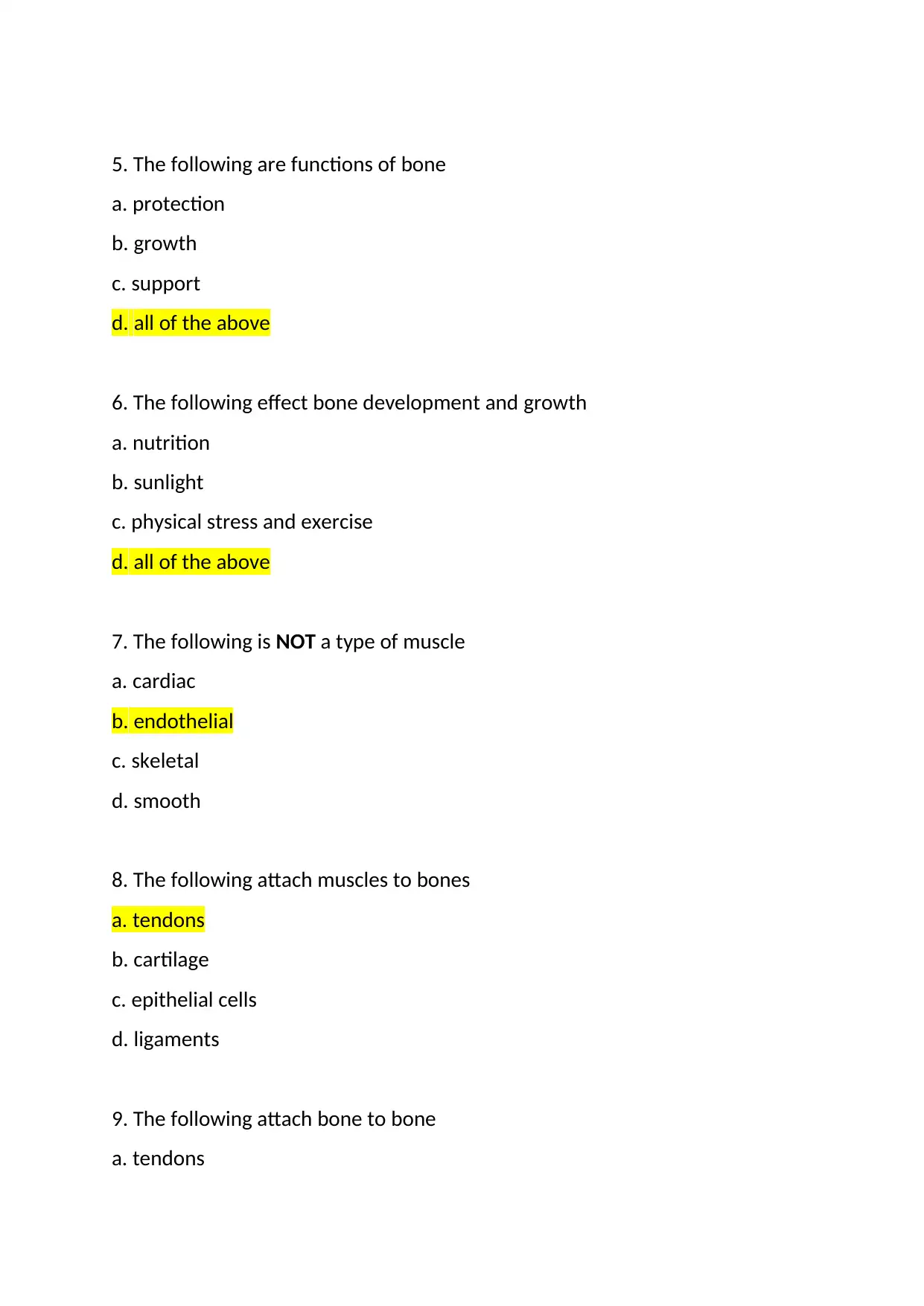
5. The following are functions of bone
a. protection
b. growth
c. support
d. all of the above
6. The following effect bone development and growth
a. nutrition
b. sunlight
c. physical stress and exercise
d. all of the above
7. The following is NOT a type of muscle
a. cardiac
b. endothelial
c. skeletal
d. smooth
8. The following attach muscles to bones
a. tendons
b. cartilage
c. epithelial cells
d. ligaments
9. The following attach bone to bone
a. tendons
a. protection
b. growth
c. support
d. all of the above
6. The following effect bone development and growth
a. nutrition
b. sunlight
c. physical stress and exercise
d. all of the above
7. The following is NOT a type of muscle
a. cardiac
b. endothelial
c. skeletal
d. smooth
8. The following attach muscles to bones
a. tendons
b. cartilage
c. epithelial cells
d. ligaments
9. The following attach bone to bone
a. tendons
Secure Best Marks with AI Grader
Need help grading? Try our AI Grader for instant feedback on your assignments.
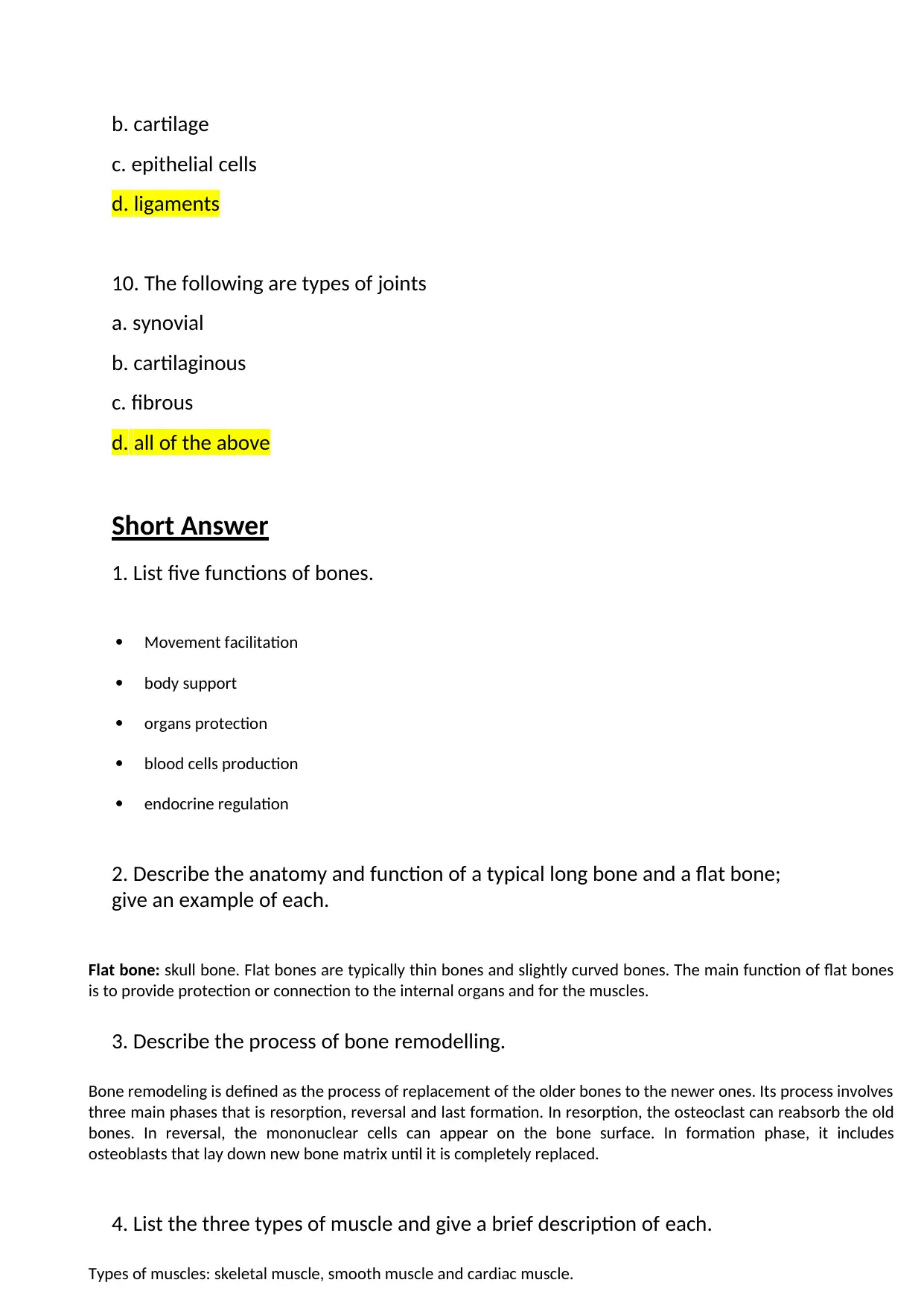
b. cartilage
c. epithelial cells
d. ligaments
10. The following are types of joints
a. synovial
b. cartilaginous
c. fibrous
d. all of the above
Short Answer
1. List five functions of bones.
Movement facilitation
body support
organs protection
blood cells production
endocrine regulation
2. Describe the anatomy and function of a typical long bone and a flat bone;
give an example of each.
Flat bone: skull bone. Flat bones are typically thin bones and slightly curved bones. The main function of flat bones
is to provide protection or connection to the internal organs and for the muscles.
3. Describe the process of bone remodelling.
Bone remodeling is defined as the process of replacement of the older bones to the newer ones. Its process involves
three main phases that is resorption, reversal and last formation. In resorption, the osteoclast can reabsorb the old
bones. In reversal, the mononuclear cells can appear on the bone surface. In formation phase, it includes
osteoblasts that lay down new bone matrix until it is completely replaced.
4. List the three types of muscle and give a brief description of each.
Types of muscles: skeletal muscle, smooth muscle and cardiac muscle.
c. epithelial cells
d. ligaments
10. The following are types of joints
a. synovial
b. cartilaginous
c. fibrous
d. all of the above
Short Answer
1. List five functions of bones.
Movement facilitation
body support
organs protection
blood cells production
endocrine regulation
2. Describe the anatomy and function of a typical long bone and a flat bone;
give an example of each.
Flat bone: skull bone. Flat bones are typically thin bones and slightly curved bones. The main function of flat bones
is to provide protection or connection to the internal organs and for the muscles.
3. Describe the process of bone remodelling.
Bone remodeling is defined as the process of replacement of the older bones to the newer ones. Its process involves
three main phases that is resorption, reversal and last formation. In resorption, the osteoclast can reabsorb the old
bones. In reversal, the mononuclear cells can appear on the bone surface. In formation phase, it includes
osteoblasts that lay down new bone matrix until it is completely replaced.
4. List the three types of muscle and give a brief description of each.
Types of muscles: skeletal muscle, smooth muscle and cardiac muscle.
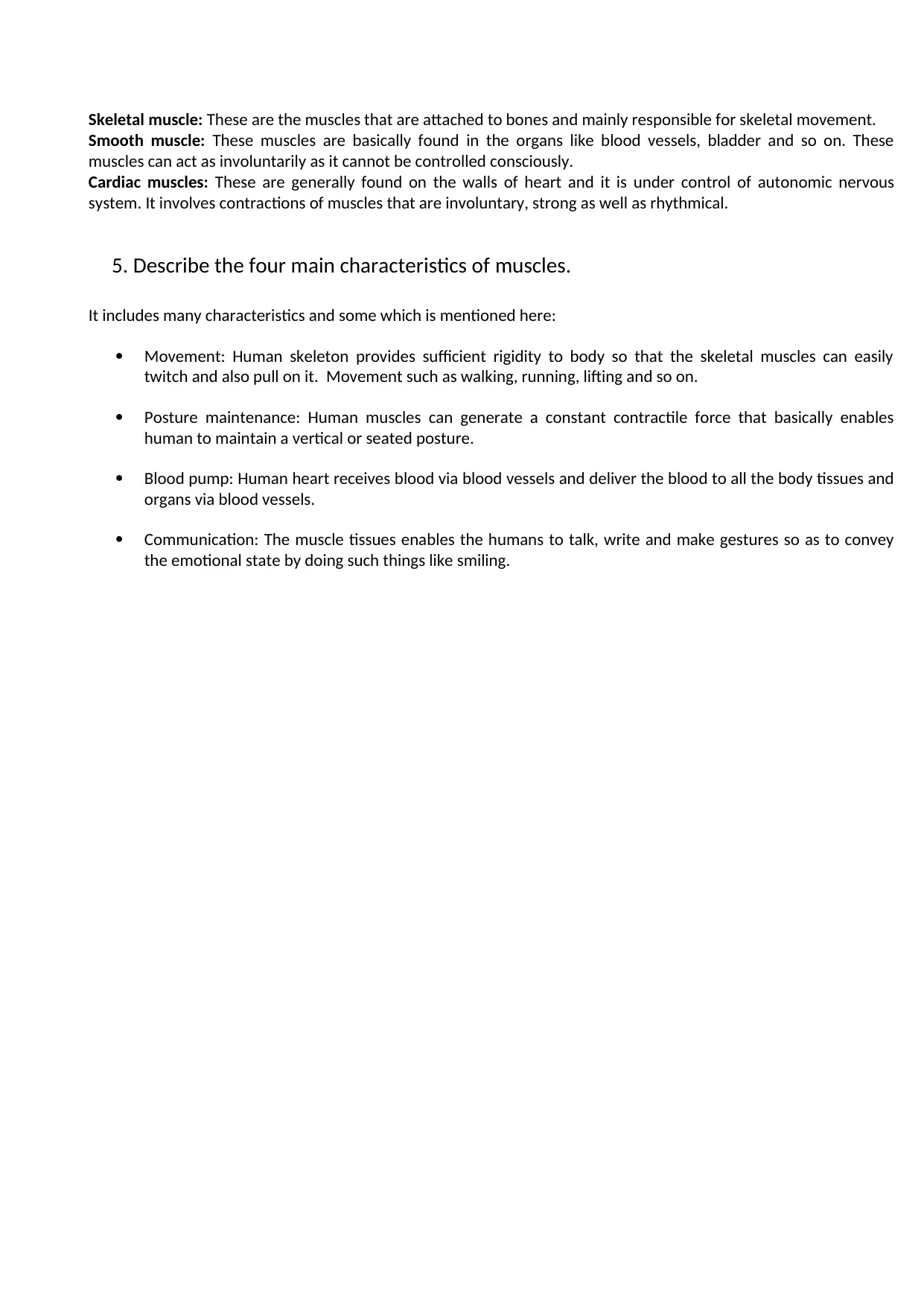
Skeletal muscle: These are the muscles that are attached to bones and mainly responsible for skeletal movement.
Smooth muscle: These muscles are basically found in the organs like blood vessels, bladder and so on. These
muscles can act as involuntarily as it cannot be controlled consciously.
Cardiac muscles: These are generally found on the walls of heart and it is under control of autonomic nervous
system. It involves contractions of muscles that are involuntary, strong as well as rhythmical.
5. Describe the four main characteristics of muscles.
It includes many characteristics and some which is mentioned here:
Movement: Human skeleton provides sufficient rigidity to body so that the skeletal muscles can easily
twitch and also pull on it. Movement such as walking, running, lifting and so on.
Posture maintenance: Human muscles can generate a constant contractile force that basically enables
human to maintain a vertical or seated posture.
Blood pump: Human heart receives blood via blood vessels and deliver the blood to all the body tissues and
organs via blood vessels.
Communication: The muscle tissues enables the humans to talk, write and make gestures so as to convey
the emotional state by doing such things like smiling.
Smooth muscle: These muscles are basically found in the organs like blood vessels, bladder and so on. These
muscles can act as involuntarily as it cannot be controlled consciously.
Cardiac muscles: These are generally found on the walls of heart and it is under control of autonomic nervous
system. It involves contractions of muscles that are involuntary, strong as well as rhythmical.
5. Describe the four main characteristics of muscles.
It includes many characteristics and some which is mentioned here:
Movement: Human skeleton provides sufficient rigidity to body so that the skeletal muscles can easily
twitch and also pull on it. Movement such as walking, running, lifting and so on.
Posture maintenance: Human muscles can generate a constant contractile force that basically enables
human to maintain a vertical or seated posture.
Blood pump: Human heart receives blood via blood vessels and deliver the blood to all the body tissues and
organs via blood vessels.
Communication: The muscle tissues enables the humans to talk, write and make gestures so as to convey
the emotional state by doing such things like smiling.
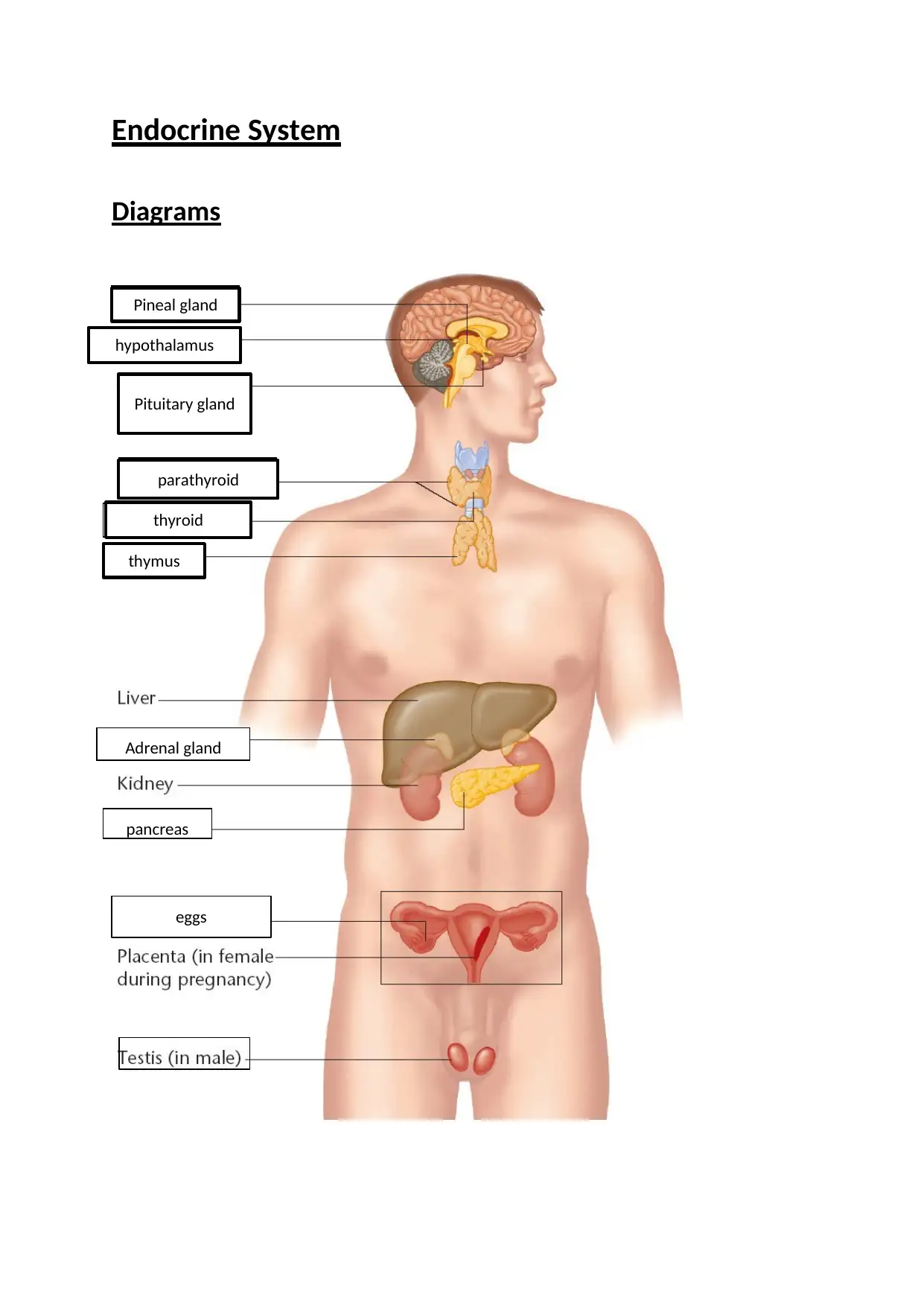
Endocrine System
Diagrams
Adrenal gland
pancreas
eggs
Pineal gland
hypothalamus
Pituitary gland
parathyroid
thyroid
thymus
Diagrams
Adrenal gland
pancreas
eggs
Pineal gland
hypothalamus
Pituitary gland
parathyroid
thyroid
thymus
Paraphrase This Document
Need a fresh take? Get an instant paraphrase of this document with our AI Paraphraser
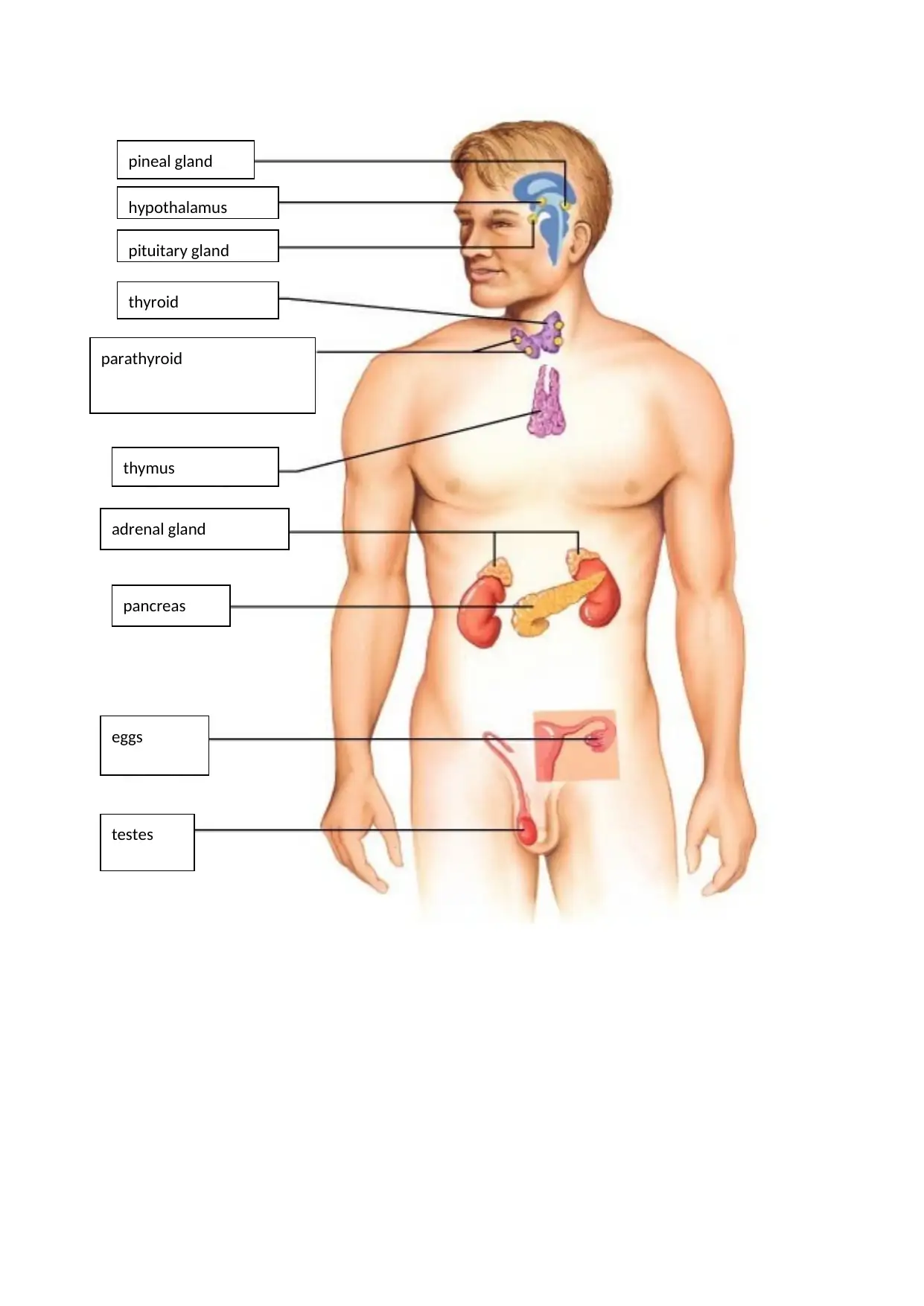
pineal gland
hypothalamus
pituitary gland
thyroid
parathyroid
thymus
adrenal gland
pancreas
eggs
testes
hypothalamus
pituitary gland
thyroid
parathyroid
thymus
adrenal gland
pancreas
eggs
testes
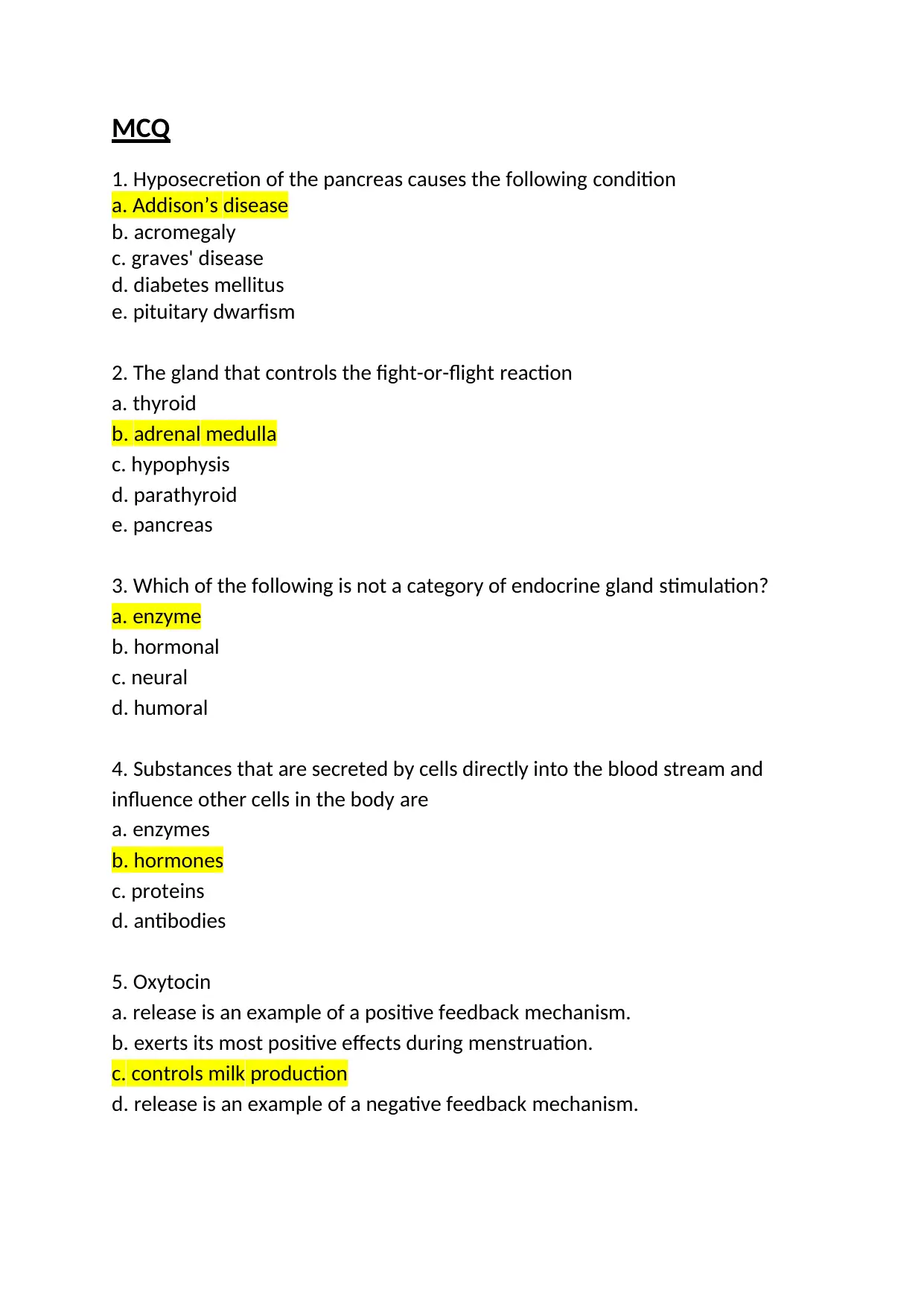
MCQ
1. Hyposecretion of the pancreas causes the following condition
a. Addison’s disease
b. acromegaly
c. graves' disease
d. diabetes mellitus
e. pituitary dwarfism
2. The gland that controls the fight-or-flight reaction
a. thyroid
b. adrenal medulla
c. hypophysis
d. parathyroid
e. pancreas
3. Which of the following is not a category of endocrine gland stimulation?
a. enzyme
b. hormonal
c. neural
d. humoral
4. Substances that are secreted by cells directly into the blood stream and
influence other cells in the body are
a. enzymes
b. hormones
c. proteins
d. antibodies
5. Oxytocin
a. release is an example of a positive feedback mechanism.
b. exerts its most positive effects during menstruation.
c. controls milk production
d. release is an example of a negative feedback mechanism.
1. Hyposecretion of the pancreas causes the following condition
a. Addison’s disease
b. acromegaly
c. graves' disease
d. diabetes mellitus
e. pituitary dwarfism
2. The gland that controls the fight-or-flight reaction
a. thyroid
b. adrenal medulla
c. hypophysis
d. parathyroid
e. pancreas
3. Which of the following is not a category of endocrine gland stimulation?
a. enzyme
b. hormonal
c. neural
d. humoral
4. Substances that are secreted by cells directly into the blood stream and
influence other cells in the body are
a. enzymes
b. hormones
c. proteins
d. antibodies
5. Oxytocin
a. release is an example of a positive feedback mechanism.
b. exerts its most positive effects during menstruation.
c. controls milk production
d. release is an example of a negative feedback mechanism.

6. ADH
a. increases urine production
b. promotes dehydration.
c. works on the pancreas.
d. decreases urine production
7. The major hormone released in the fight - or - flight syndrome is
a. thyroxine
b. adrenaline
c. antidiuretic hormone
d. melatonin
8. The major target organs of the human growth hormone are
a. blood vessels
c. adrenal glands
c. the liver
d. bones and skeletal muscle
9. Which of the following organs does not have a hormone producing capacity
a. the heart
b. the liver
c. the skin
d. the kidneys
10. Glucocorticoids enable the body to appropriately deal with stress. They do
this by
a. increasing blood glucose and enhancing blood pressure.
b. decreasing the heart rate and therefore the blood pressure.
c. stimulating the pancreas to secrete insulin.
d. blocking the neurotransmitters that allow the body to cope with stress.
a. increases urine production
b. promotes dehydration.
c. works on the pancreas.
d. decreases urine production
7. The major hormone released in the fight - or - flight syndrome is
a. thyroxine
b. adrenaline
c. antidiuretic hormone
d. melatonin
8. The major target organs of the human growth hormone are
a. blood vessels
c. adrenal glands
c. the liver
d. bones and skeletal muscle
9. Which of the following organs does not have a hormone producing capacity
a. the heart
b. the liver
c. the skin
d. the kidneys
10. Glucocorticoids enable the body to appropriately deal with stress. They do
this by
a. increasing blood glucose and enhancing blood pressure.
b. decreasing the heart rate and therefore the blood pressure.
c. stimulating the pancreas to secrete insulin.
d. blocking the neurotransmitters that allow the body to cope with stress.
Secure Best Marks with AI Grader
Need help grading? Try our AI Grader for instant feedback on your assignments.
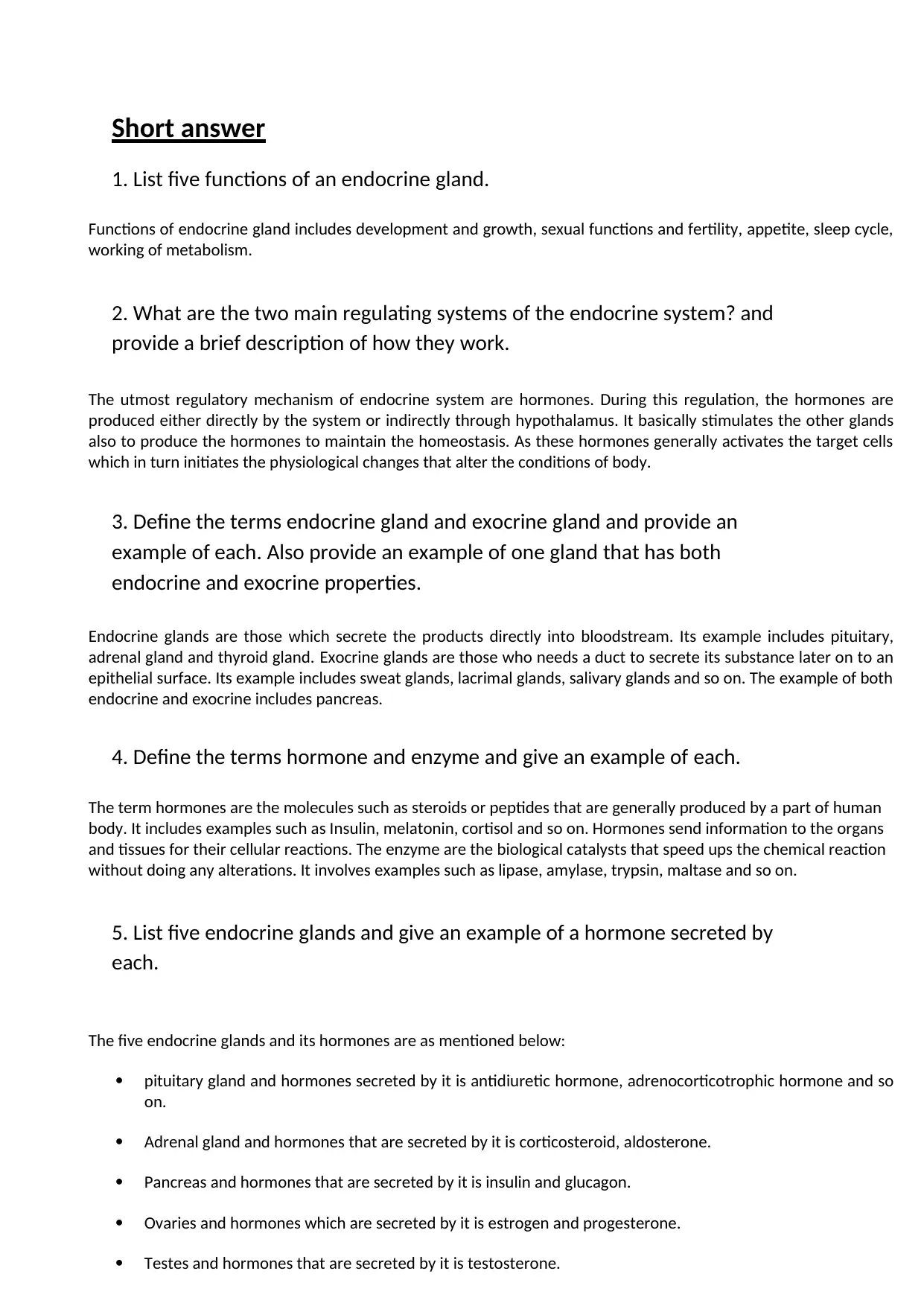
Short answer
1. List five functions of an endocrine gland.
Functions of endocrine gland includes development and growth, sexual functions and fertility, appetite, sleep cycle,
working of metabolism.
2. What are the two main regulating systems of the endocrine system? and
provide a brief description of how they work.
The utmost regulatory mechanism of endocrine system are hormones. During this regulation, the hormones are
produced either directly by the system or indirectly through hypothalamus. It basically stimulates the other glands
also to produce the hormones to maintain the homeostasis. As these hormones generally activates the target cells
which in turn initiates the physiological changes that alter the conditions of body.
3. Define the terms endocrine gland and exocrine gland and provide an
example of each. Also provide an example of one gland that has both
endocrine and exocrine properties.
Endocrine glands are those which secrete the products directly into bloodstream. Its example includes pituitary,
adrenal gland and thyroid gland. Exocrine glands are those who needs a duct to secrete its substance later on to an
epithelial surface. Its example includes sweat glands, lacrimal glands, salivary glands and so on. The example of both
endocrine and exocrine includes pancreas.
4. Define the terms hormone and enzyme and give an example of each.
The term hormones are the molecules such as steroids or peptides that are generally produced by a part of human
body. It includes examples such as Insulin, melatonin, cortisol and so on. Hormones send information to the organs
and tissues for their cellular reactions. The enzyme are the biological catalysts that speed ups the chemical reaction
without doing any alterations. It involves examples such as lipase, amylase, trypsin, maltase and so on.
5. List five endocrine glands and give an example of a hormone secreted by
each.
The five endocrine glands and its hormones are as mentioned below:
pituitary gland and hormones secreted by it is antidiuretic hormone, adrenocorticotrophic hormone and so
on.
Adrenal gland and hormones that are secreted by it is corticosteroid, aldosterone.
Pancreas and hormones that are secreted by it is insulin and glucagon.
Ovaries and hormones which are secreted by it is estrogen and progesterone.
Testes and hormones that are secreted by it is testosterone.
1. List five functions of an endocrine gland.
Functions of endocrine gland includes development and growth, sexual functions and fertility, appetite, sleep cycle,
working of metabolism.
2. What are the two main regulating systems of the endocrine system? and
provide a brief description of how they work.
The utmost regulatory mechanism of endocrine system are hormones. During this regulation, the hormones are
produced either directly by the system or indirectly through hypothalamus. It basically stimulates the other glands
also to produce the hormones to maintain the homeostasis. As these hormones generally activates the target cells
which in turn initiates the physiological changes that alter the conditions of body.
3. Define the terms endocrine gland and exocrine gland and provide an
example of each. Also provide an example of one gland that has both
endocrine and exocrine properties.
Endocrine glands are those which secrete the products directly into bloodstream. Its example includes pituitary,
adrenal gland and thyroid gland. Exocrine glands are those who needs a duct to secrete its substance later on to an
epithelial surface. Its example includes sweat glands, lacrimal glands, salivary glands and so on. The example of both
endocrine and exocrine includes pancreas.
4. Define the terms hormone and enzyme and give an example of each.
The term hormones are the molecules such as steroids or peptides that are generally produced by a part of human
body. It includes examples such as Insulin, melatonin, cortisol and so on. Hormones send information to the organs
and tissues for their cellular reactions. The enzyme are the biological catalysts that speed ups the chemical reaction
without doing any alterations. It involves examples such as lipase, amylase, trypsin, maltase and so on.
5. List five endocrine glands and give an example of a hormone secreted by
each.
The five endocrine glands and its hormones are as mentioned below:
pituitary gland and hormones secreted by it is antidiuretic hormone, adrenocorticotrophic hormone and so
on.
Adrenal gland and hormones that are secreted by it is corticosteroid, aldosterone.
Pancreas and hormones that are secreted by it is insulin and glucagon.
Ovaries and hormones which are secreted by it is estrogen and progesterone.
Testes and hormones that are secreted by it is testosterone.
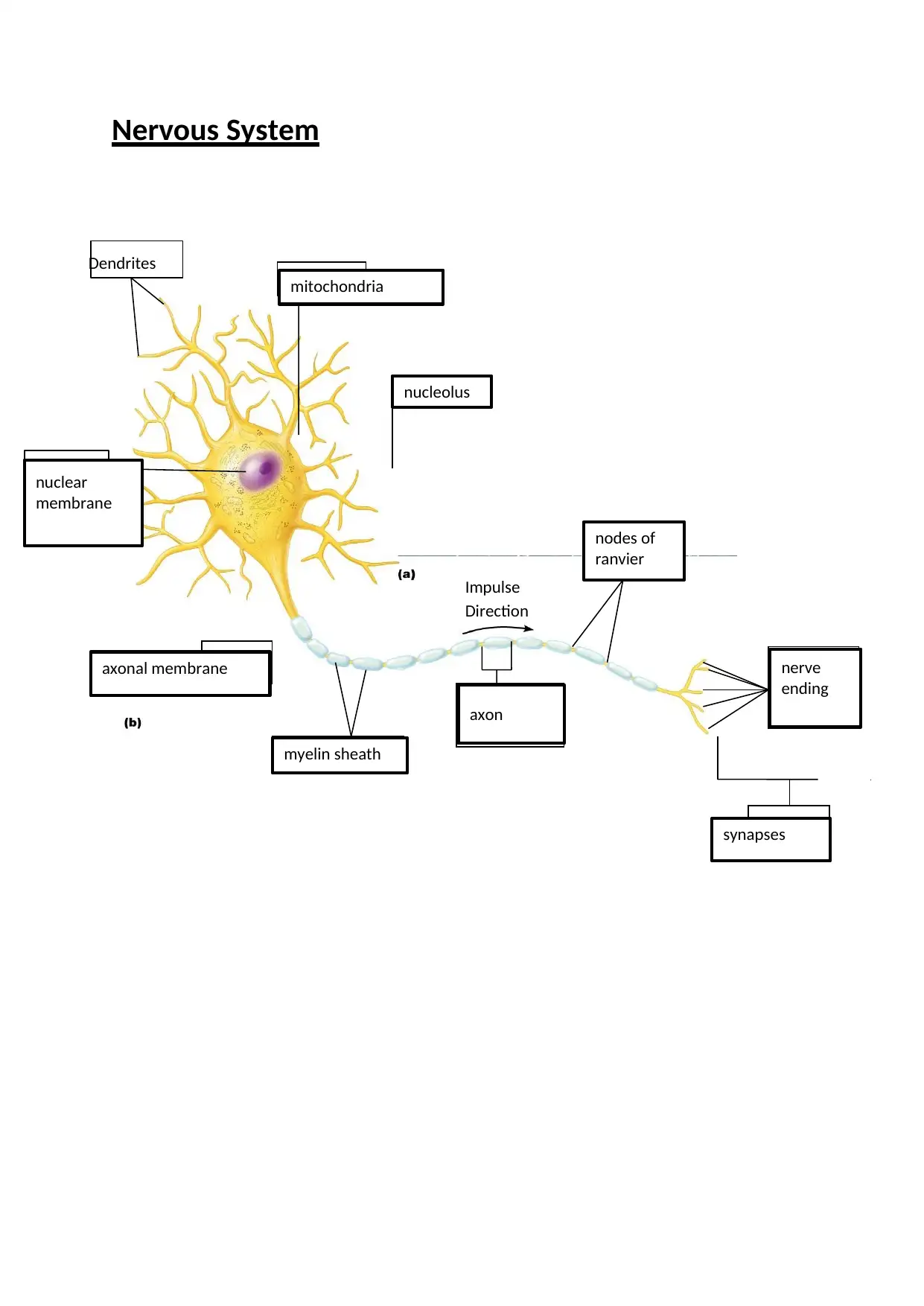
Nervous System
Dendrites
Impulse
Direction
mitochondria
nuclear
membrane
axonal membrane
nucleolus
myelin sheath
axon
nodes of
ranvier
nerve
ending
synapses
Dendrites
Impulse
Direction
mitochondria
nuclear
membrane
axonal membrane
nucleolus
myelin sheath
axon
nodes of
ranvier
nerve
ending
synapses
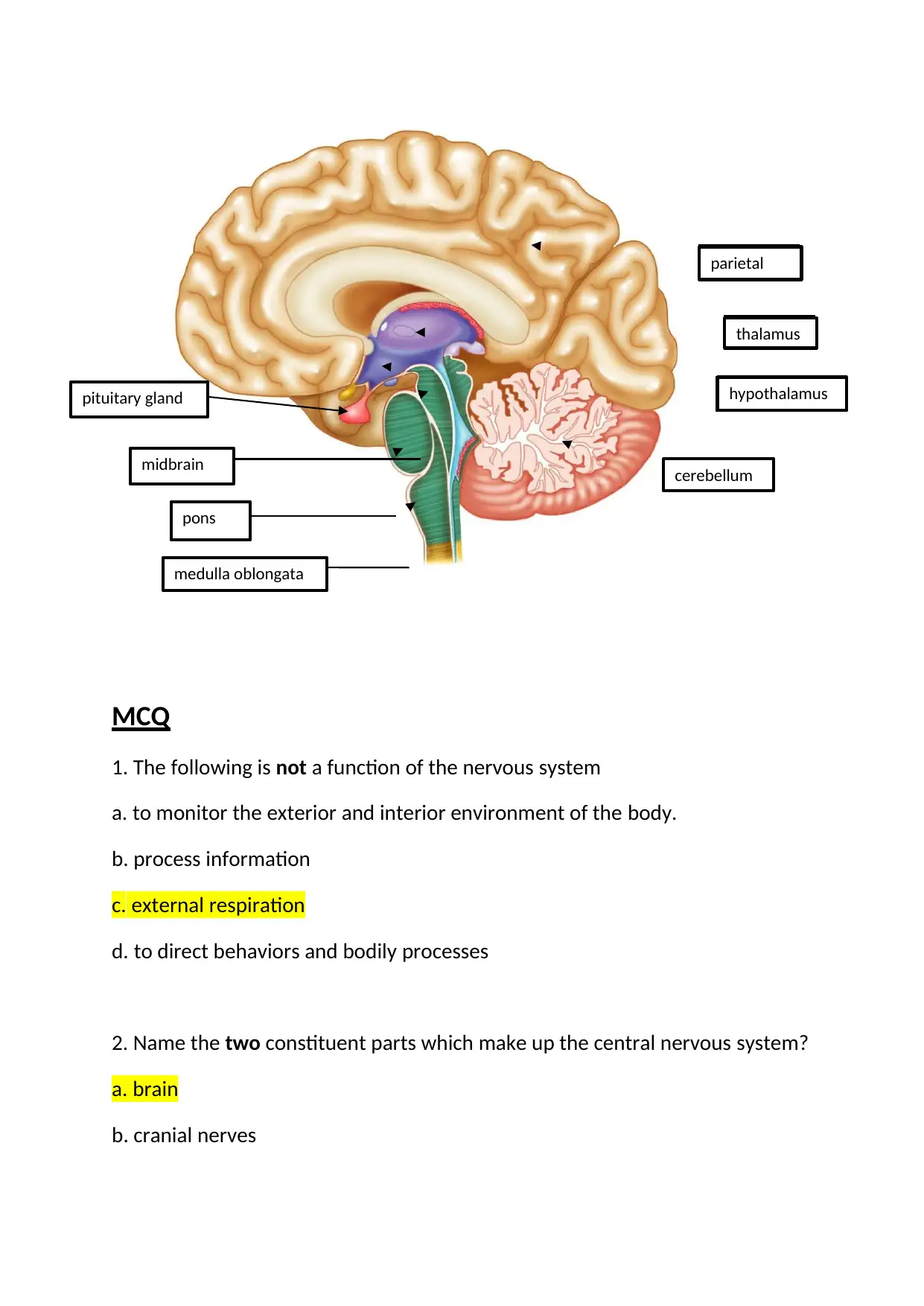
MCQ
1. The following is not a function of the nervous system
a. to monitor the exterior and interior environment of the body.
b. process information
c. external respiration
d. to direct behaviors and bodily processes
2. Name the two constituent parts which make up the central nervous system?
a. brain
b. cranial nerves
parietal
lobe
pituitary gland
midbrain
pons
medulla oblongata
cerebellum
hypothalamus
thalamus
1. The following is not a function of the nervous system
a. to monitor the exterior and interior environment of the body.
b. process information
c. external respiration
d. to direct behaviors and bodily processes
2. Name the two constituent parts which make up the central nervous system?
a. brain
b. cranial nerves
parietal
lobe
pituitary gland
midbrain
pons
medulla oblongata
cerebellum
hypothalamus
thalamus
Paraphrase This Document
Need a fresh take? Get an instant paraphrase of this document with our AI Paraphraser
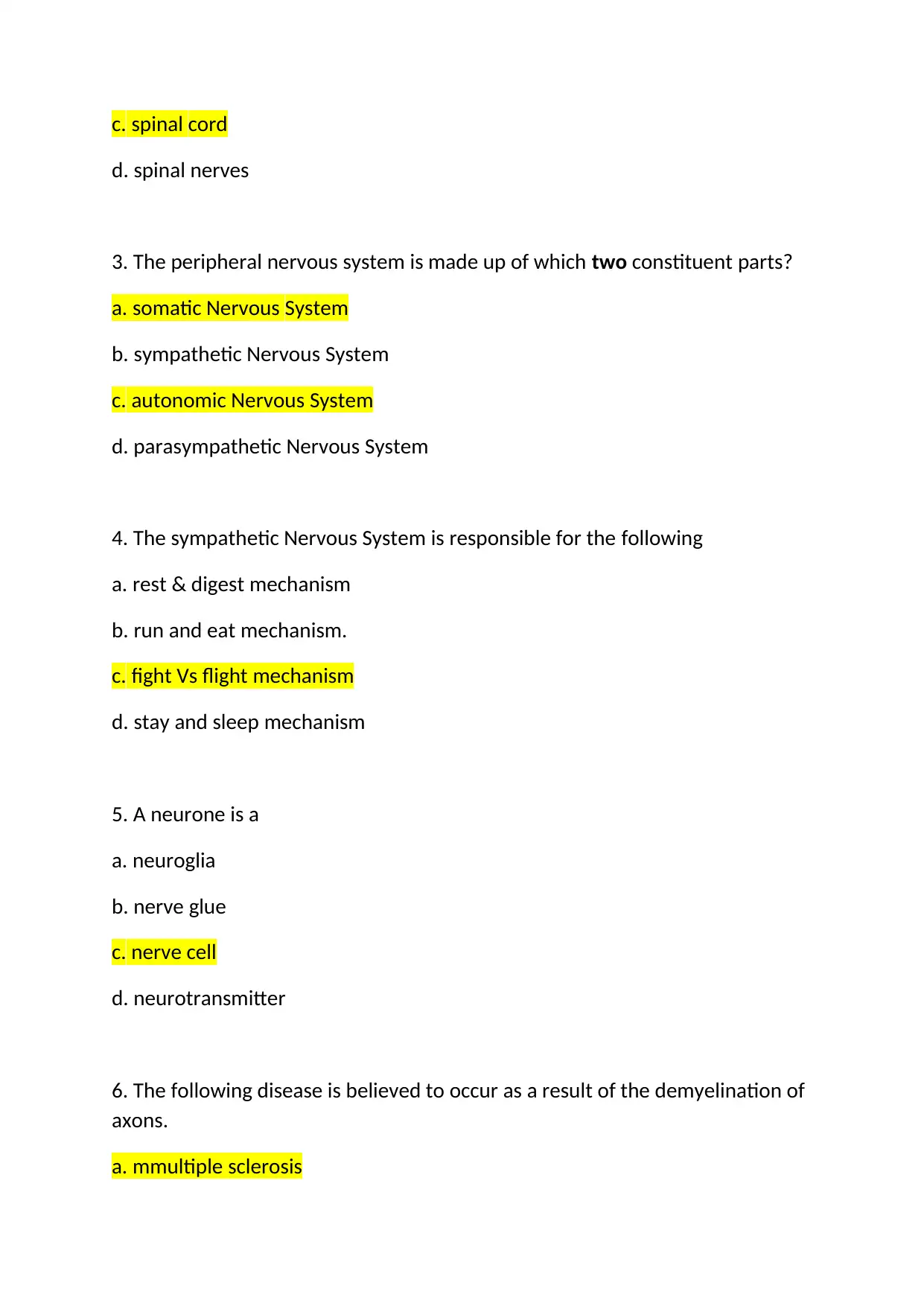
c. spinal cord
d. spinal nerves
3. The peripheral nervous system is made up of which two constituent parts?
a. somatic Nervous System
b. sympathetic Nervous System
c. autonomic Nervous System
d. parasympathetic Nervous System
4. The sympathetic Nervous System is responsible for the following
a. rest & digest mechanism
b. run and eat mechanism.
c. fight Vs flight mechanism
d. stay and sleep mechanism
5. A neurone is a
a. neuroglia
b. nerve glue
c. nerve cell
d. neurotransmitter
6. The following disease is believed to occur as a result of the demyelination of
axons.
a. mmultiple sclerosis
d. spinal nerves
3. The peripheral nervous system is made up of which two constituent parts?
a. somatic Nervous System
b. sympathetic Nervous System
c. autonomic Nervous System
d. parasympathetic Nervous System
4. The sympathetic Nervous System is responsible for the following
a. rest & digest mechanism
b. run and eat mechanism.
c. fight Vs flight mechanism
d. stay and sleep mechanism
5. A neurone is a
a. neuroglia
b. nerve glue
c. nerve cell
d. neurotransmitter
6. The following disease is believed to occur as a result of the demyelination of
axons.
a. mmultiple sclerosis

b. Alzheimer’s
c. Parkinson’s disease
d. attention deficit hyperactivity disorder
7. Which of the following does not offer protection to the brain?
a. scalp
b. dura mater
c. ventricles of the brain
d. Pia mater
8. Which of the following would you observe in a patient with a tumour of the
cerebellum?
a. loss of general sensation
b. balance impairment
c. no heartbeat
d. great sex drive
9. There are how many spinal vertebrae in the human body?
a. 31
b. 32
c. 33
d. 34
c. Parkinson’s disease
d. attention deficit hyperactivity disorder
7. Which of the following does not offer protection to the brain?
a. scalp
b. dura mater
c. ventricles of the brain
d. Pia mater
8. Which of the following would you observe in a patient with a tumour of the
cerebellum?
a. loss of general sensation
b. balance impairment
c. no heartbeat
d. great sex drive
9. There are how many spinal vertebrae in the human body?
a. 31
b. 32
c. 33
d. 34
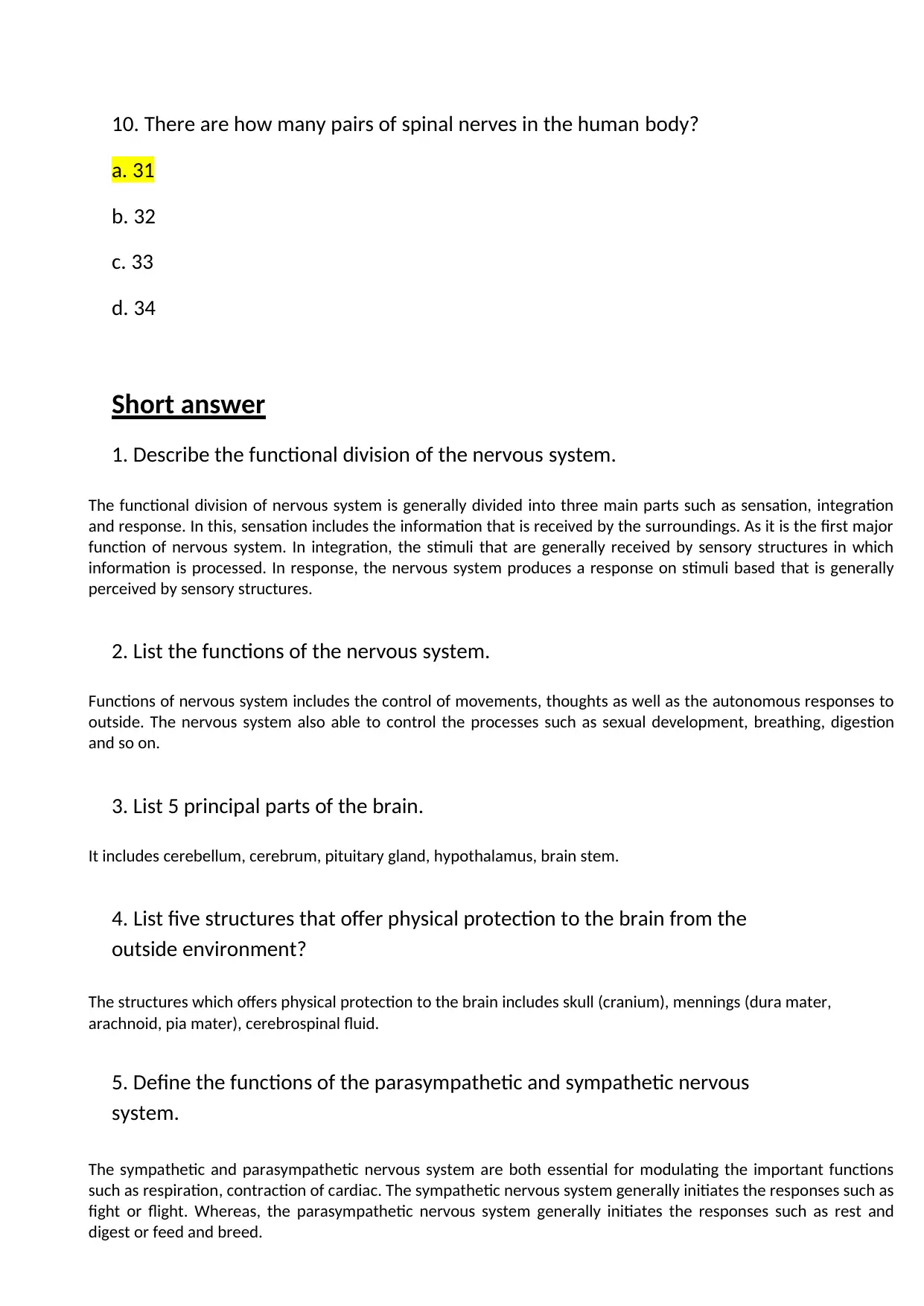
10. There are how many pairs of spinal nerves in the human body?
a. 31
b. 32
c. 33
d. 34
Short answer
1. Describe the functional division of the nervous system.
The functional division of nervous system is generally divided into three main parts such as sensation, integration
and response. In this, sensation includes the information that is received by the surroundings. As it is the first major
function of nervous system. In integration, the stimuli that are generally received by sensory structures in which
information is processed. In response, the nervous system produces a response on stimuli based that is generally
perceived by sensory structures.
2. List the functions of the nervous system.
Functions of nervous system includes the control of movements, thoughts as well as the autonomous responses to
outside. The nervous system also able to control the processes such as sexual development, breathing, digestion
and so on.
3. List 5 principal parts of the brain.
It includes cerebellum, cerebrum, pituitary gland, hypothalamus, brain stem.
4. List five structures that offer physical protection to the brain from the
outside environment?
The structures which offers physical protection to the brain includes skull (cranium), mennings (dura mater,
arachnoid, pia mater), cerebrospinal fluid.
5. Define the functions of the parasympathetic and sympathetic nervous
system.
The sympathetic and parasympathetic nervous system are both essential for modulating the important functions
such as respiration, contraction of cardiac. The sympathetic nervous system generally initiates the responses such as
fight or flight. Whereas, the parasympathetic nervous system generally initiates the responses such as rest and
digest or feed and breed.
a. 31
b. 32
c. 33
d. 34
Short answer
1. Describe the functional division of the nervous system.
The functional division of nervous system is generally divided into three main parts such as sensation, integration
and response. In this, sensation includes the information that is received by the surroundings. As it is the first major
function of nervous system. In integration, the stimuli that are generally received by sensory structures in which
information is processed. In response, the nervous system produces a response on stimuli based that is generally
perceived by sensory structures.
2. List the functions of the nervous system.
Functions of nervous system includes the control of movements, thoughts as well as the autonomous responses to
outside. The nervous system also able to control the processes such as sexual development, breathing, digestion
and so on.
3. List 5 principal parts of the brain.
It includes cerebellum, cerebrum, pituitary gland, hypothalamus, brain stem.
4. List five structures that offer physical protection to the brain from the
outside environment?
The structures which offers physical protection to the brain includes skull (cranium), mennings (dura mater,
arachnoid, pia mater), cerebrospinal fluid.
5. Define the functions of the parasympathetic and sympathetic nervous
system.
The sympathetic and parasympathetic nervous system are both essential for modulating the important functions
such as respiration, contraction of cardiac. The sympathetic nervous system generally initiates the responses such as
fight or flight. Whereas, the parasympathetic nervous system generally initiates the responses such as rest and
digest or feed and breed.
Secure Best Marks with AI Grader
Need help grading? Try our AI Grader for instant feedback on your assignments.
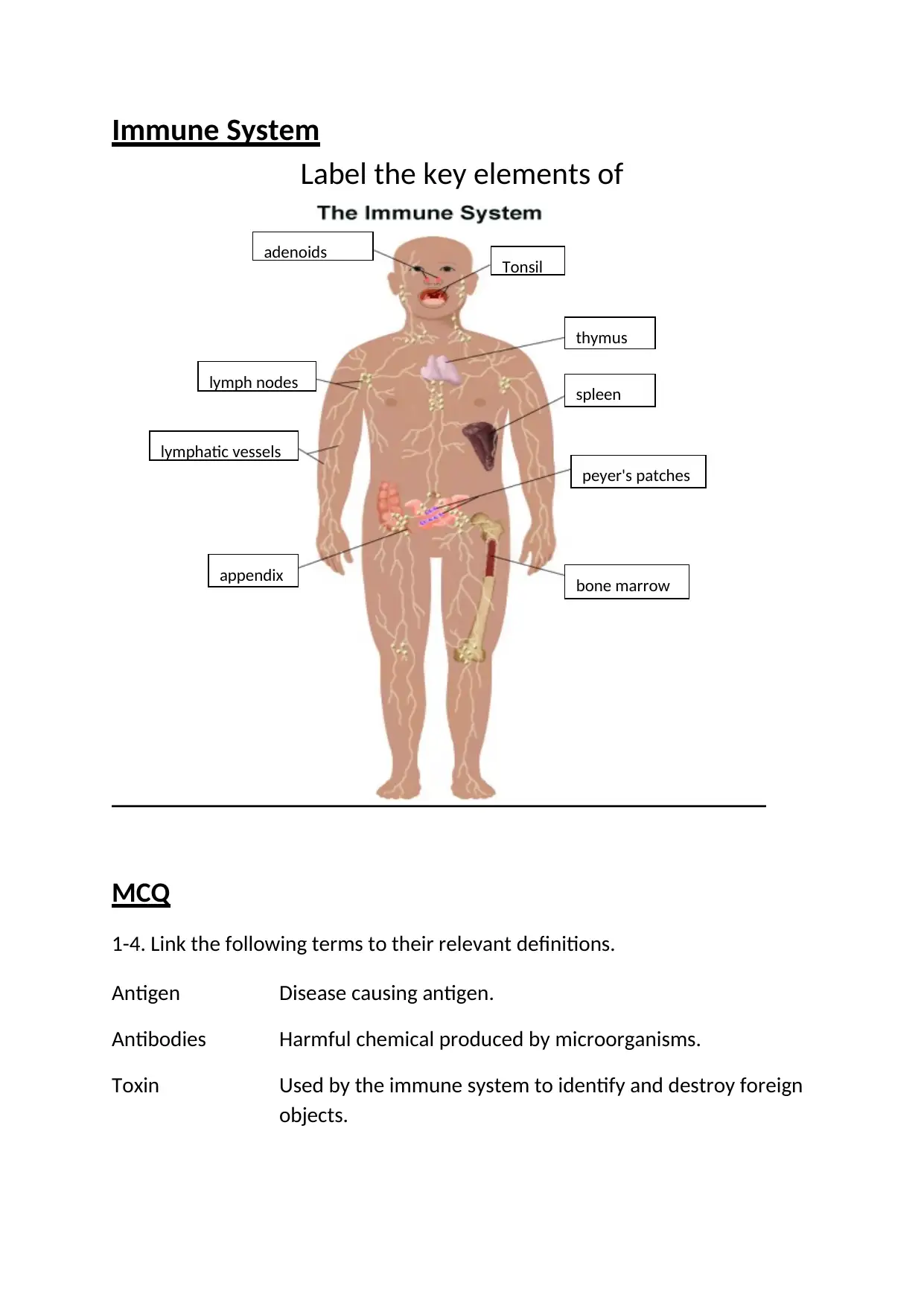
Immune System
Label the key elements of
MCQ
1-4. Link the following terms to their relevant definitions.
Antigen Disease causing antigen.
Antibodies Harmful chemical produced by microorganisms.
Toxin Used by the immune system to identify and destroy foreign
objects.
adenoids Tonsil
thymus
lymph nodes
lymphatic vessels
appendix
spleen
peyer's patches
bone marrow
Label the key elements of
MCQ
1-4. Link the following terms to their relevant definitions.
Antigen Disease causing antigen.
Antibodies Harmful chemical produced by microorganisms.
Toxin Used by the immune system to identify and destroy foreign
objects.
adenoids Tonsil
thymus
lymph nodes
lymphatic vessels
appendix
spleen
peyer's patches
bone marrow
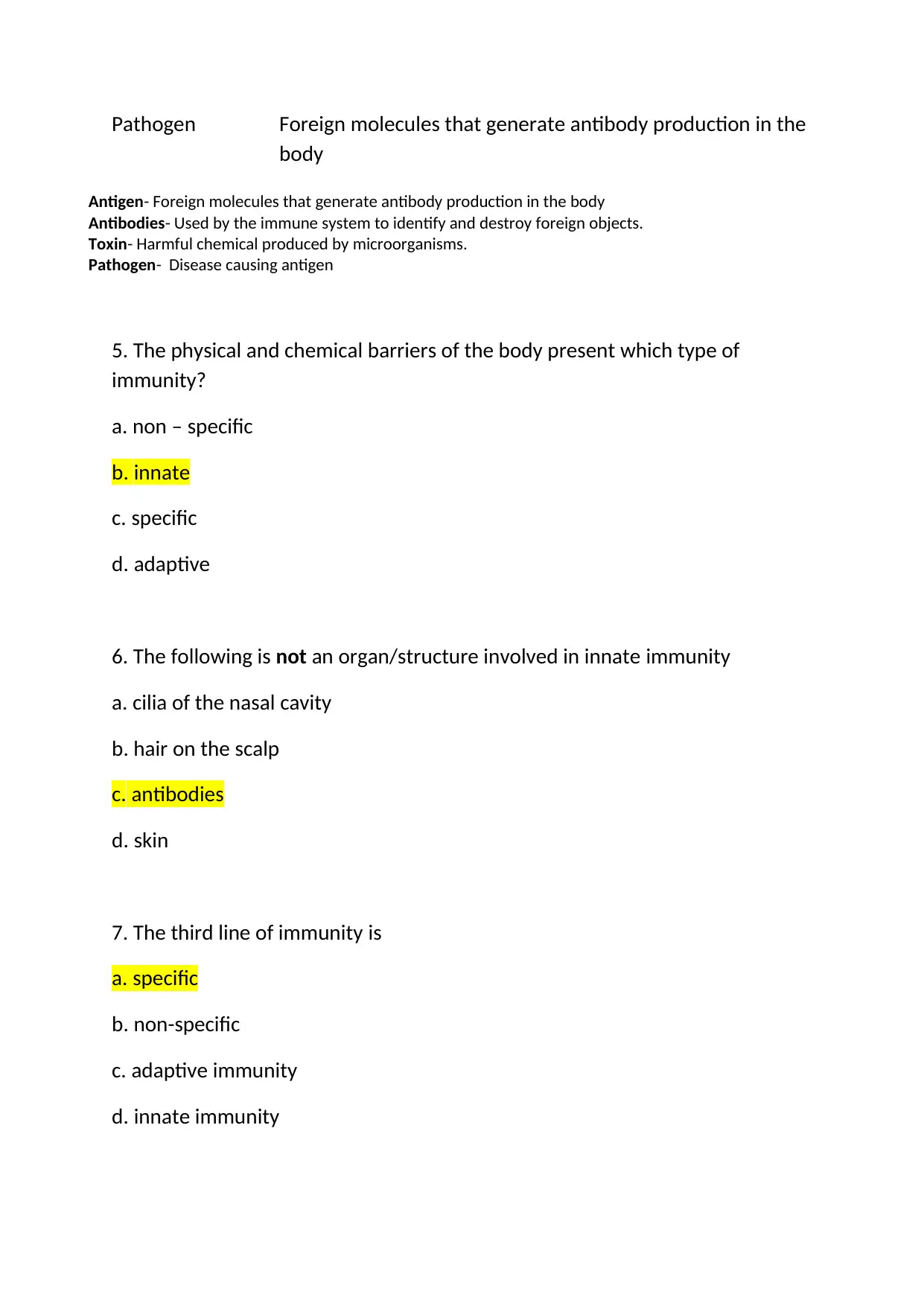
Pathogen Foreign molecules that generate antibody production in the
body
Antigen- Foreign molecules that generate antibody production in the body
Antibodies- Used by the immune system to identify and destroy foreign objects.
Toxin- Harmful chemical produced by microorganisms.
Pathogen- Disease causing antigen
5. The physical and chemical barriers of the body present which type of
immunity?
a. non – specific
b. innate
c. specific
d. adaptive
6. The following is not an organ/structure involved in innate immunity
a. cilia of the nasal cavity
b. hair on the scalp
c. antibodies
d. skin
7. The third line of immunity is
a. specific
b. non-specific
c. adaptive immunity
d. innate immunity
body
Antigen- Foreign molecules that generate antibody production in the body
Antibodies- Used by the immune system to identify and destroy foreign objects.
Toxin- Harmful chemical produced by microorganisms.
Pathogen- Disease causing antigen
5. The physical and chemical barriers of the body present which type of
immunity?
a. non – specific
b. innate
c. specific
d. adaptive
6. The following is not an organ/structure involved in innate immunity
a. cilia of the nasal cavity
b. hair on the scalp
c. antibodies
d. skin
7. The third line of immunity is
a. specific
b. non-specific
c. adaptive immunity
d. innate immunity
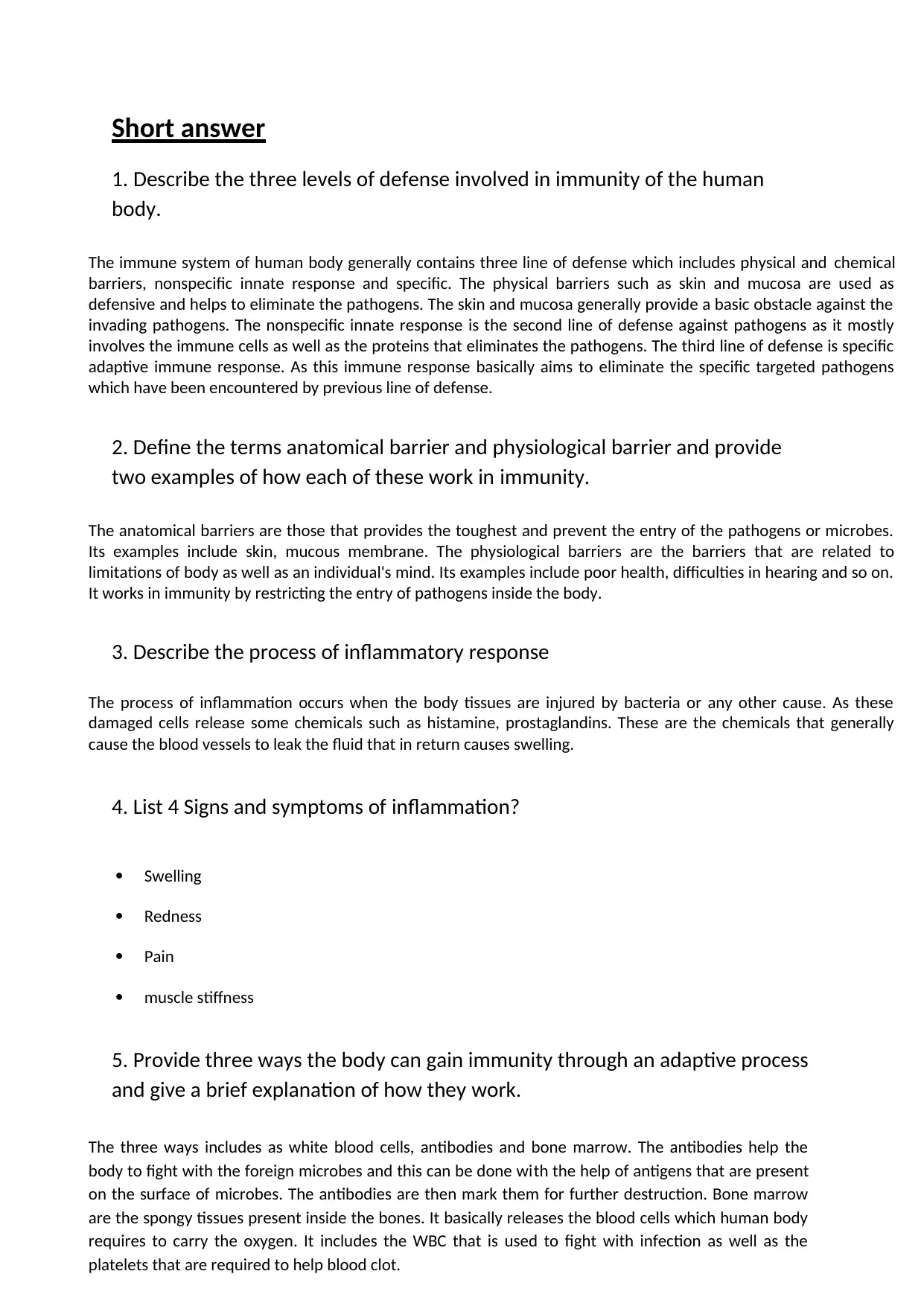
Short answer
1. Describe the three levels of defense involved in immunity of the human
body.
The immune system of human body generally contains three line of defense which includes physical and chemical
barriers, nonspecific innate response and specific. The physical barriers such as skin and mucosa are used as
defensive and helps to eliminate the pathogens. The skin and mucosa generally provide a basic obstacle against the
invading pathogens. The nonspecific innate response is the second line of defense against pathogens as it mostly
involves the immune cells as well as the proteins that eliminates the pathogens. The third line of defense is specific
adaptive immune response. As this immune response basically aims to eliminate the specific targeted pathogens
which have been encountered by previous line of defense.
2. Define the terms anatomical barrier and physiological barrier and provide
two examples of how each of these work in immunity.
The anatomical barriers are those that provides the toughest and prevent the entry of the pathogens or microbes.
Its examples include skin, mucous membrane. The physiological barriers are the barriers that are related to
limitations of body as well as an individual's mind. Its examples include poor health, difficulties in hearing and so on.
It works in immunity by restricting the entry of pathogens inside the body.
3. Describe the process of inflammatory response
The process of inflammation occurs when the body tissues are injured by bacteria or any other cause. As these
damaged cells release some chemicals such as histamine, prostaglandins. These are the chemicals that generally
cause the blood vessels to leak the fluid that in return causes swelling.
4. List 4 Signs and symptoms of inflammation?
Swelling
Redness
Pain
muscle stiffness
5. Provide three ways the body can gain immunity through an adaptive process
and give a brief explanation of how they work.
The three ways includes as white blood cells, antibodies and bone marrow. The antibodies help the
body to fight with the foreign microbes and this can be done with the help of antigens that are present
on the surface of microbes. The antibodies are then mark them for further destruction. Bone marrow
are the spongy tissues present inside the bones. It basically releases the blood cells which human body
requires to carry the oxygen. It includes the WBC that is used to fight with infection as well as the
platelets that are required to help blood clot.
1. Describe the three levels of defense involved in immunity of the human
body.
The immune system of human body generally contains three line of defense which includes physical and chemical
barriers, nonspecific innate response and specific. The physical barriers such as skin and mucosa are used as
defensive and helps to eliminate the pathogens. The skin and mucosa generally provide a basic obstacle against the
invading pathogens. The nonspecific innate response is the second line of defense against pathogens as it mostly
involves the immune cells as well as the proteins that eliminates the pathogens. The third line of defense is specific
adaptive immune response. As this immune response basically aims to eliminate the specific targeted pathogens
which have been encountered by previous line of defense.
2. Define the terms anatomical barrier and physiological barrier and provide
two examples of how each of these work in immunity.
The anatomical barriers are those that provides the toughest and prevent the entry of the pathogens or microbes.
Its examples include skin, mucous membrane. The physiological barriers are the barriers that are related to
limitations of body as well as an individual's mind. Its examples include poor health, difficulties in hearing and so on.
It works in immunity by restricting the entry of pathogens inside the body.
3. Describe the process of inflammatory response
The process of inflammation occurs when the body tissues are injured by bacteria or any other cause. As these
damaged cells release some chemicals such as histamine, prostaglandins. These are the chemicals that generally
cause the blood vessels to leak the fluid that in return causes swelling.
4. List 4 Signs and symptoms of inflammation?
Swelling
Redness
Pain
muscle stiffness
5. Provide three ways the body can gain immunity through an adaptive process
and give a brief explanation of how they work.
The three ways includes as white blood cells, antibodies and bone marrow. The antibodies help the
body to fight with the foreign microbes and this can be done with the help of antigens that are present
on the surface of microbes. The antibodies are then mark them for further destruction. Bone marrow
are the spongy tissues present inside the bones. It basically releases the blood cells which human body
requires to carry the oxygen. It includes the WBC that is used to fight with infection as well as the
platelets that are required to help blood clot.
1 out of 67
Related Documents
Your All-in-One AI-Powered Toolkit for Academic Success.
+13062052269
info@desklib.com
Available 24*7 on WhatsApp / Email
![[object Object]](/_next/static/media/star-bottom.7253800d.svg)
Unlock your academic potential
© 2024 | Zucol Services PVT LTD | All rights reserved.





